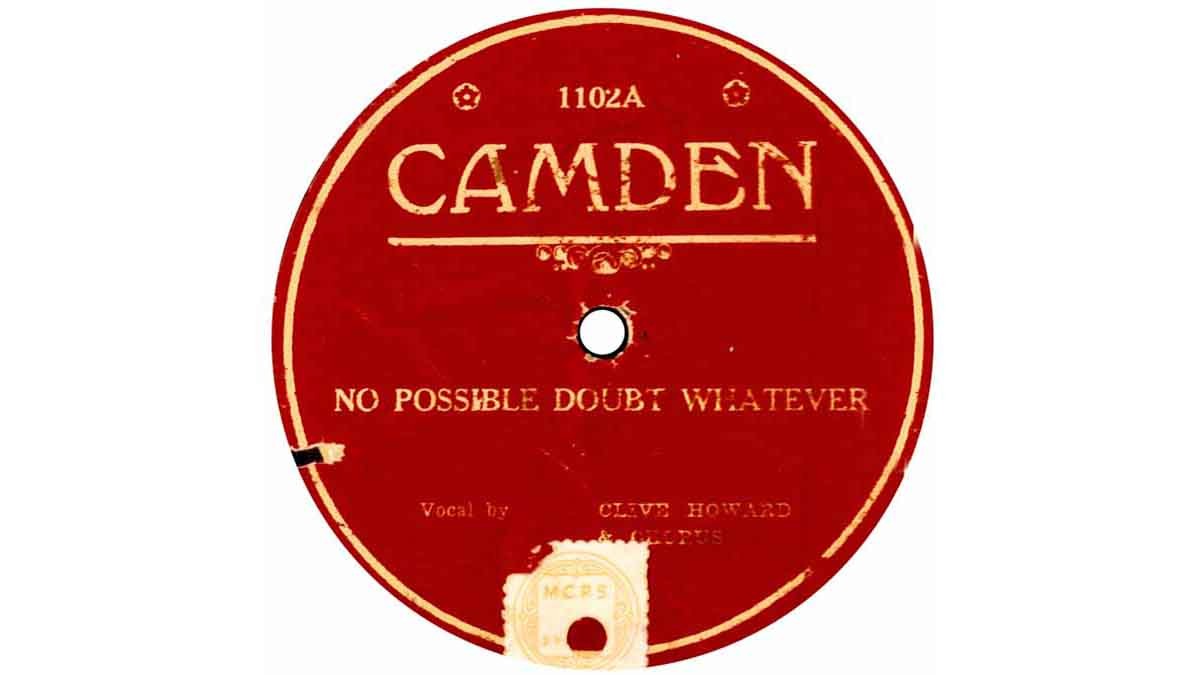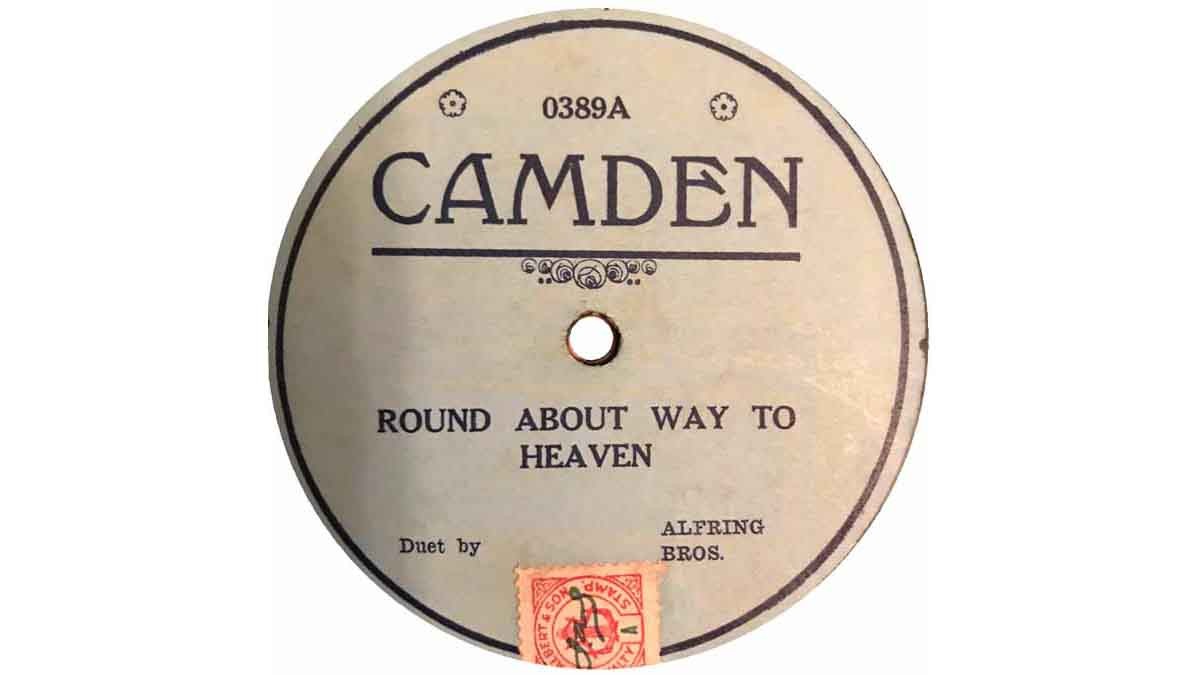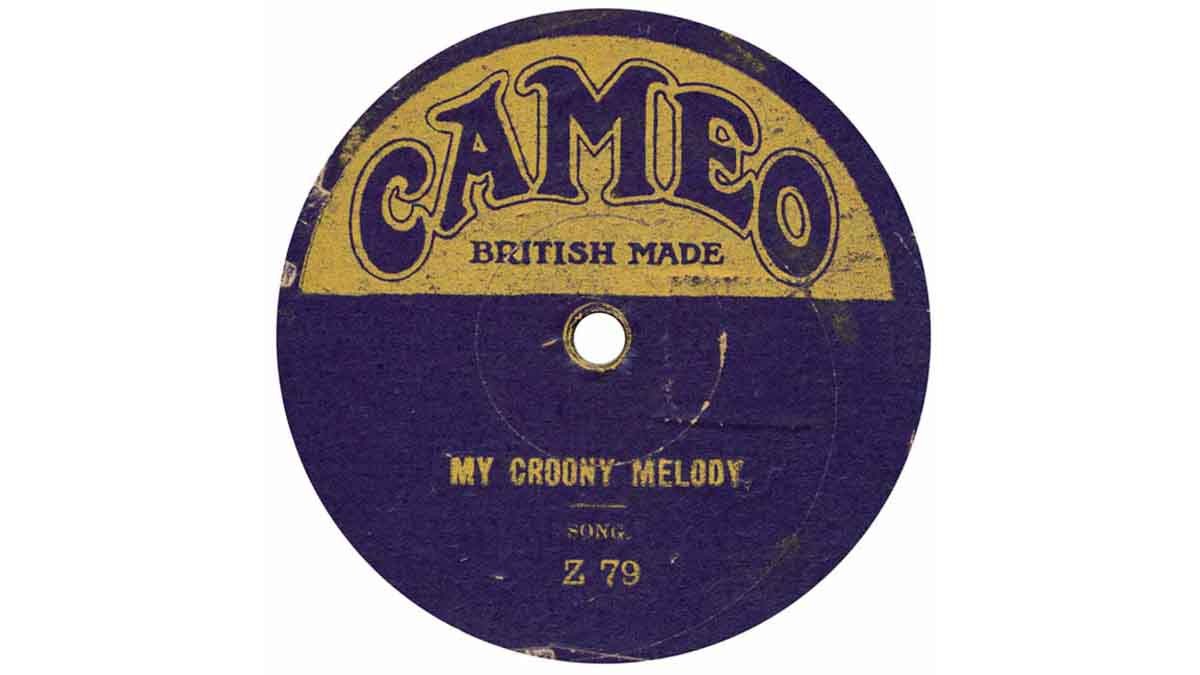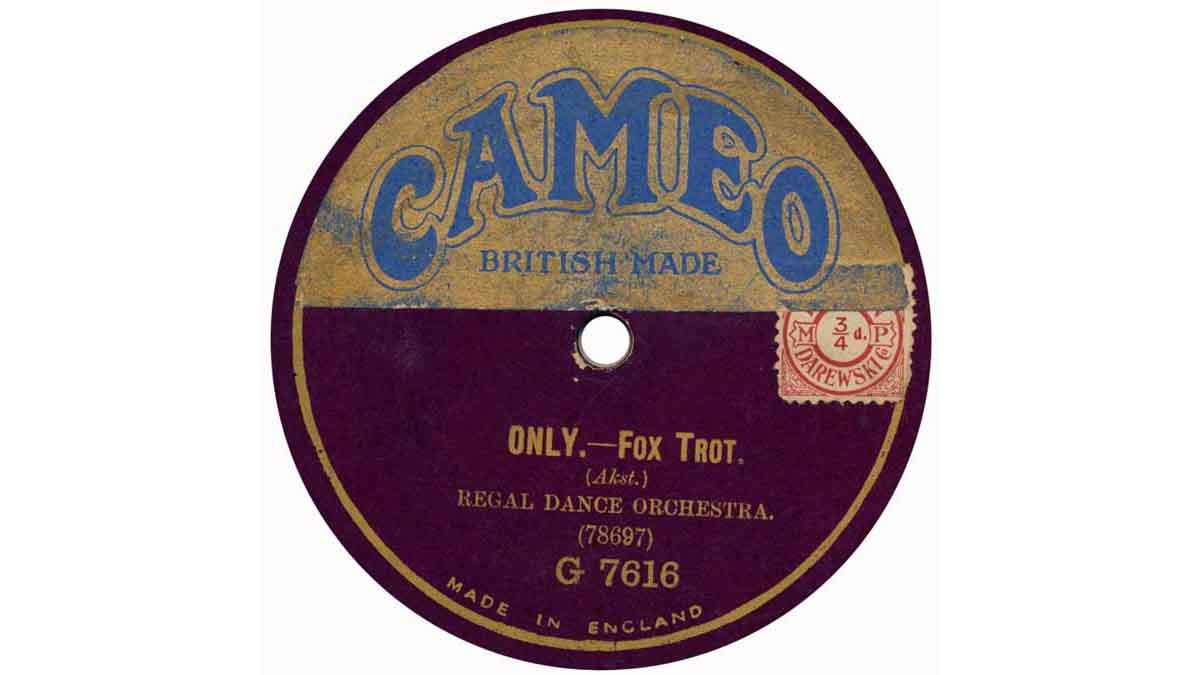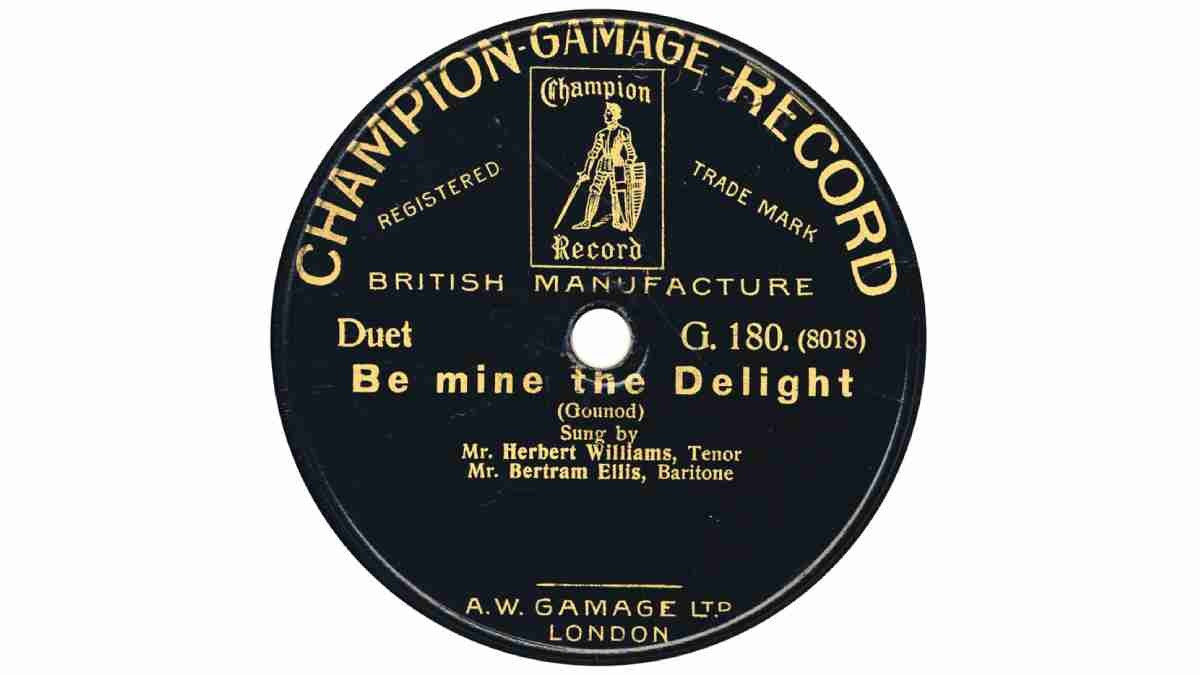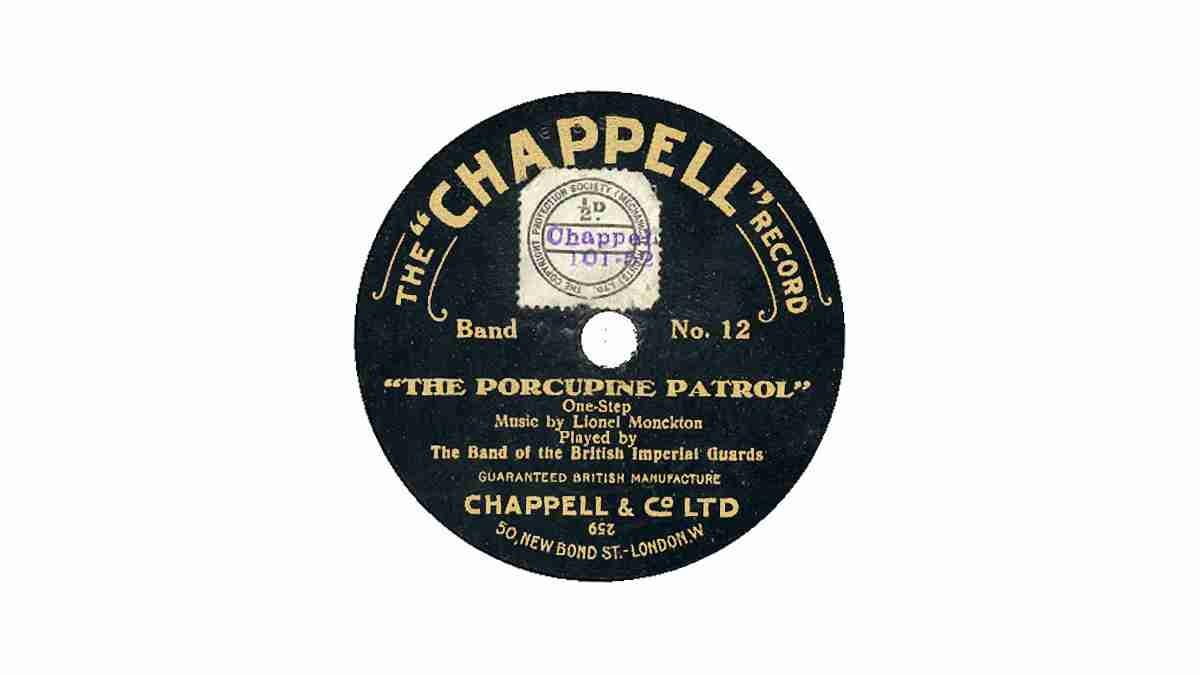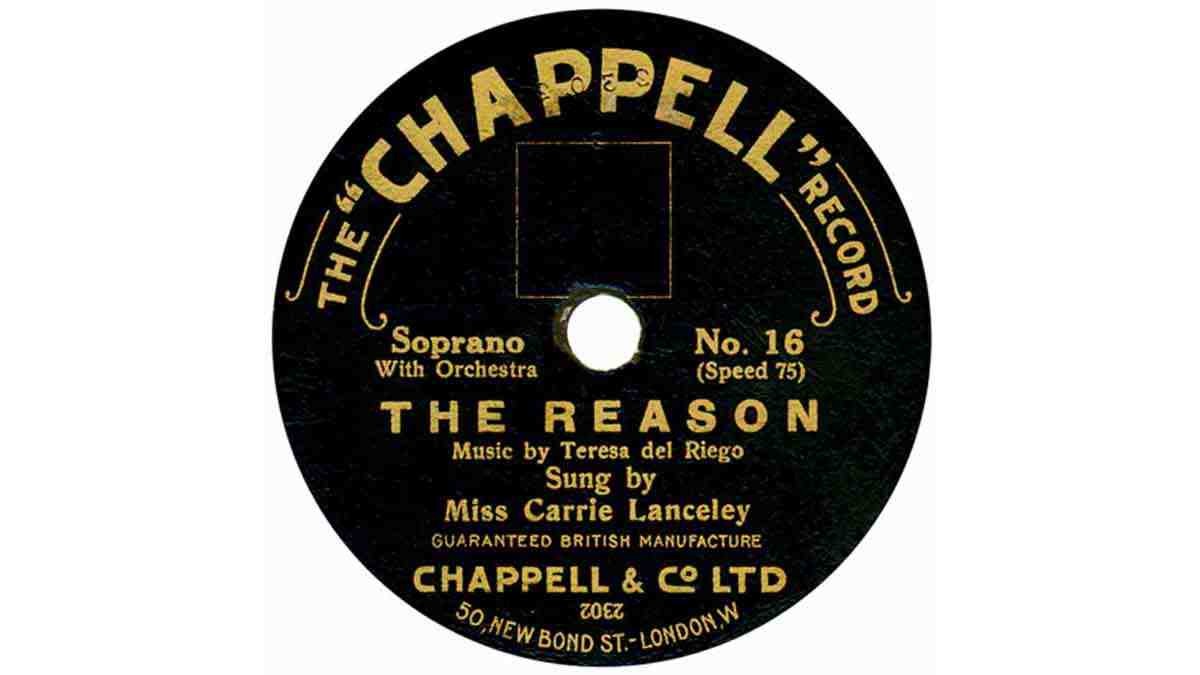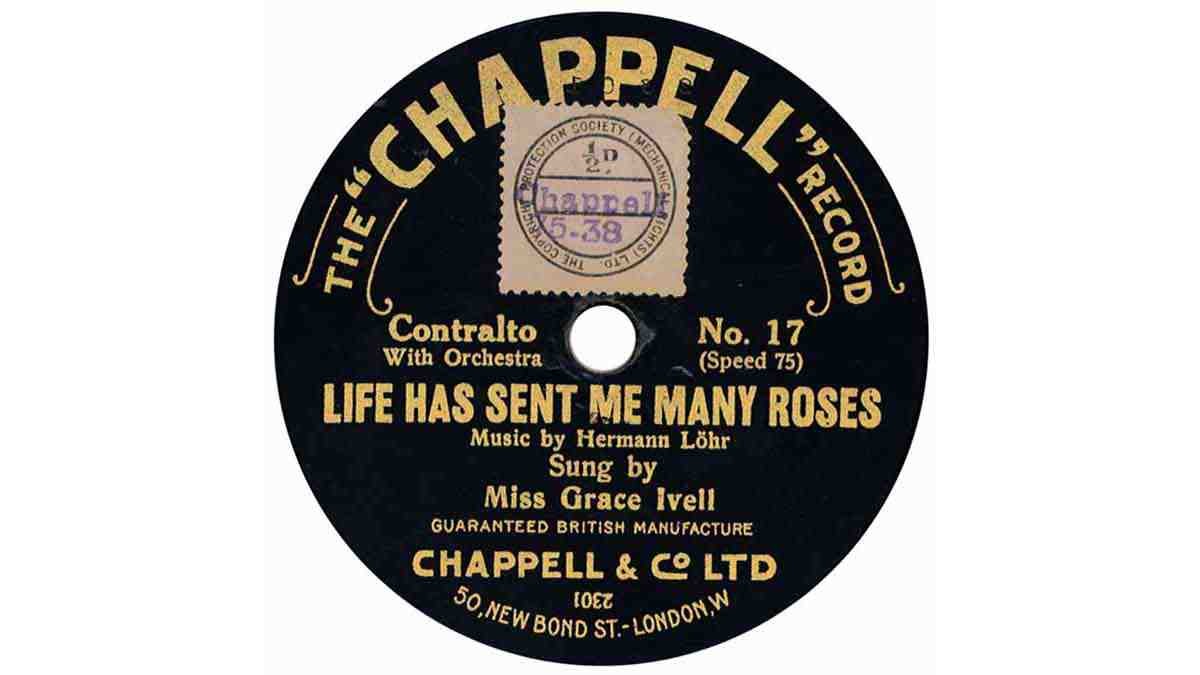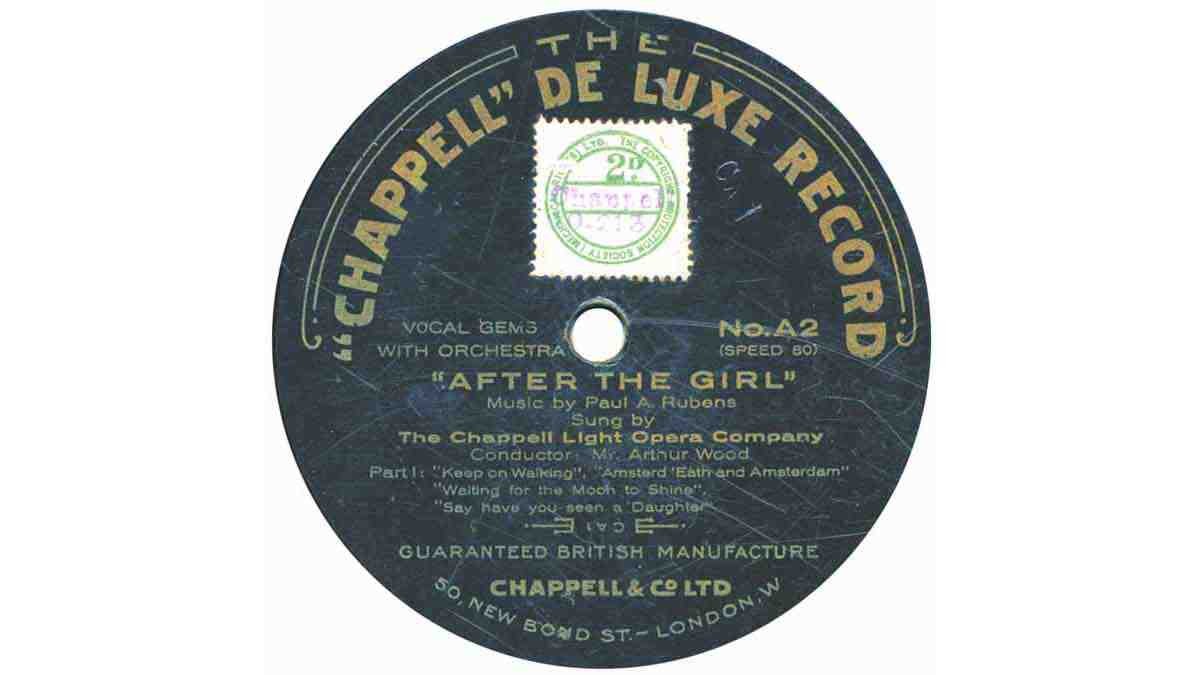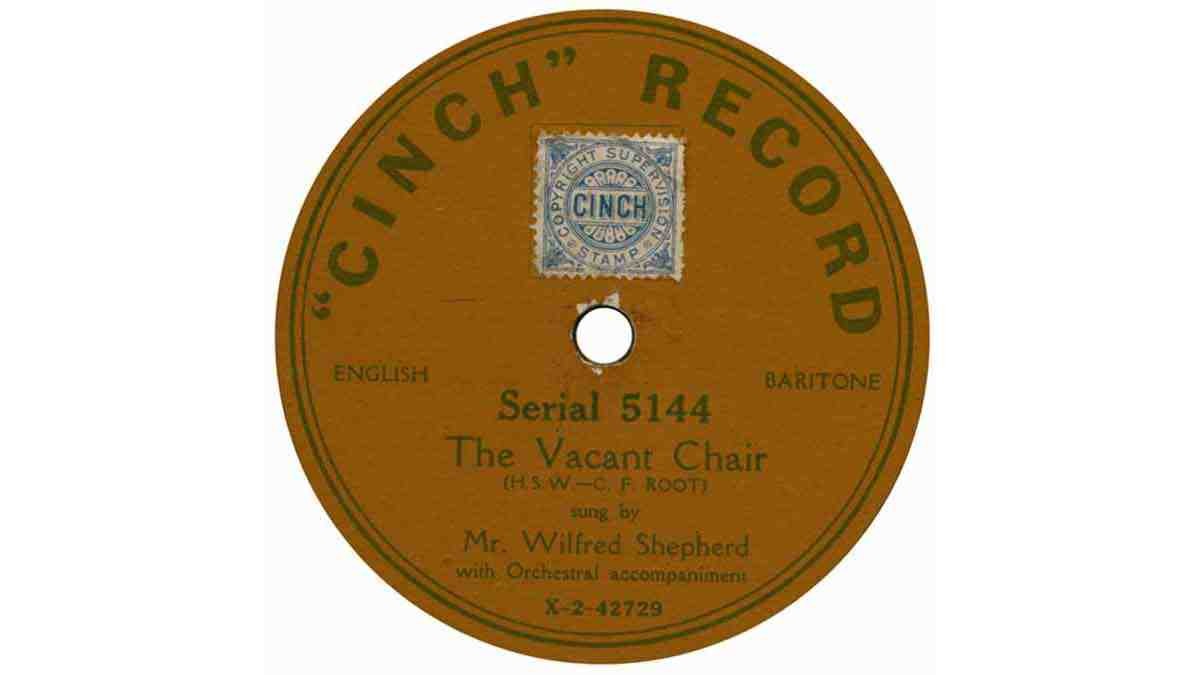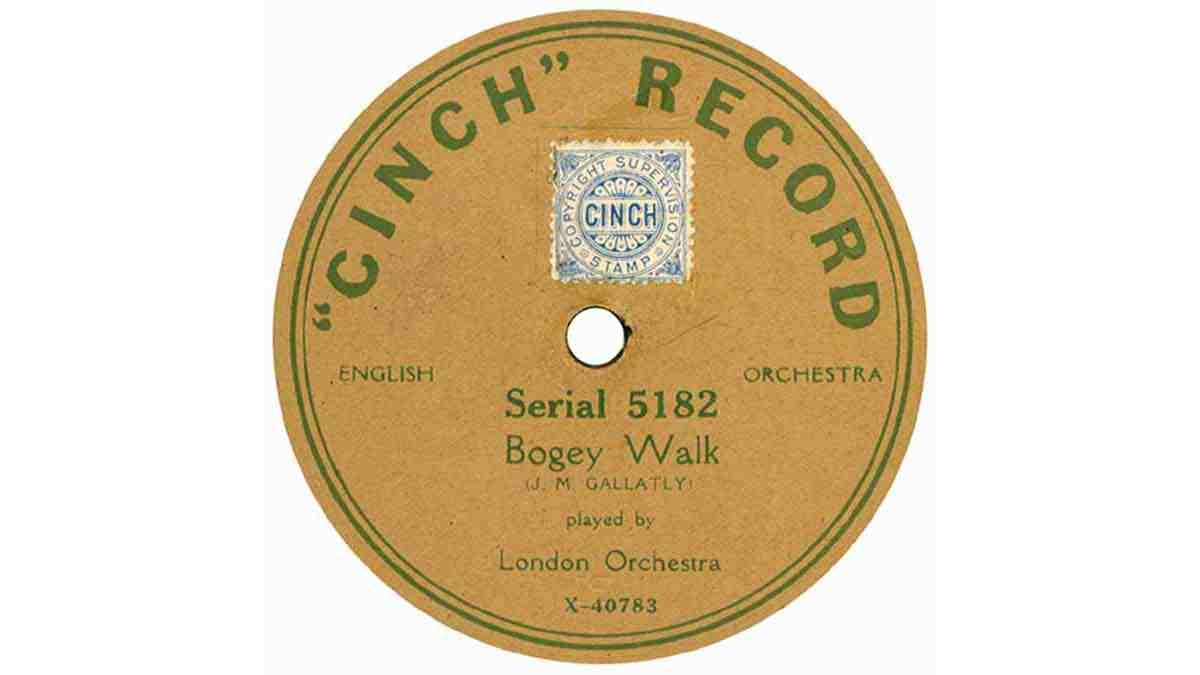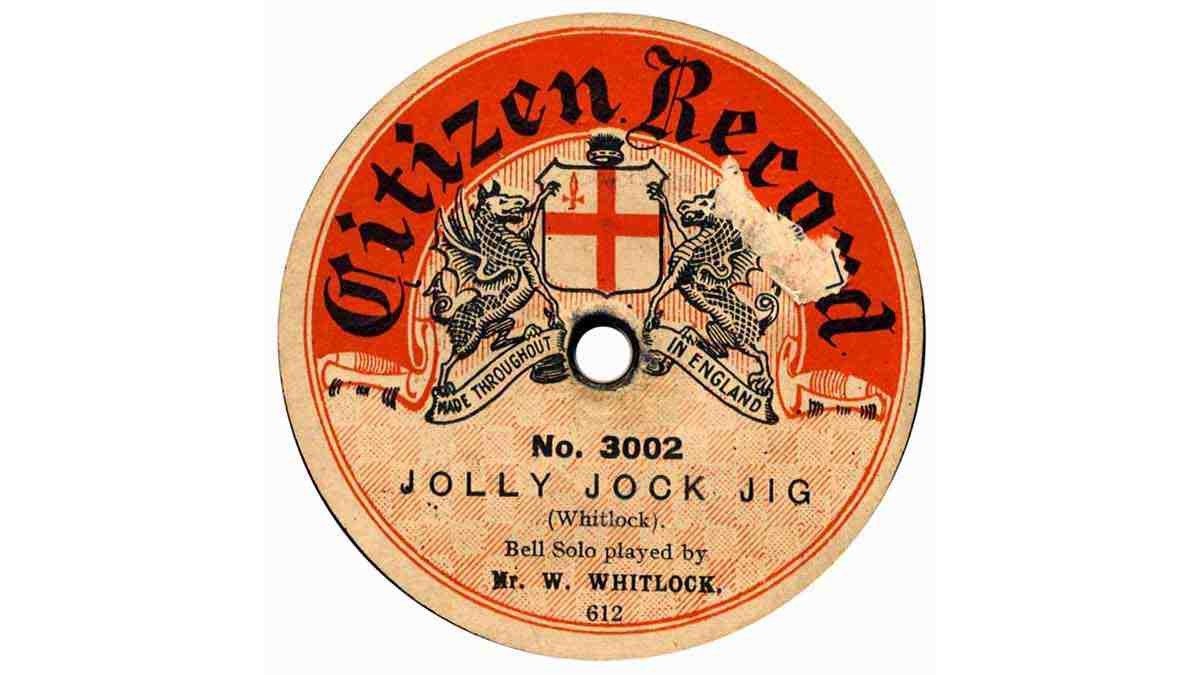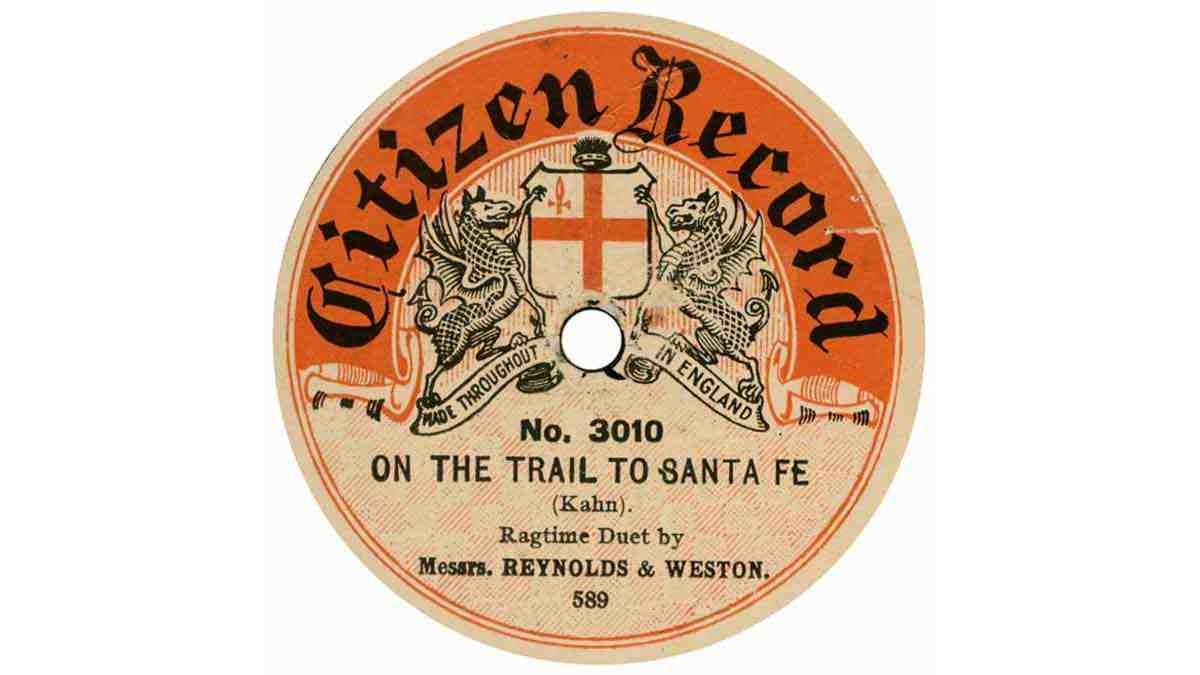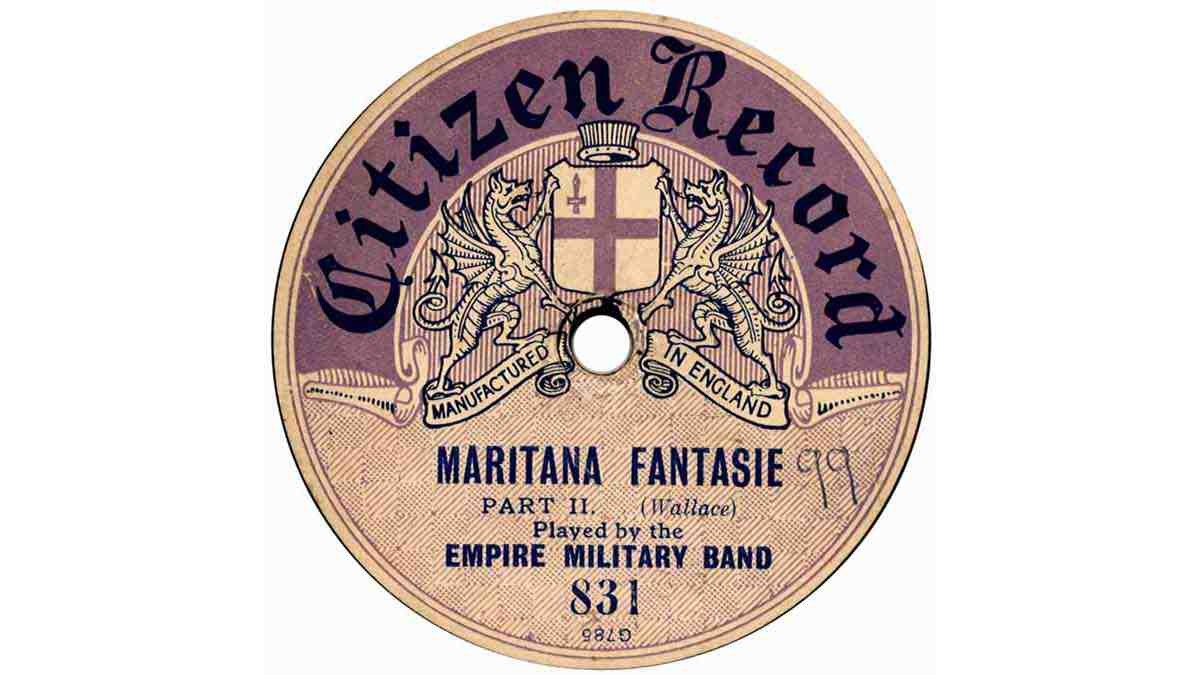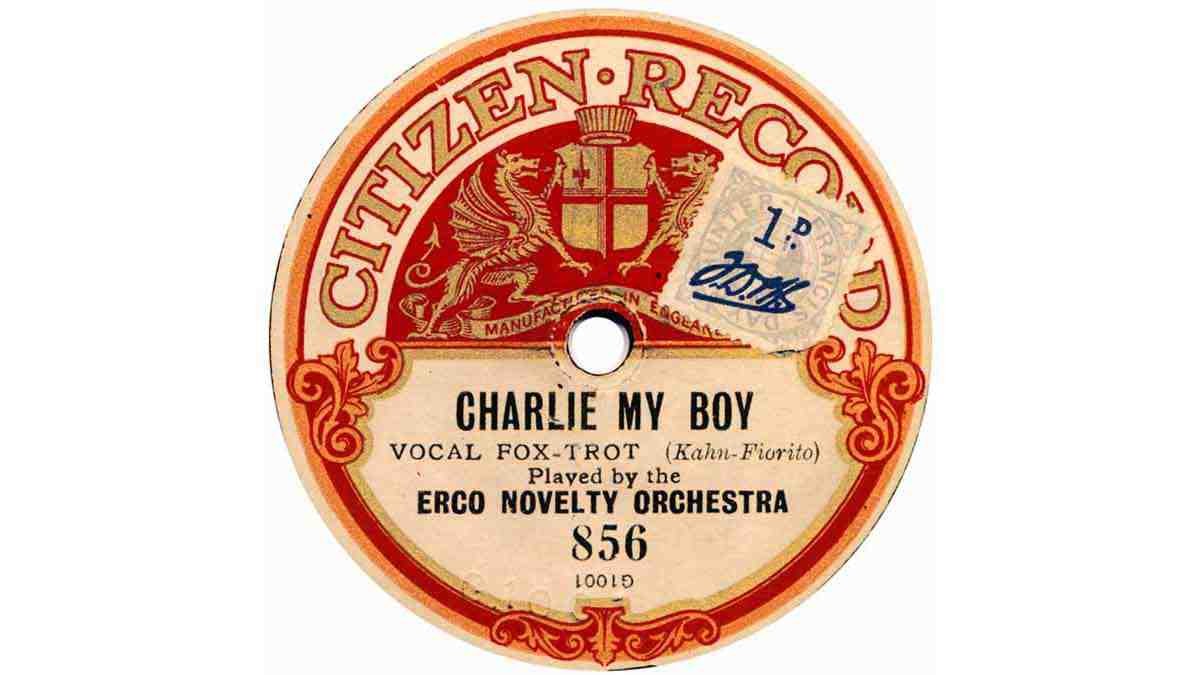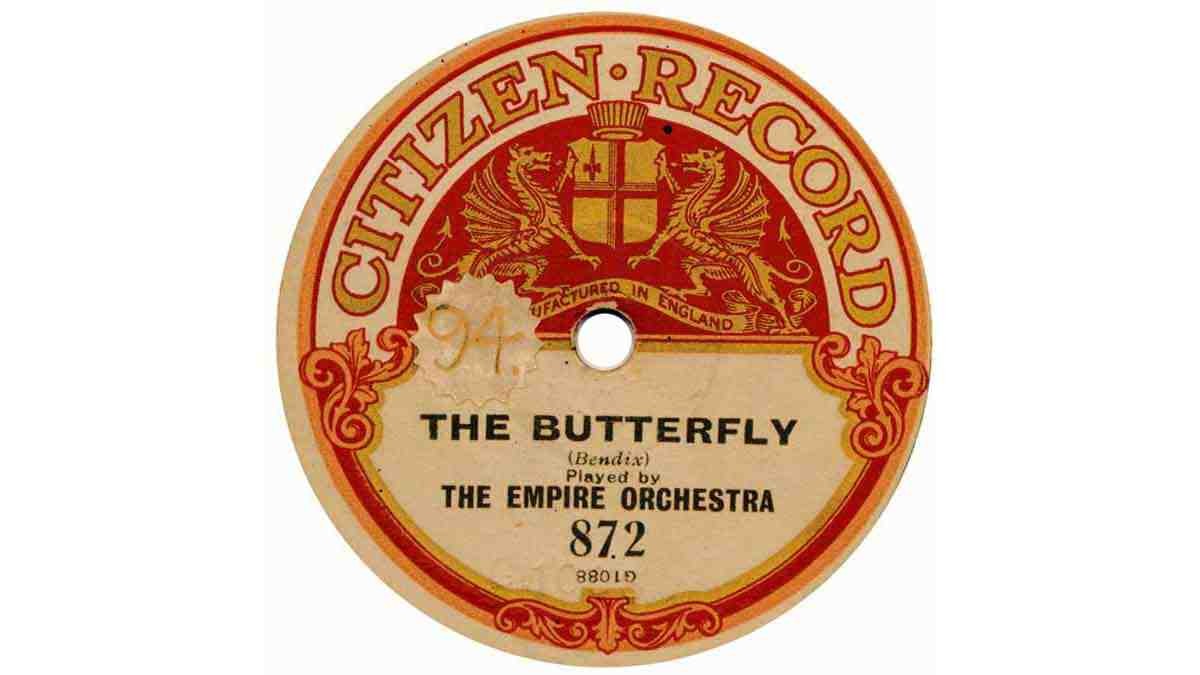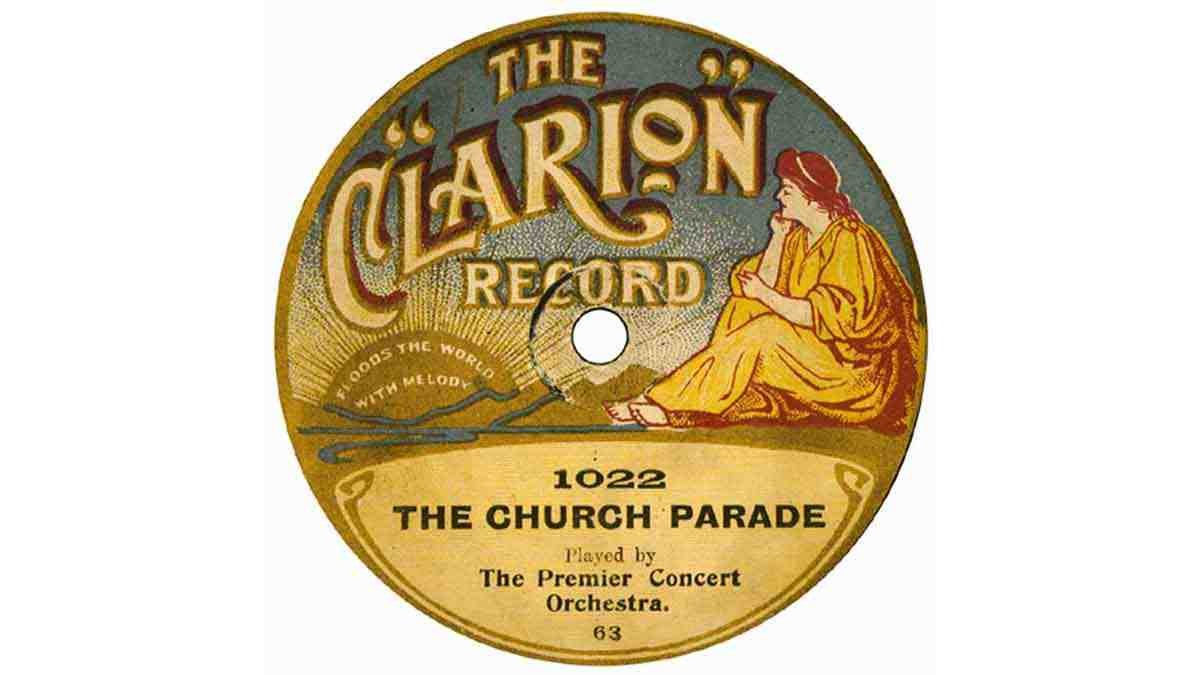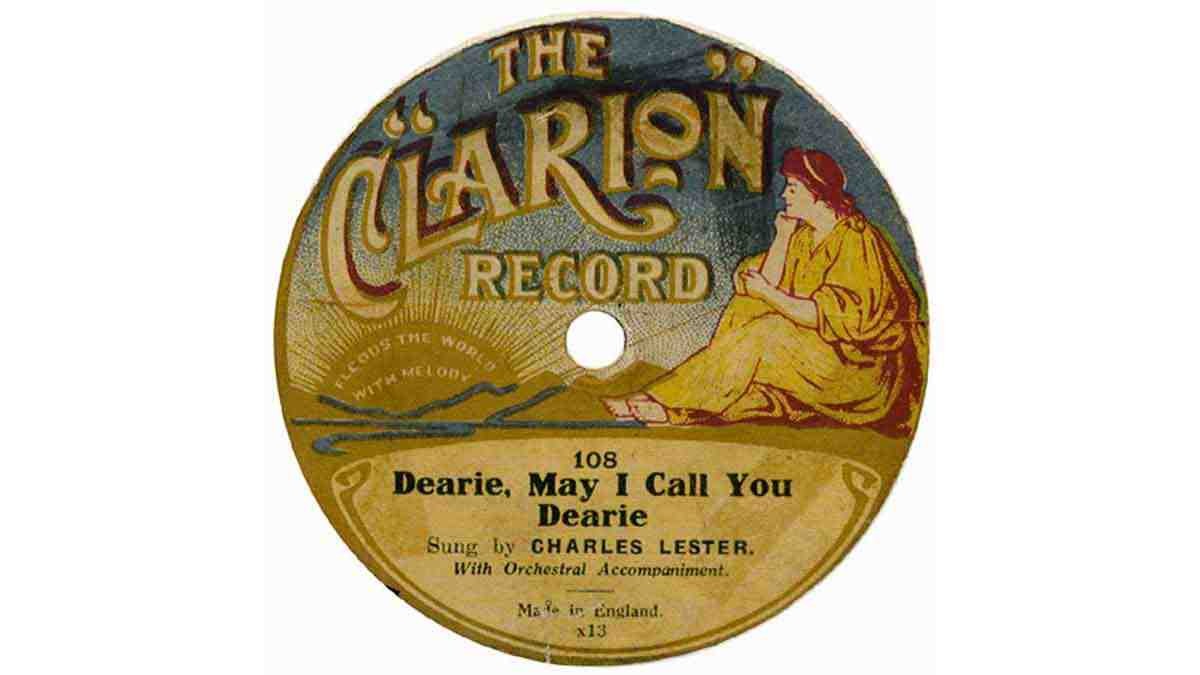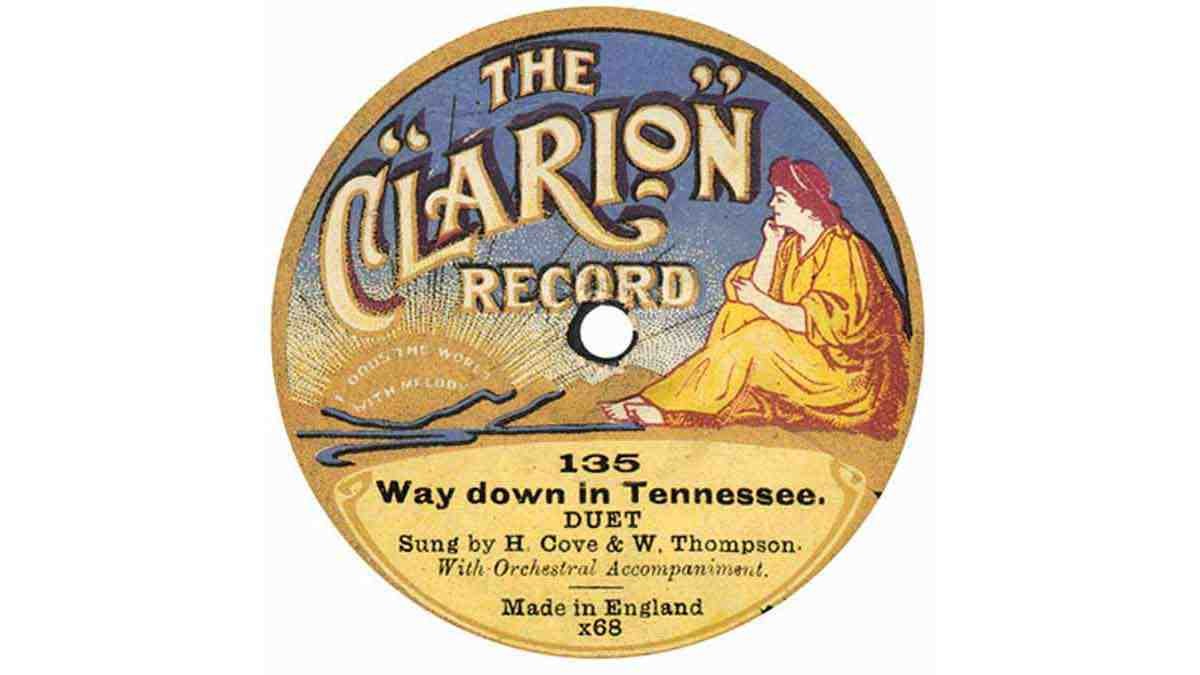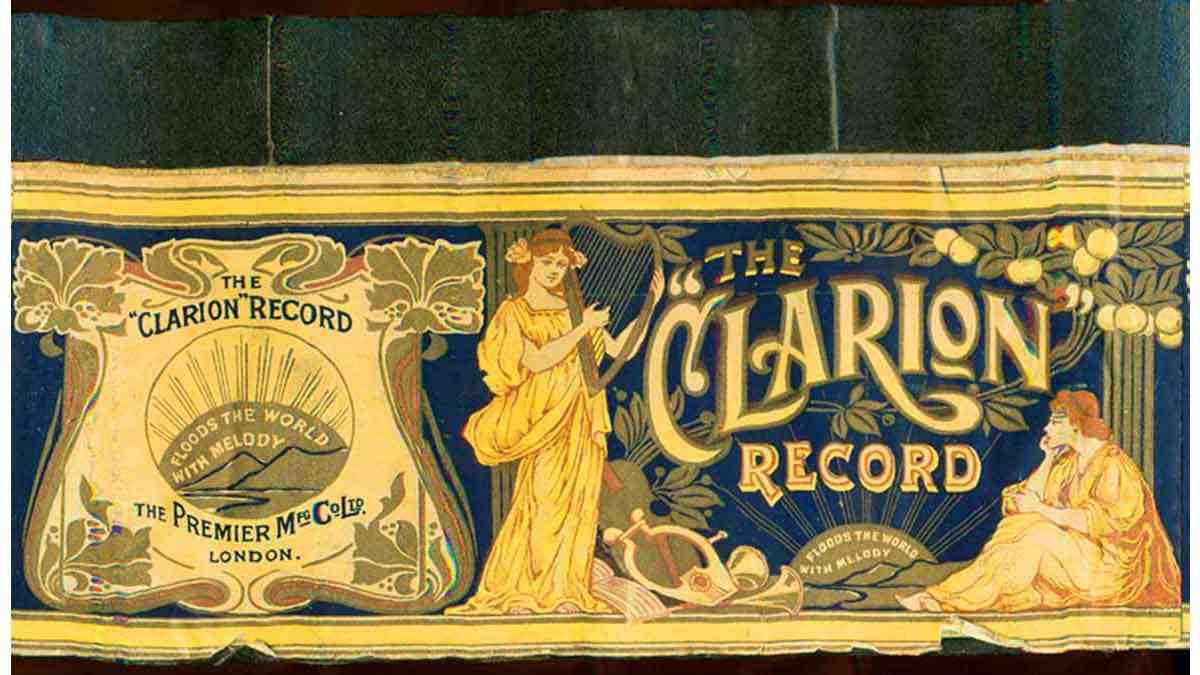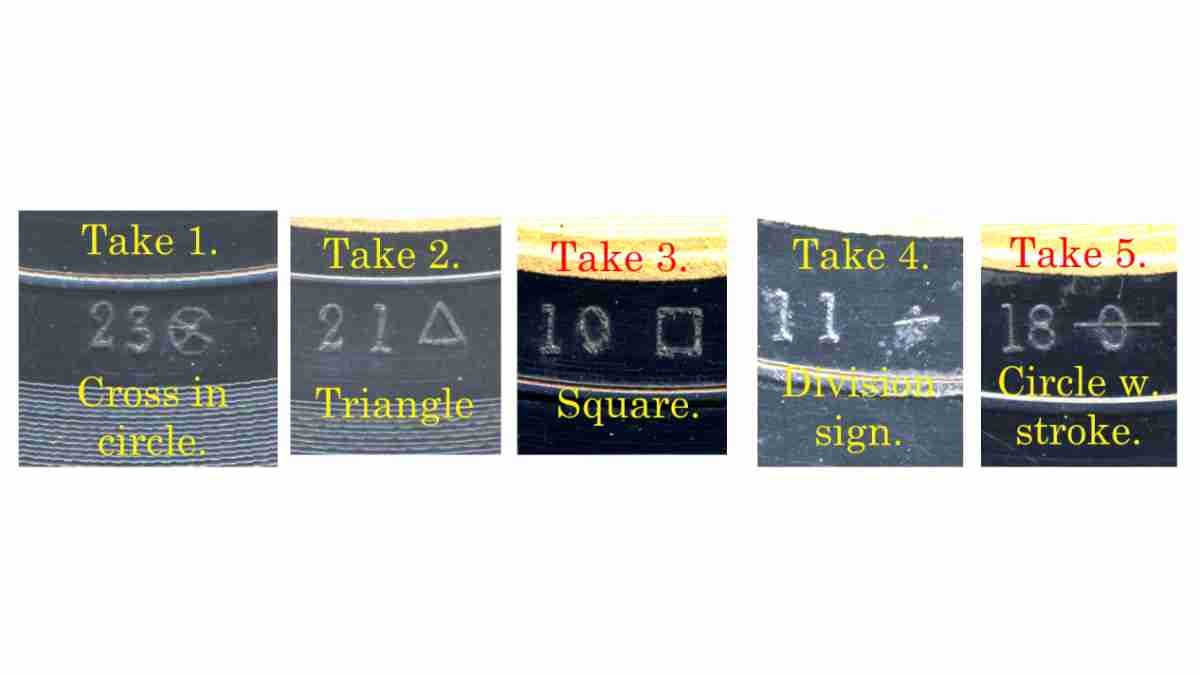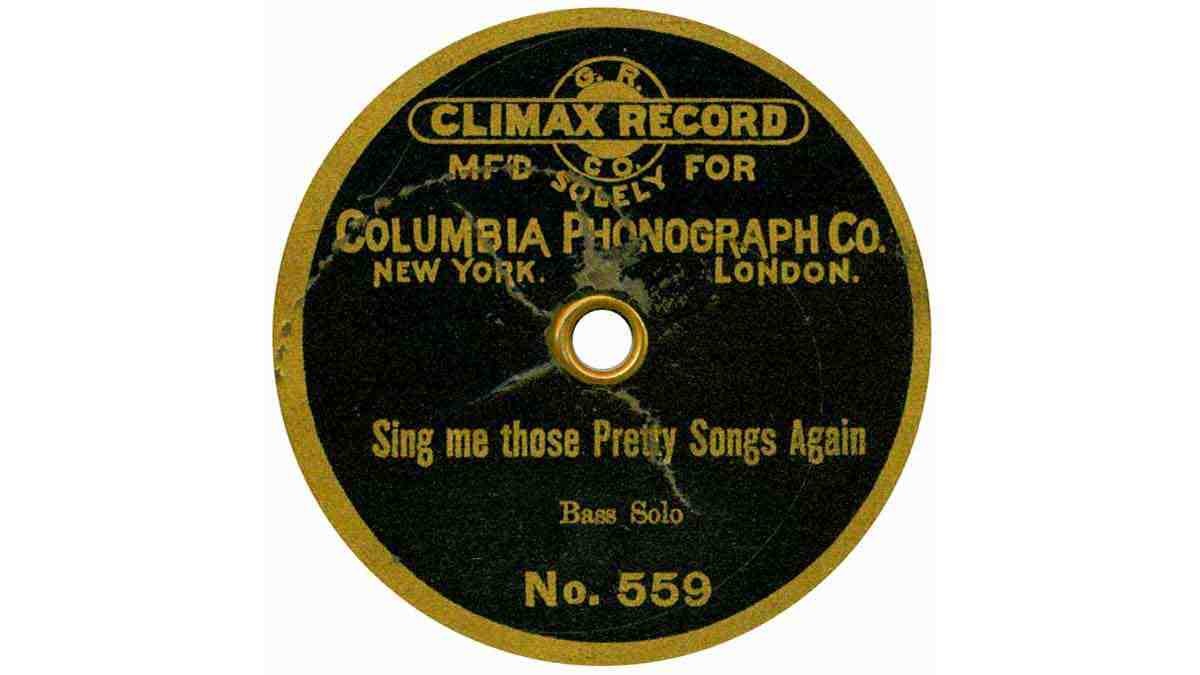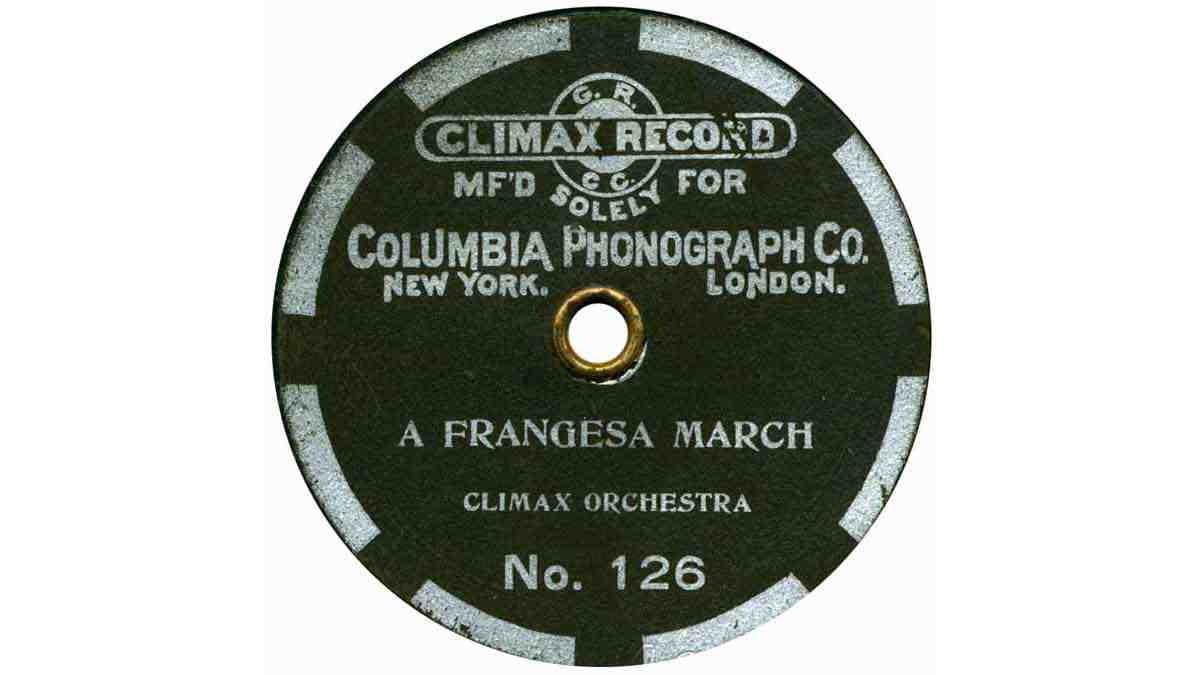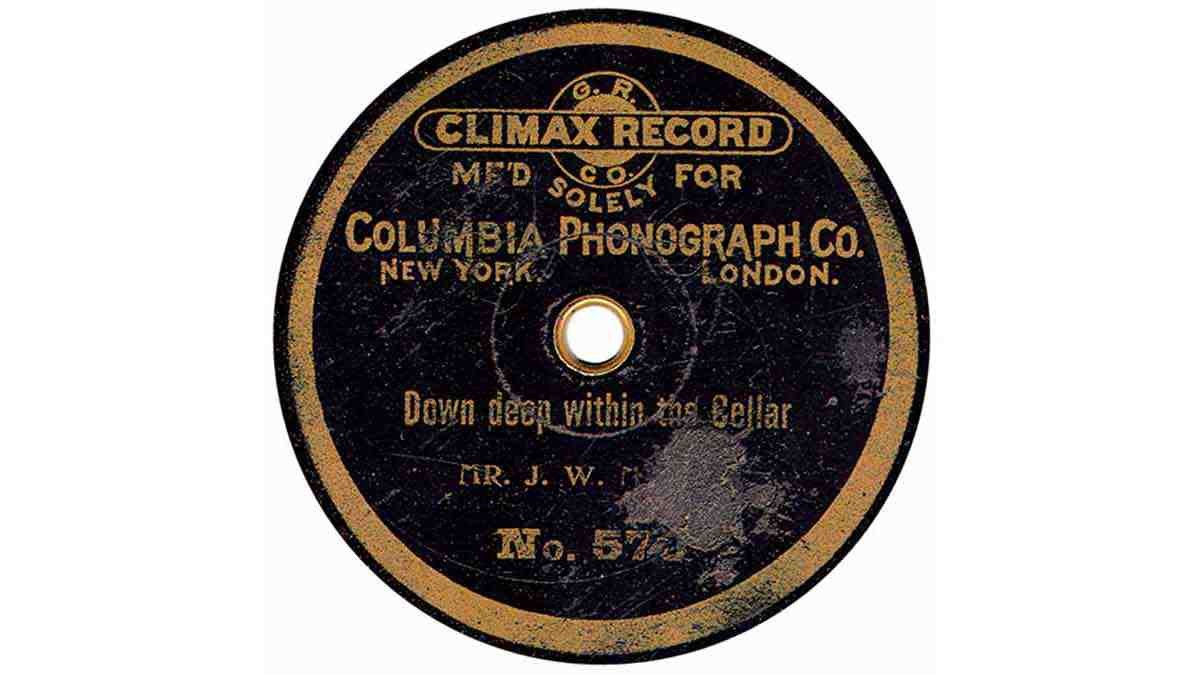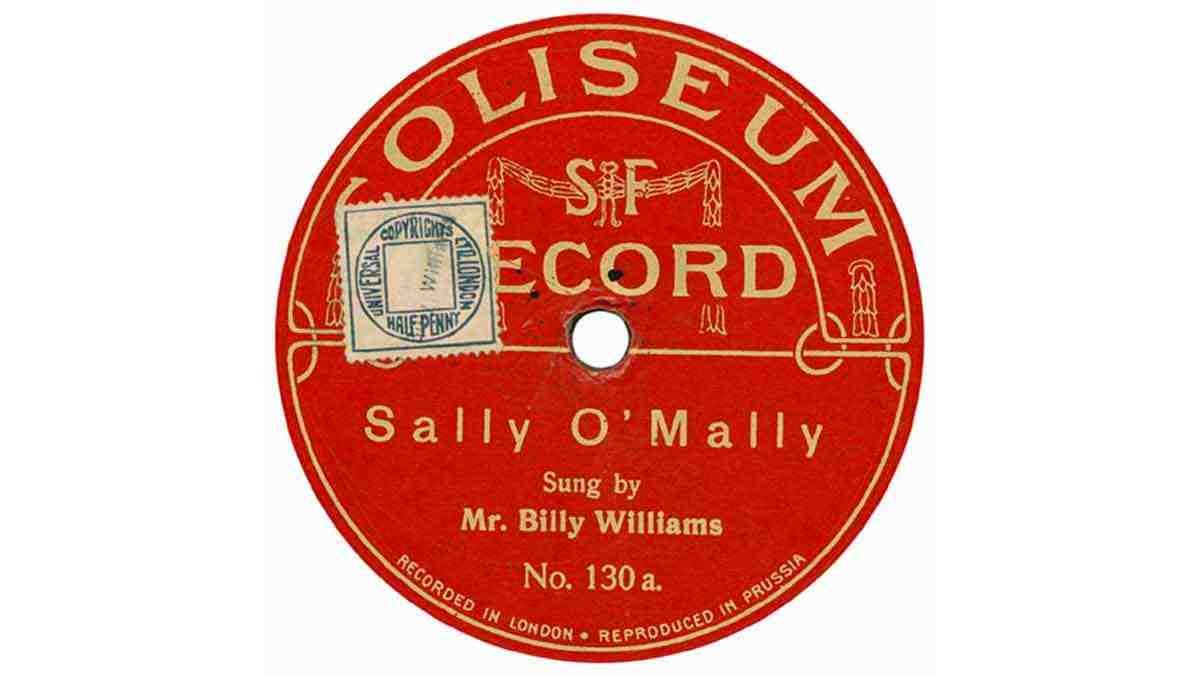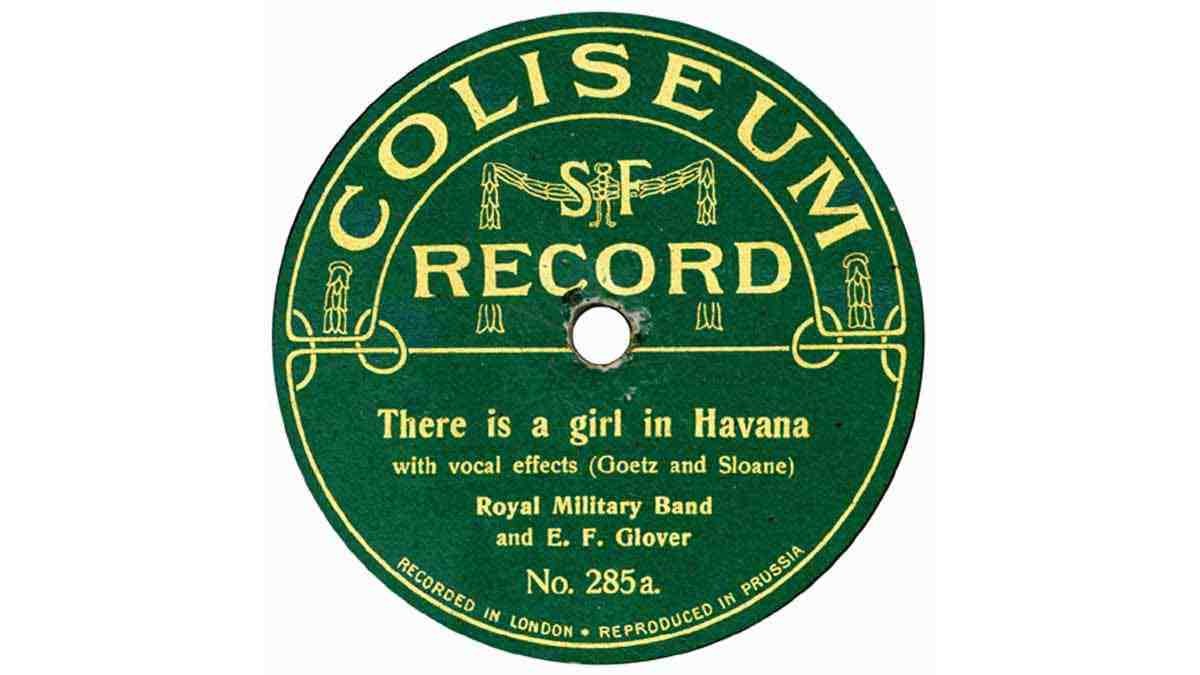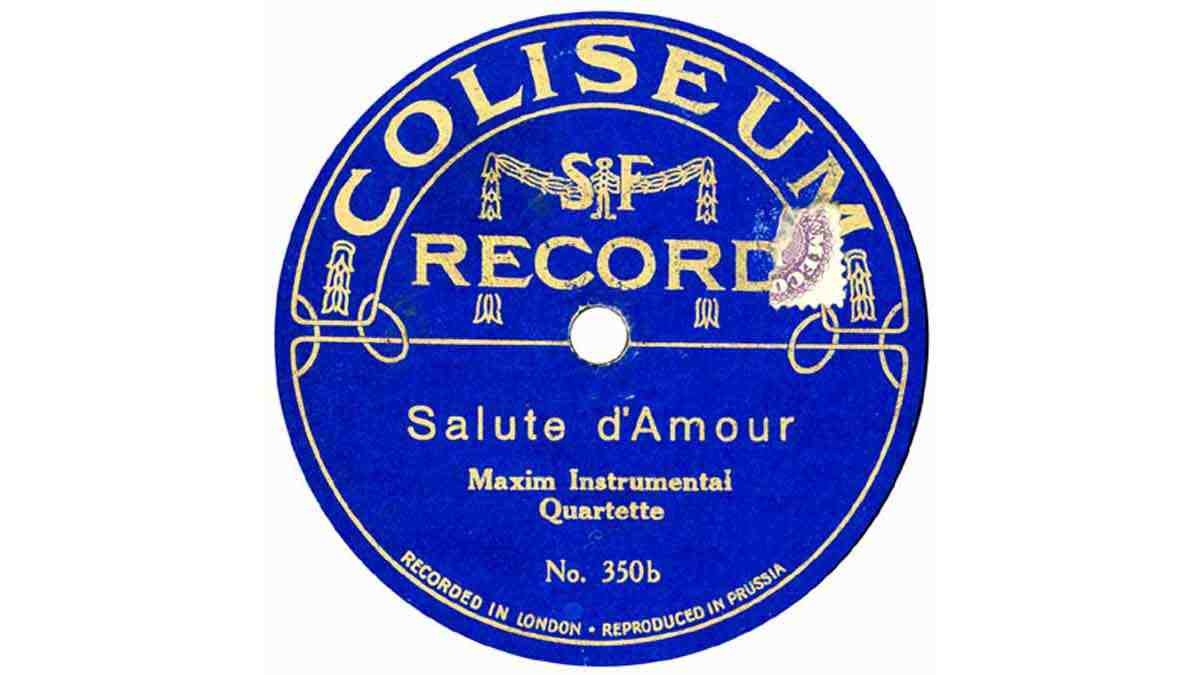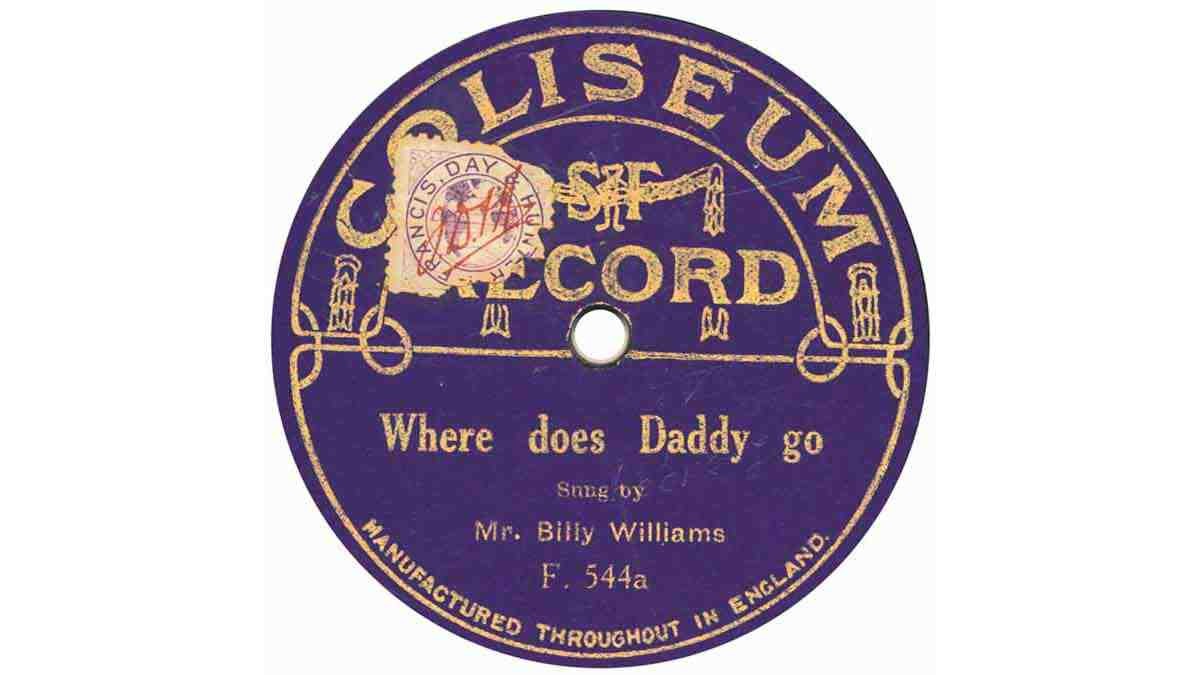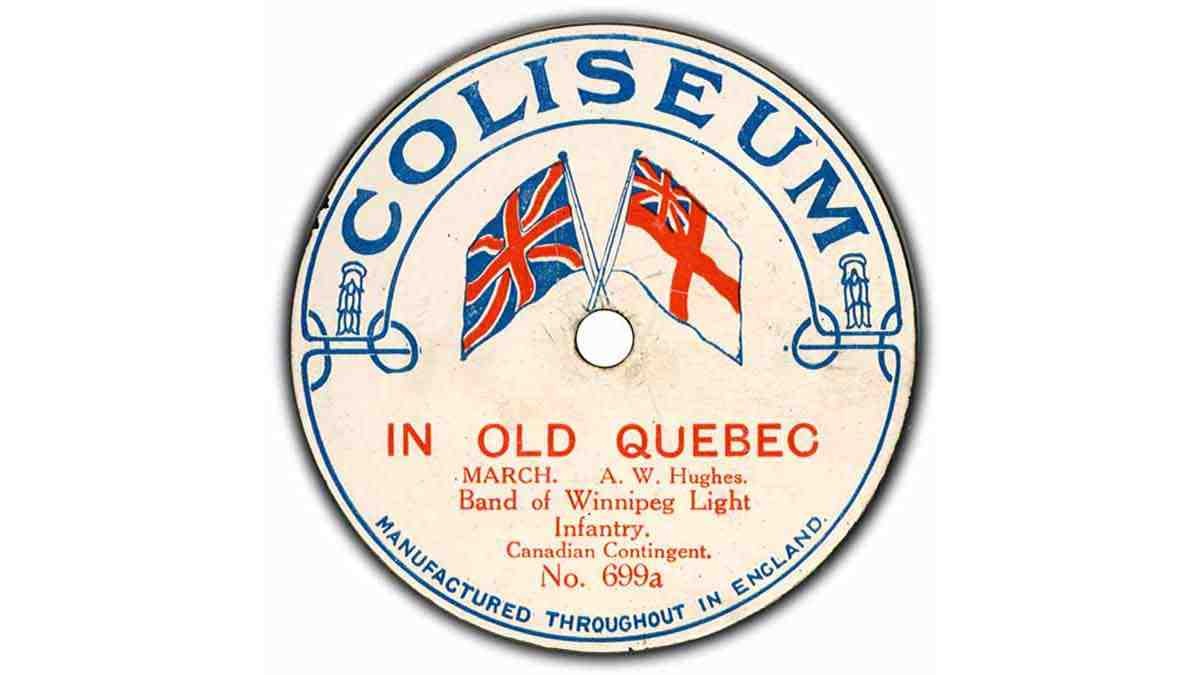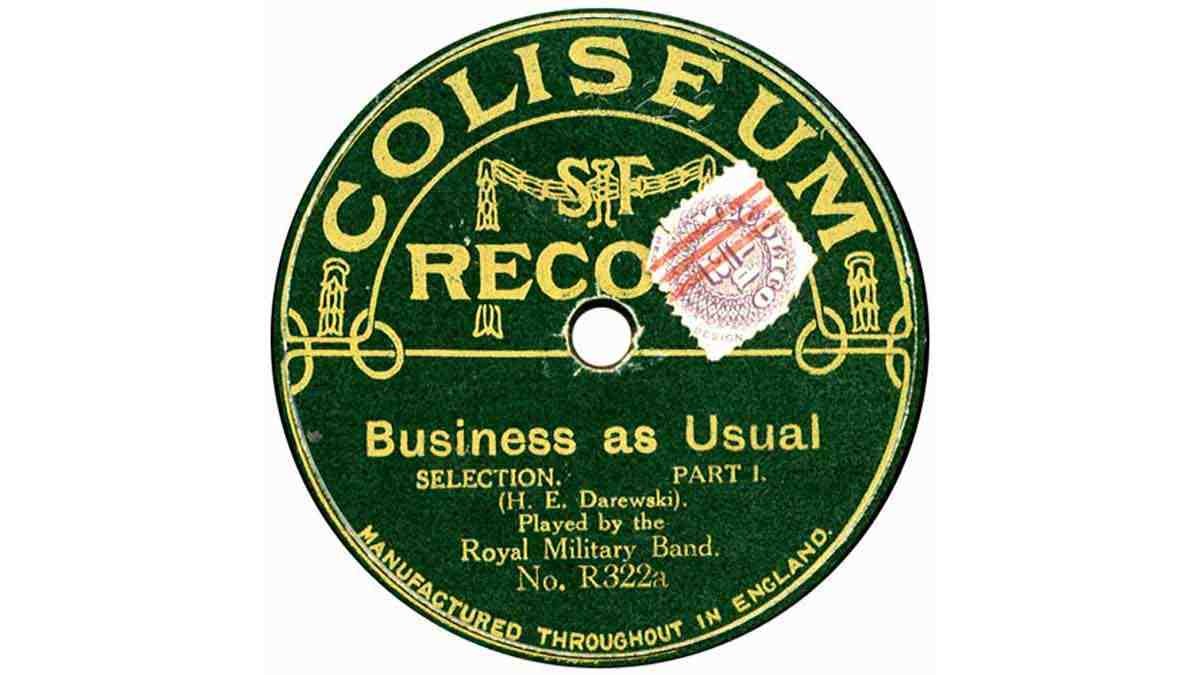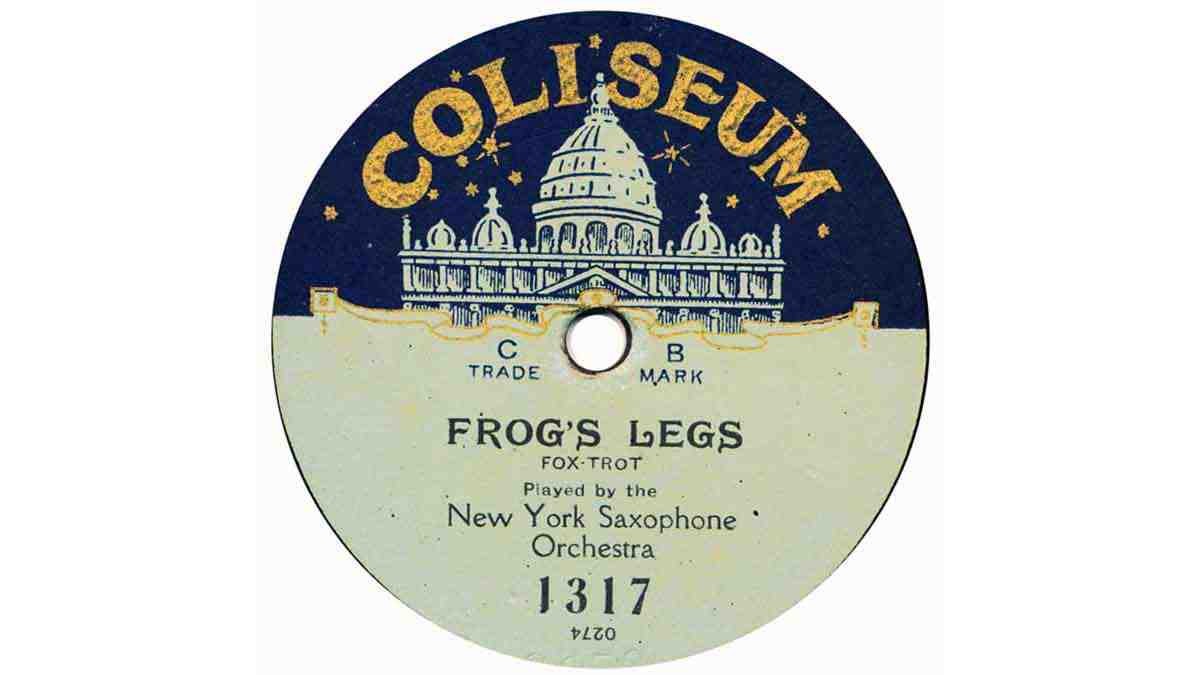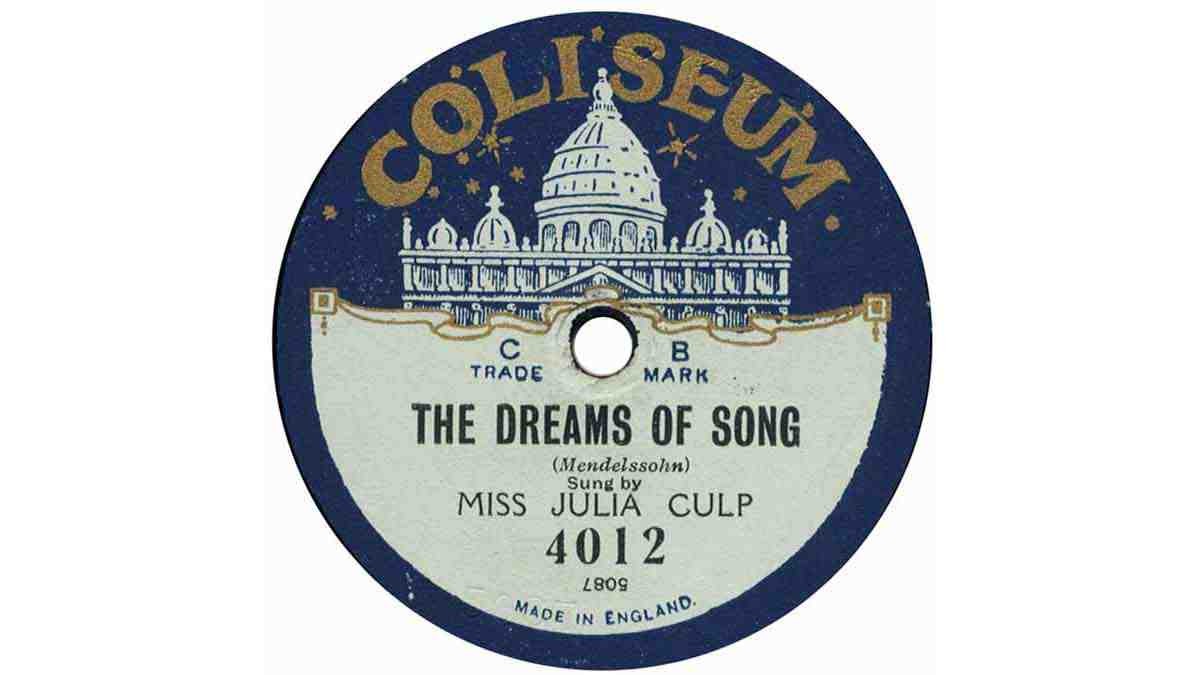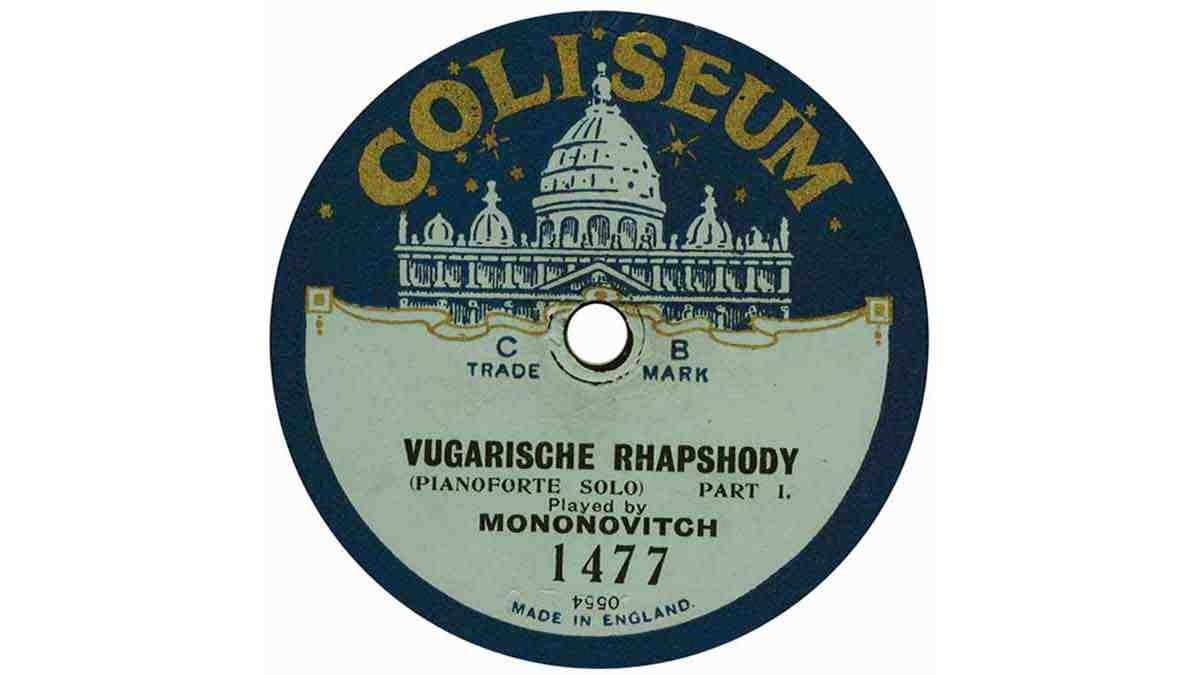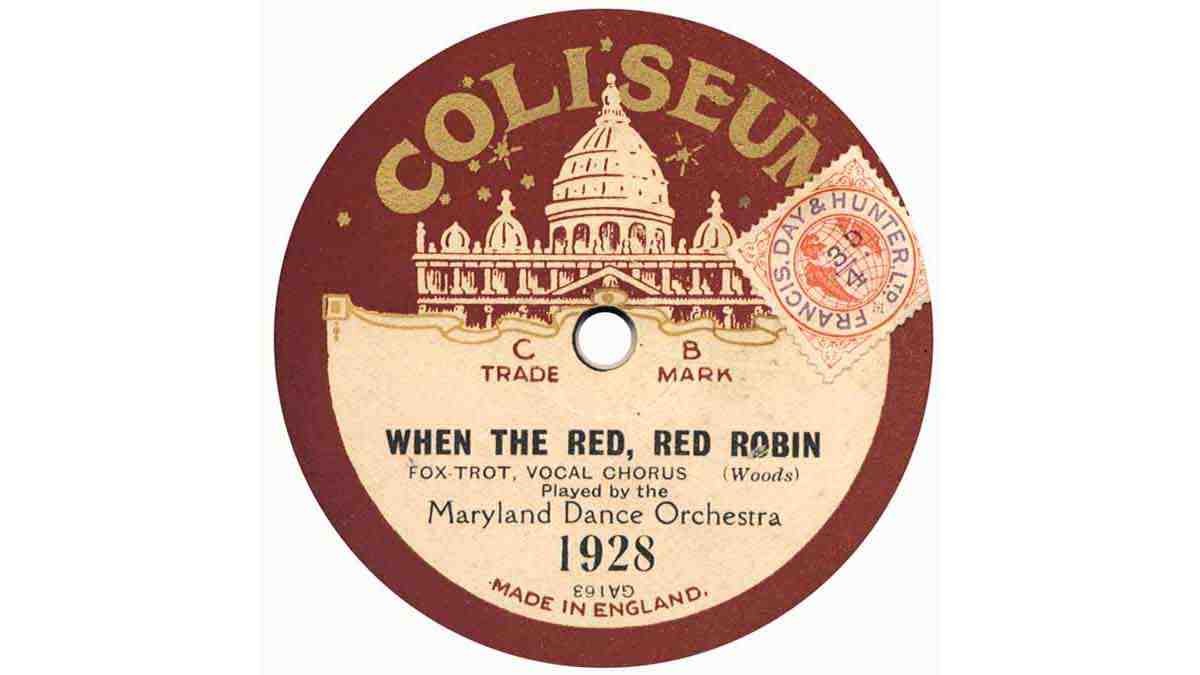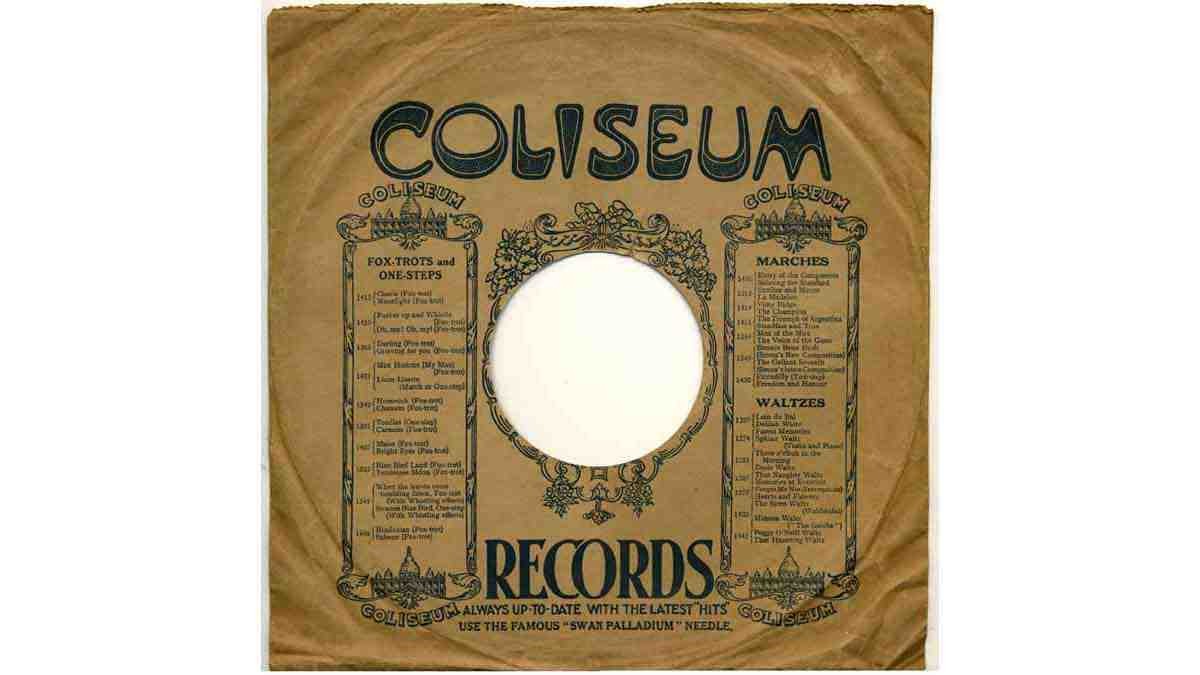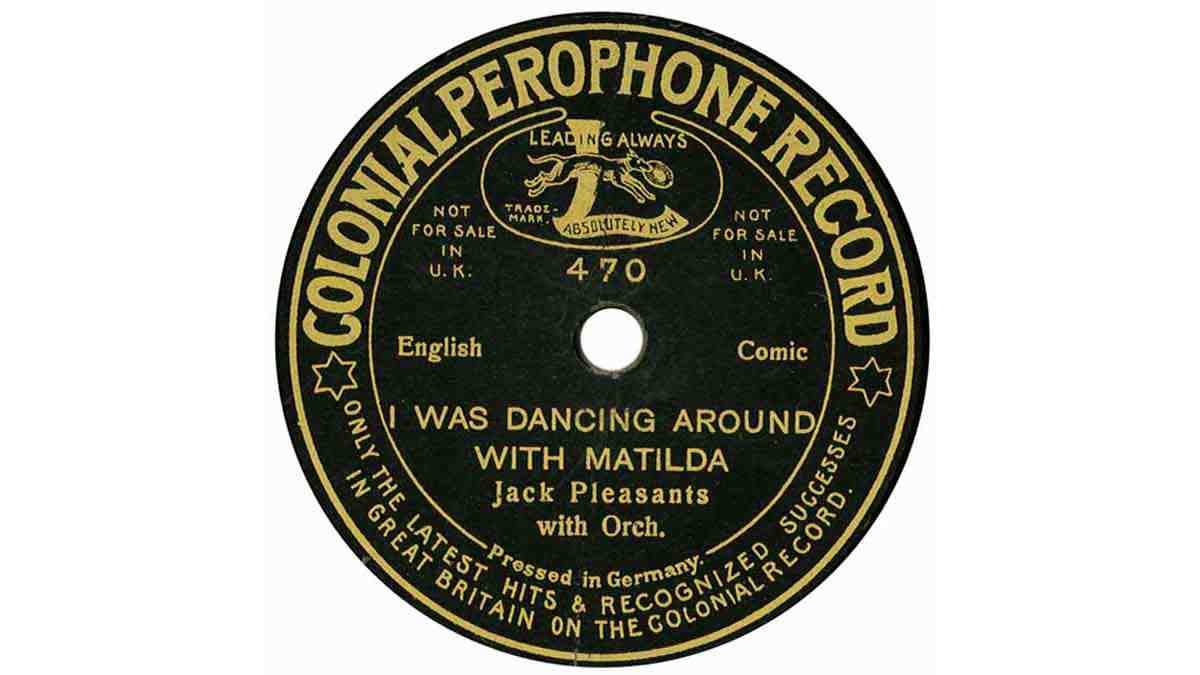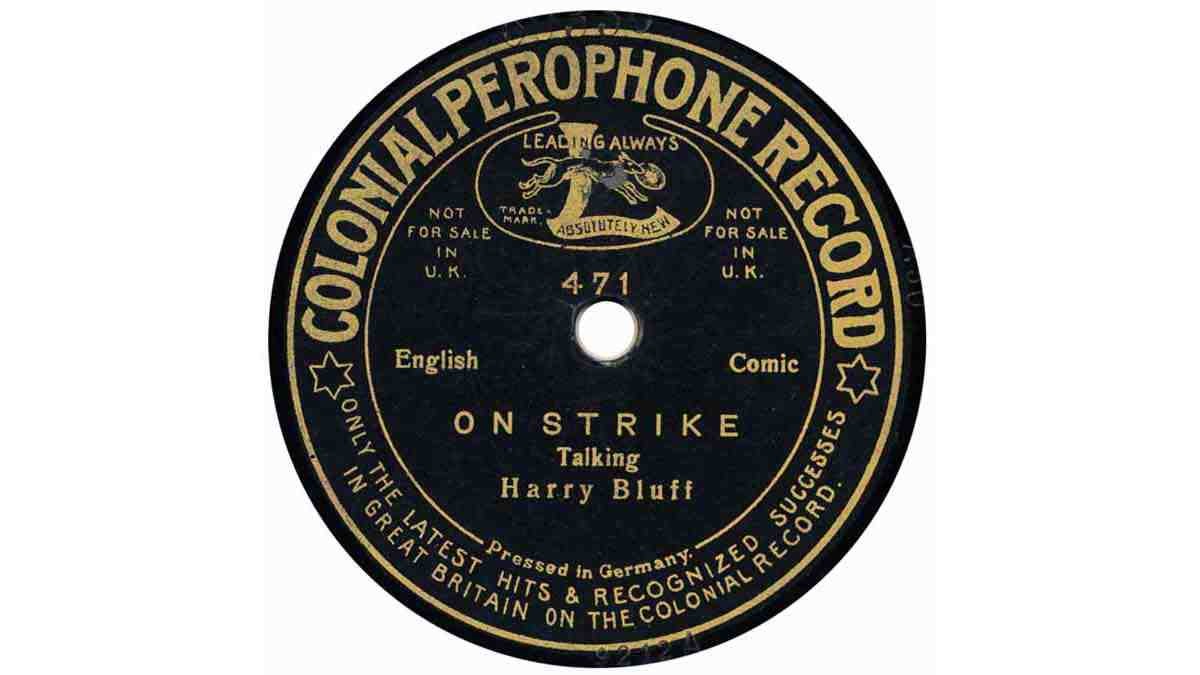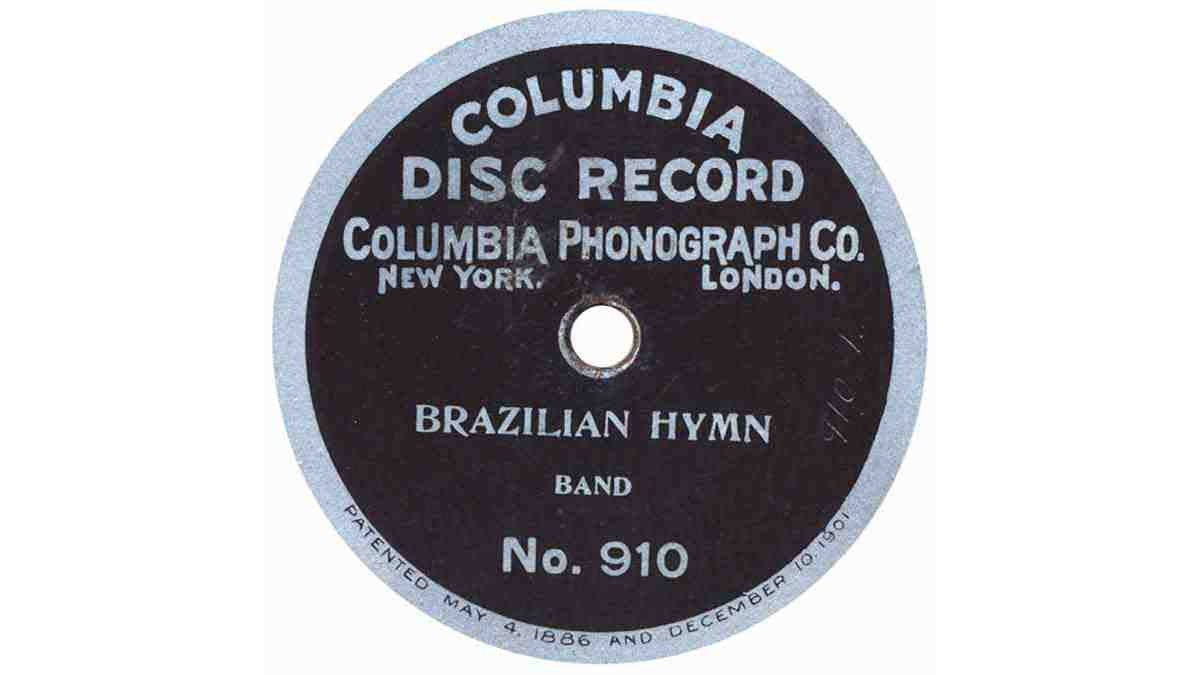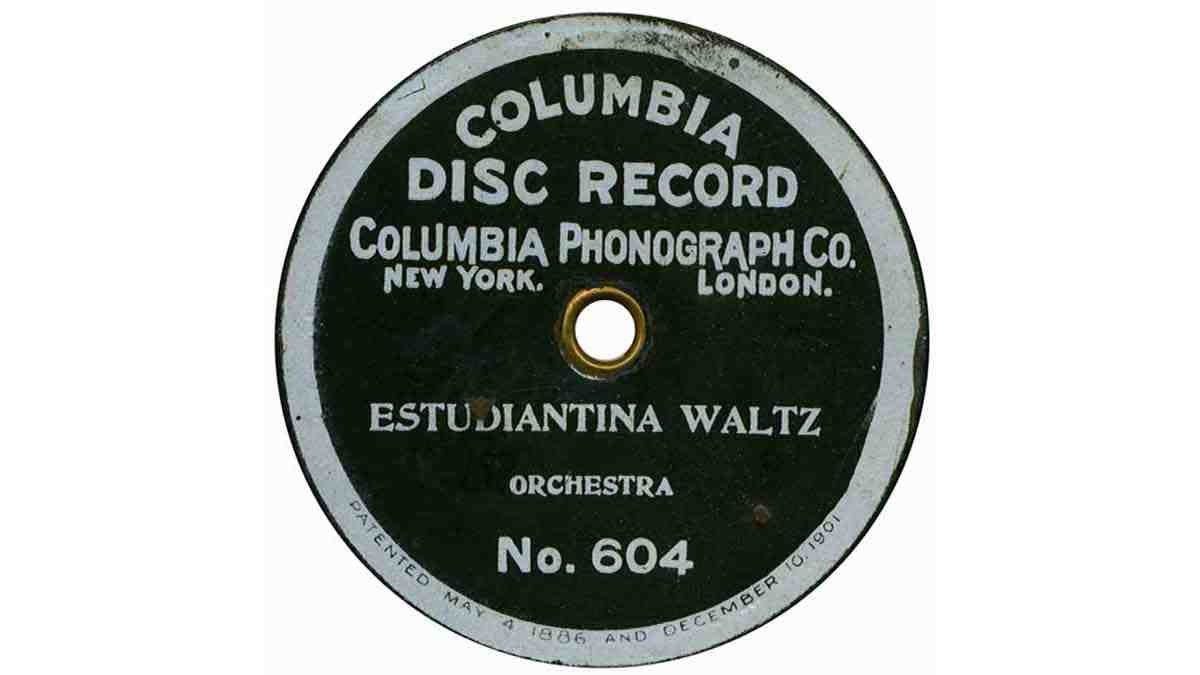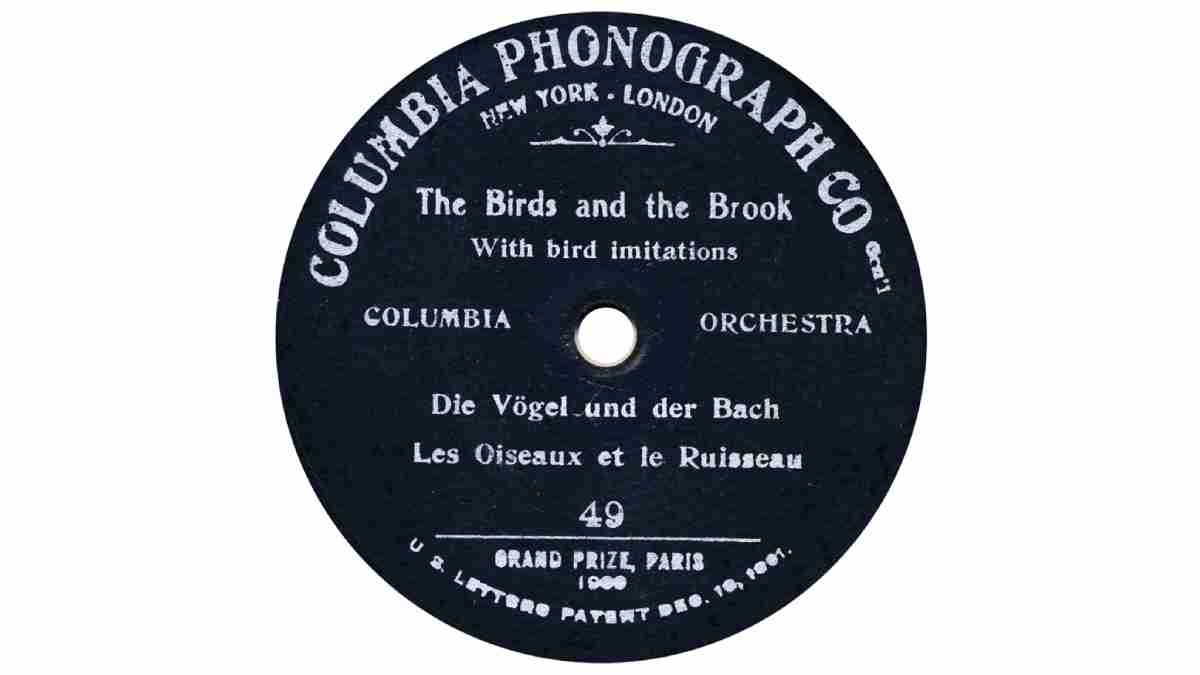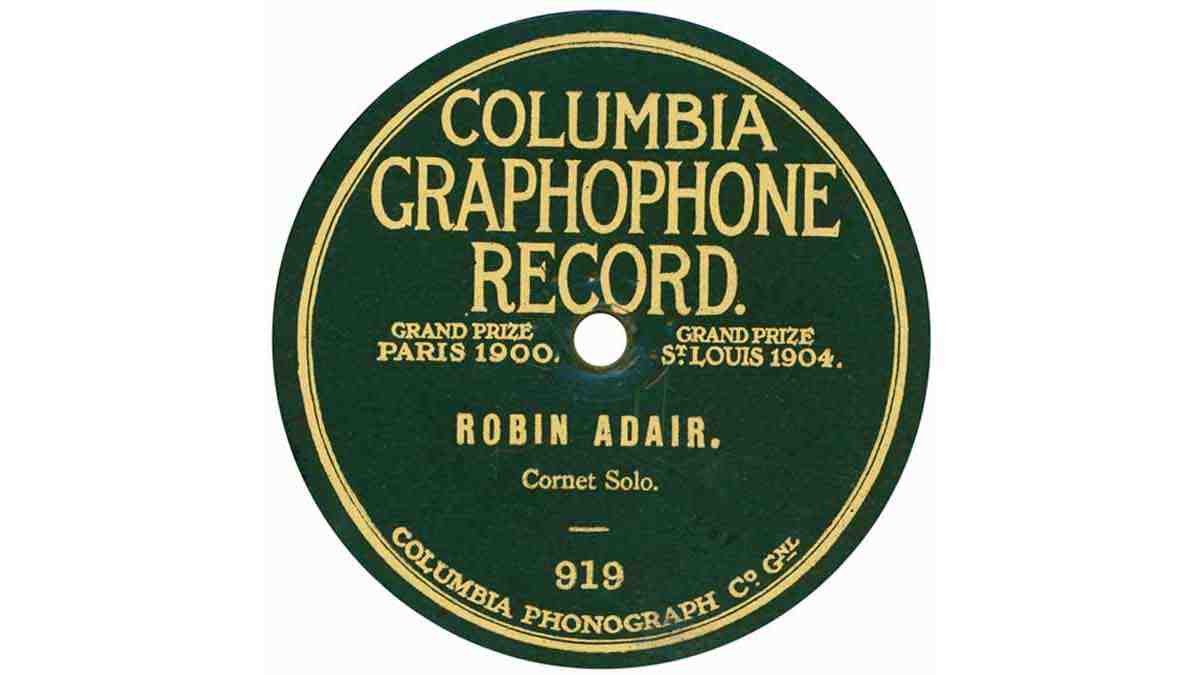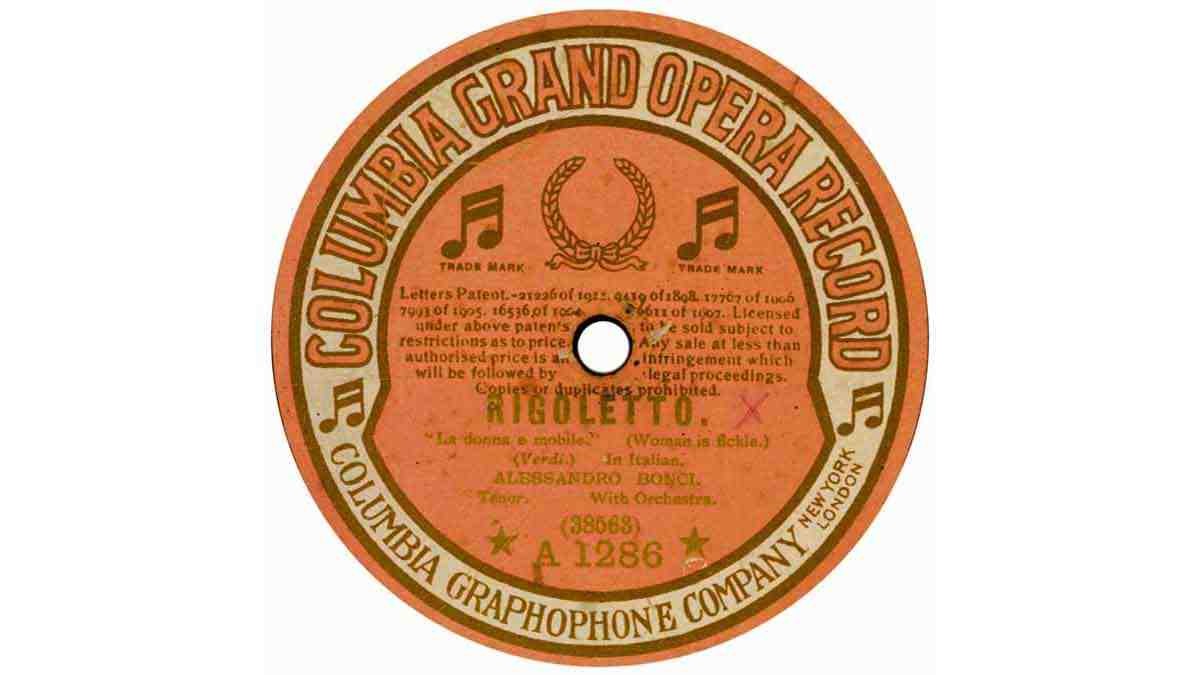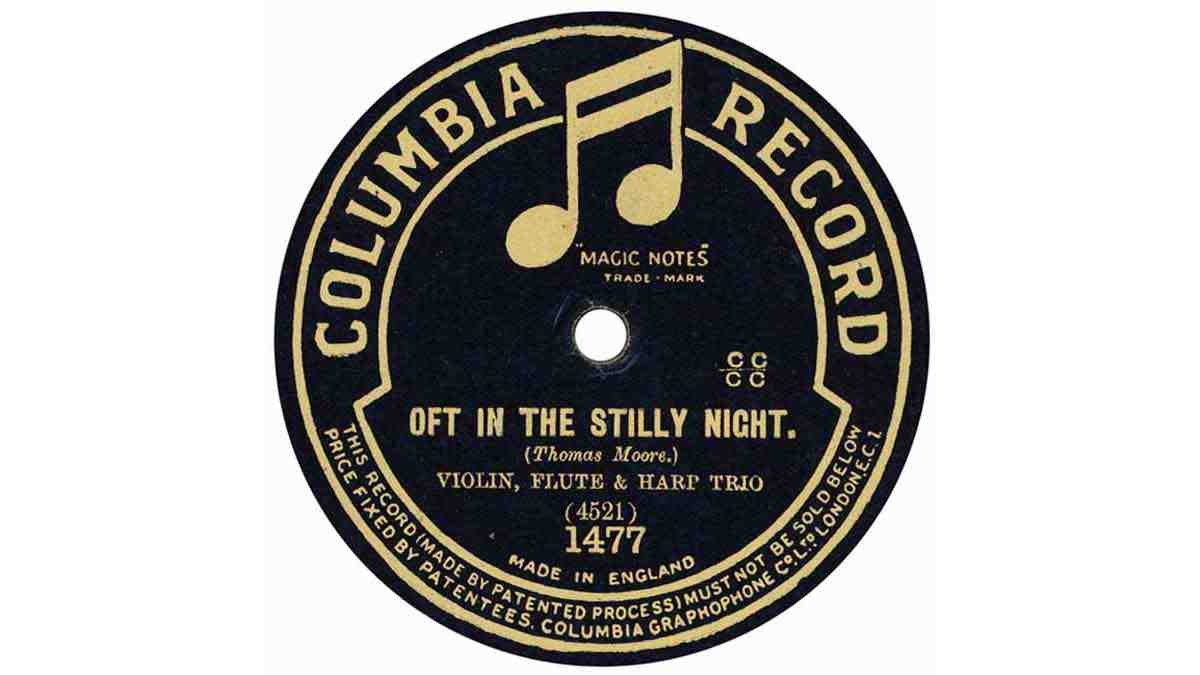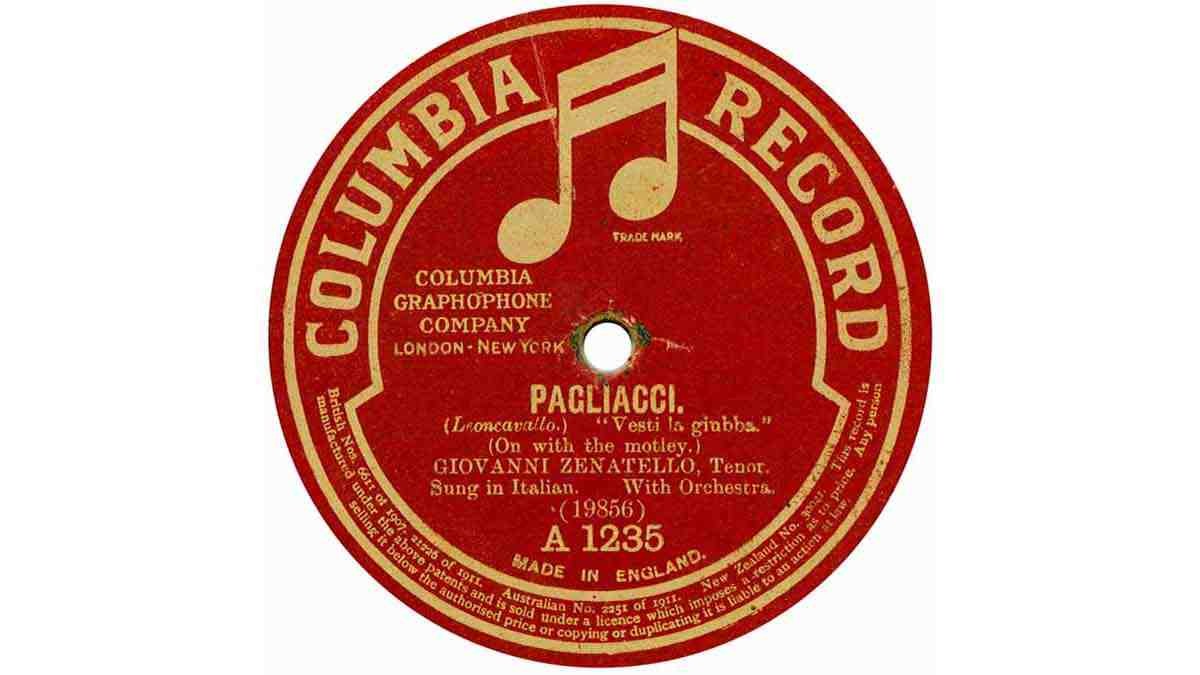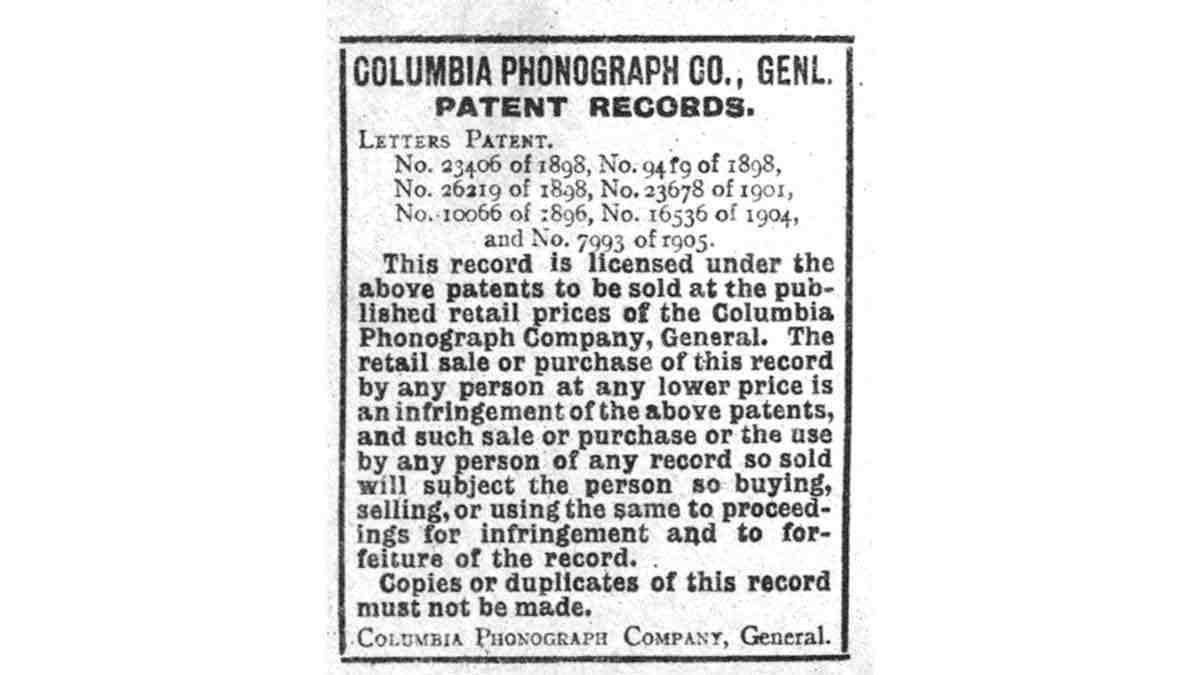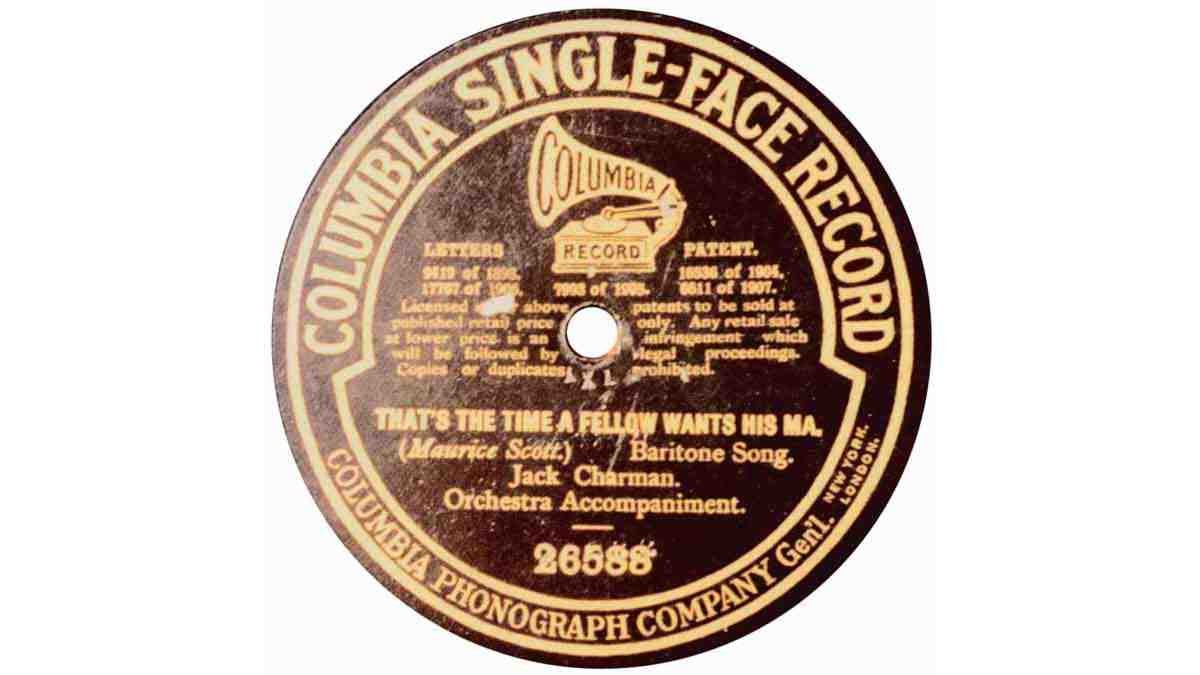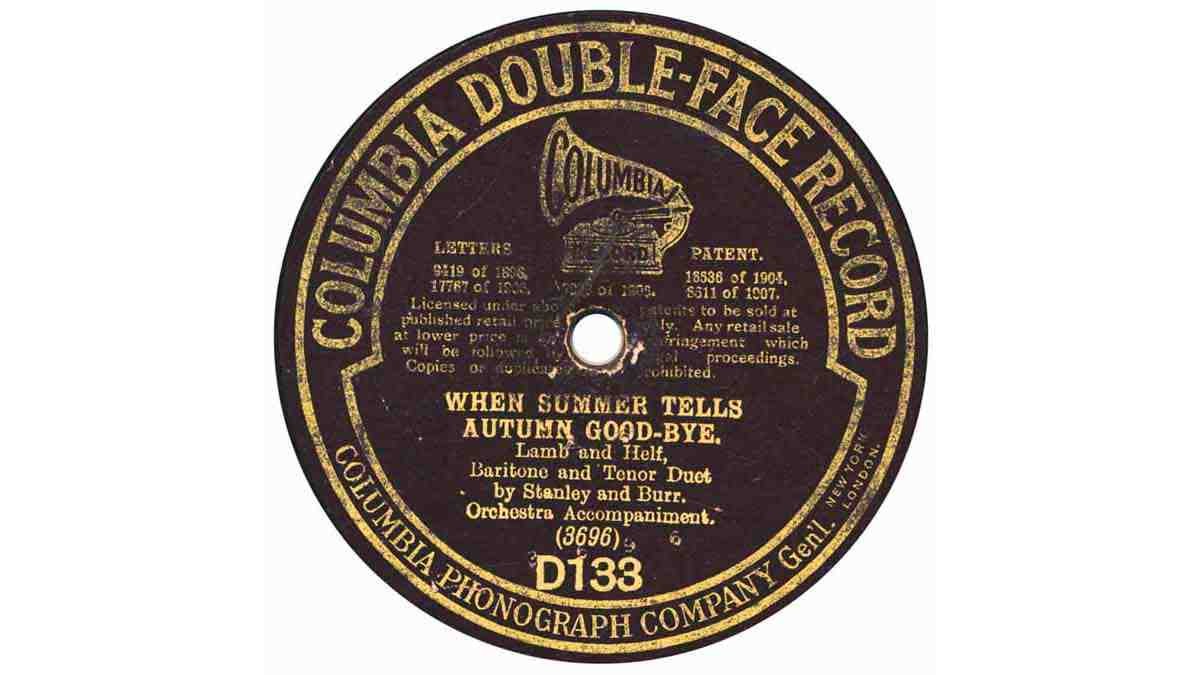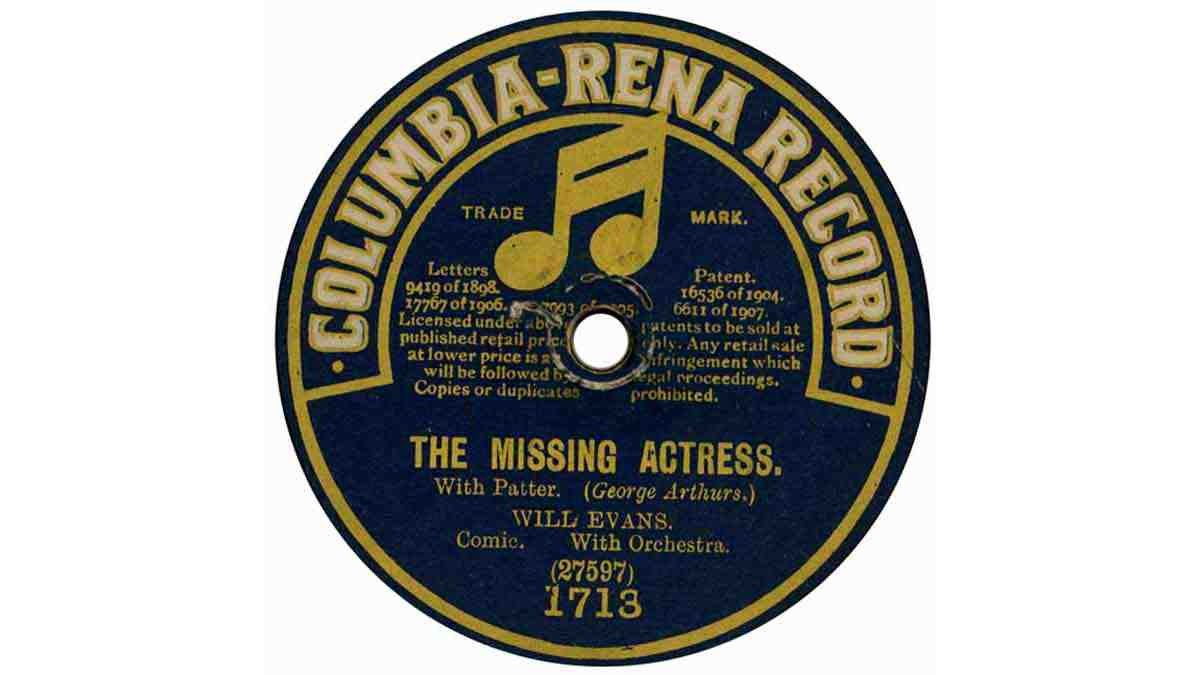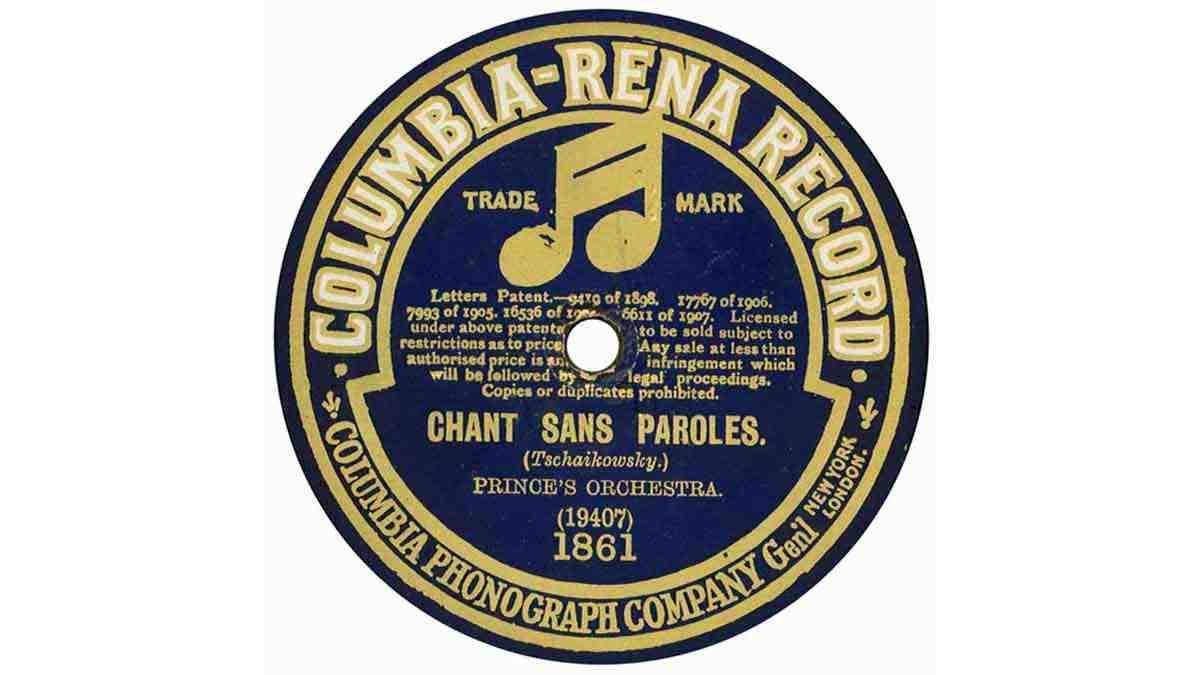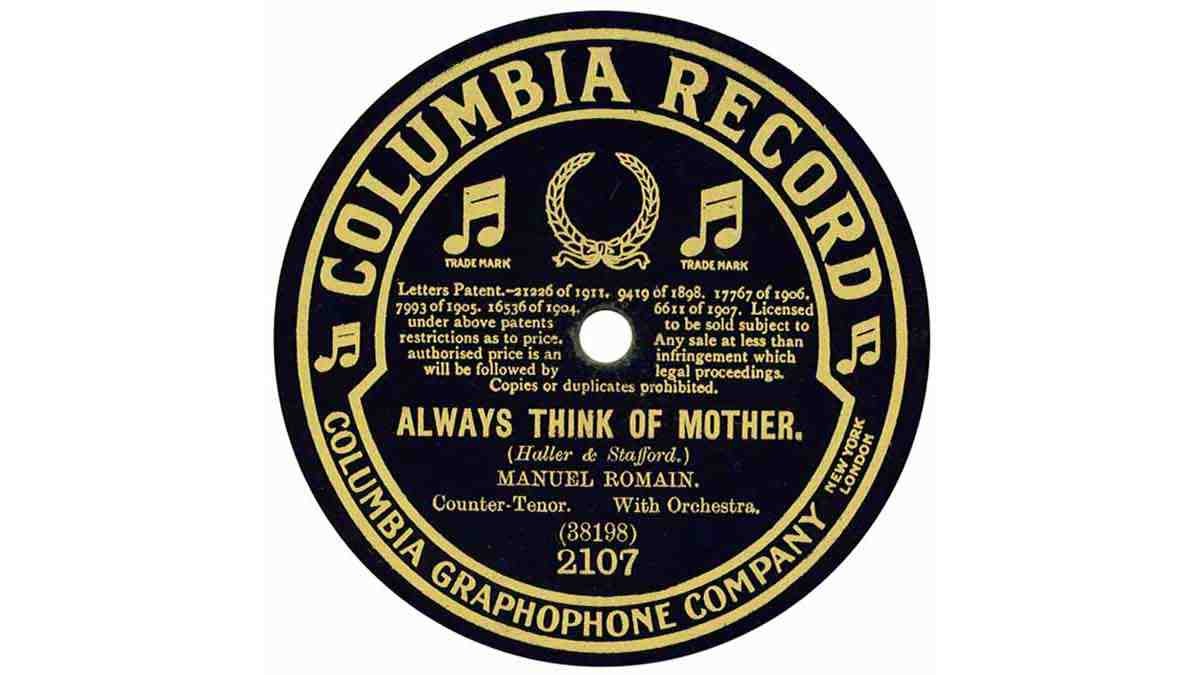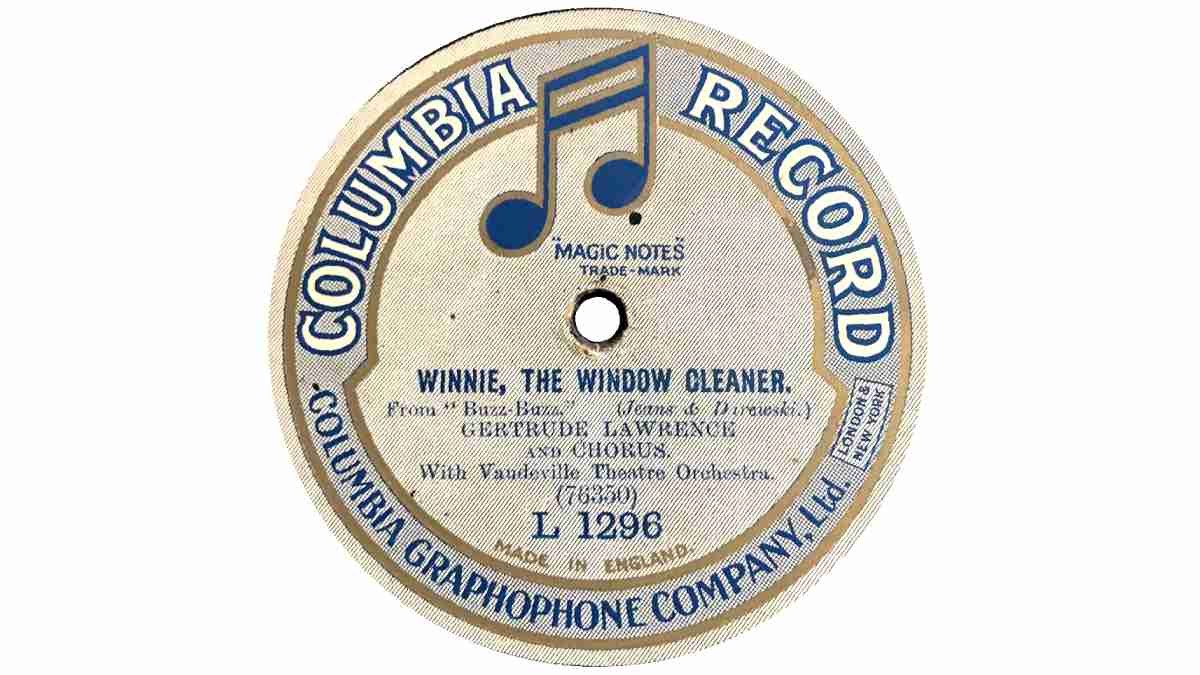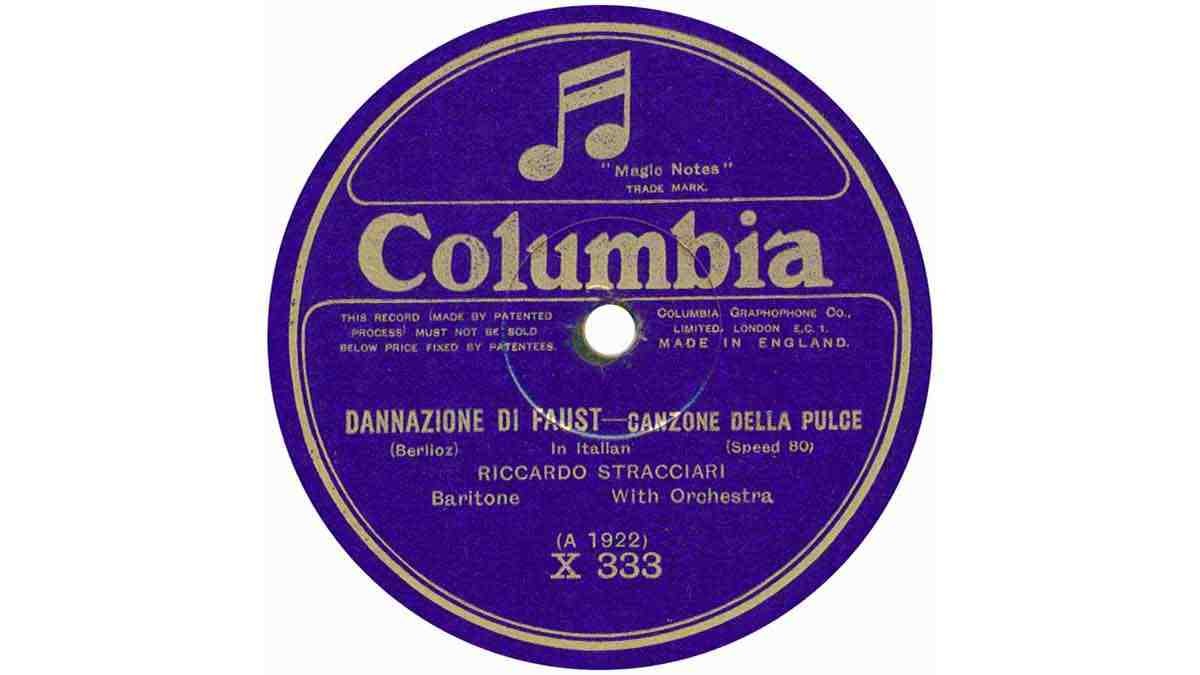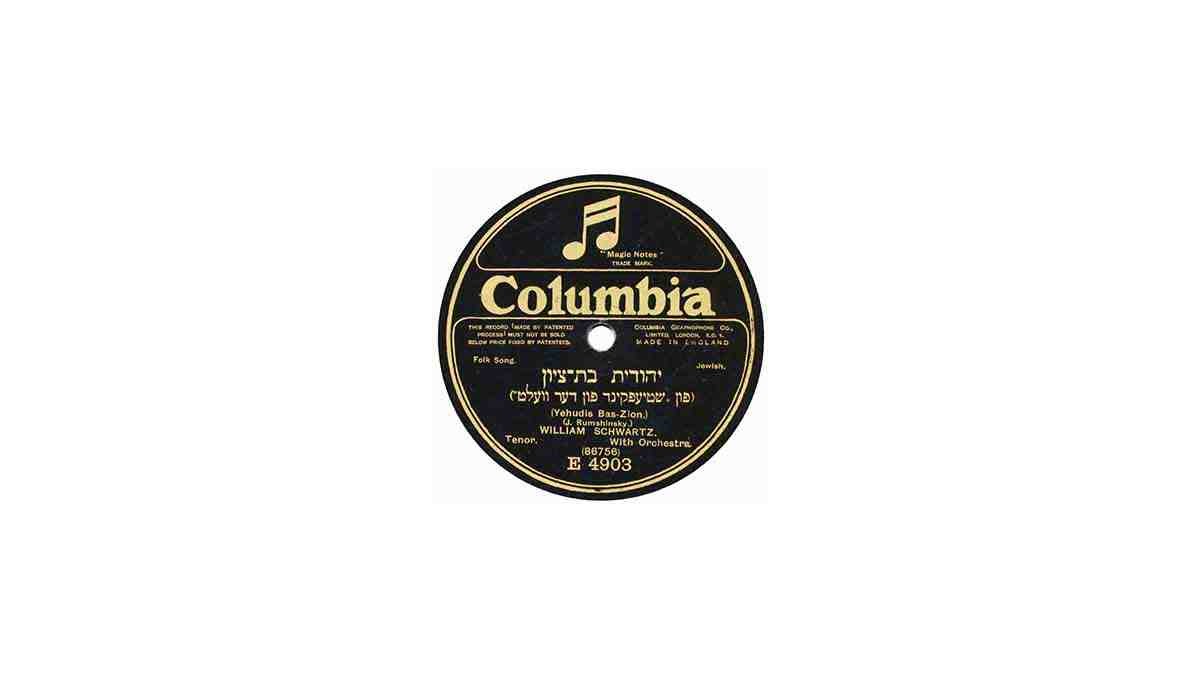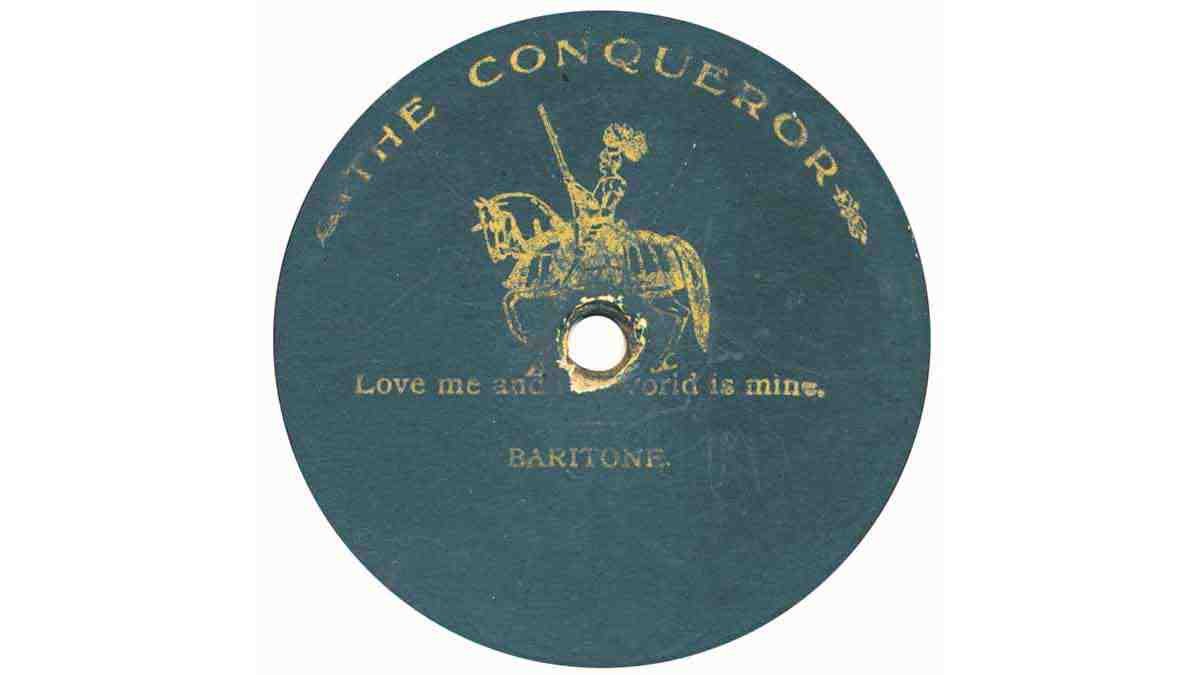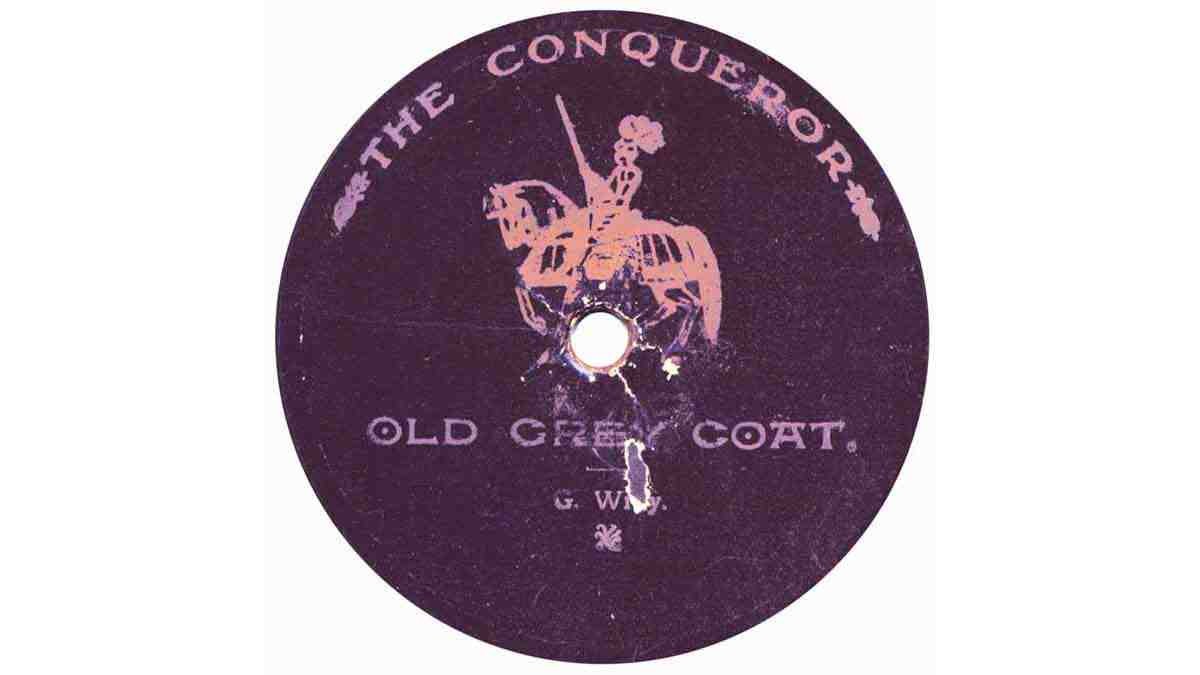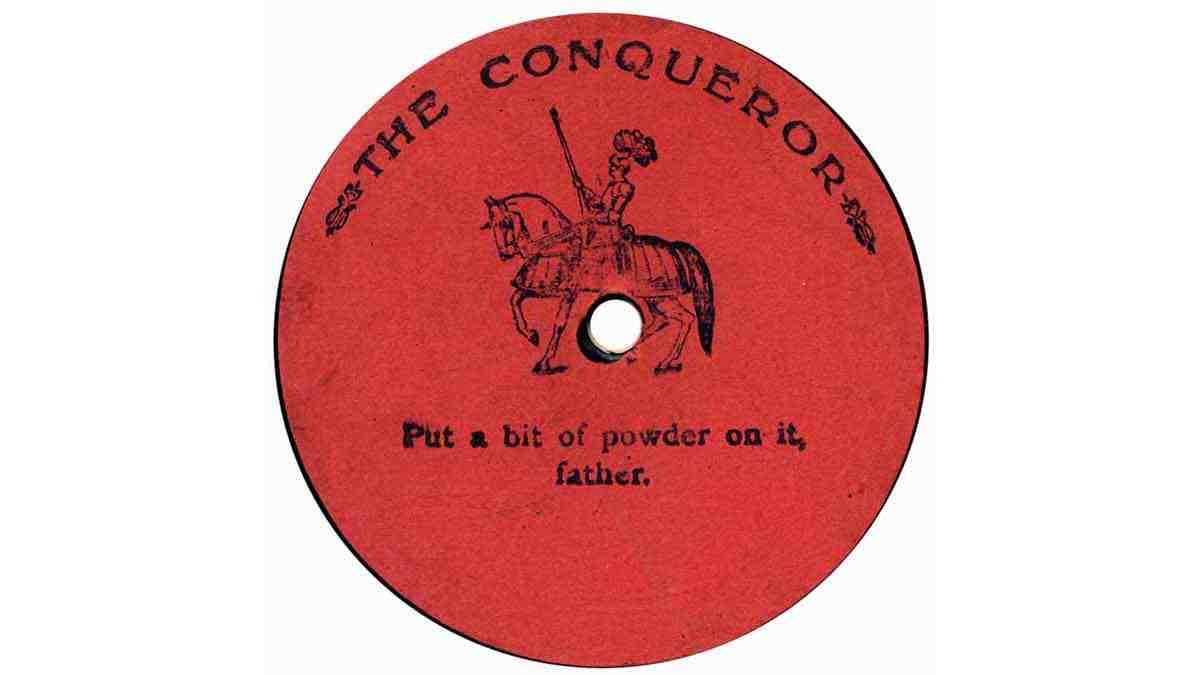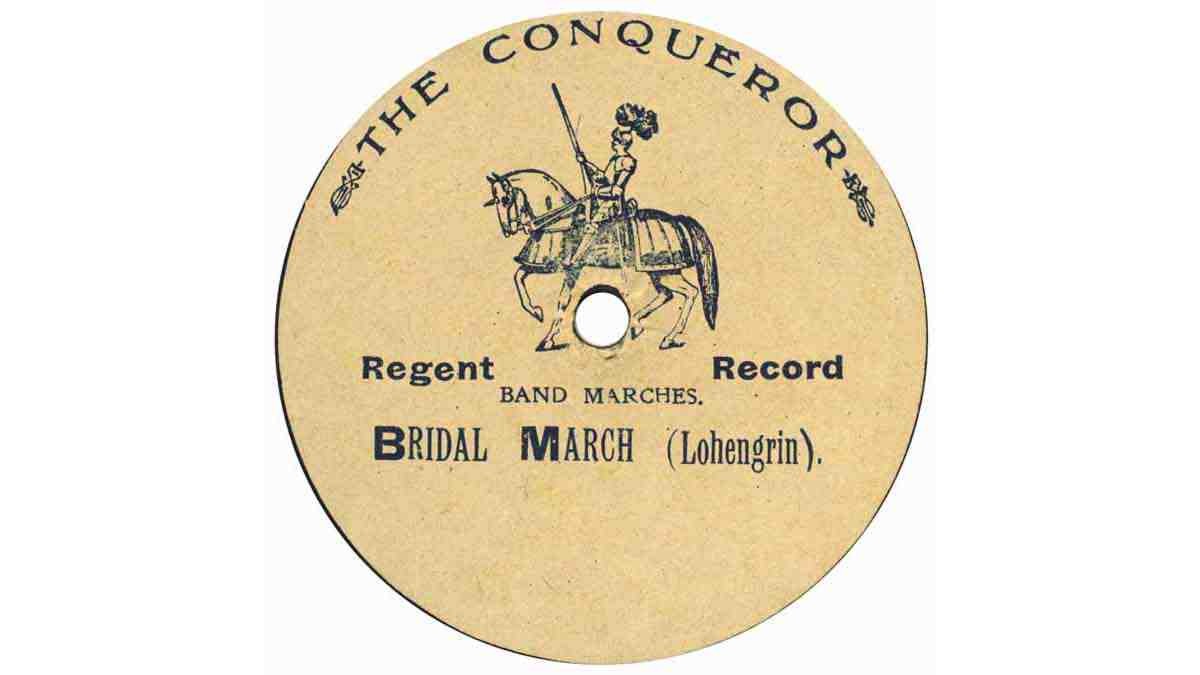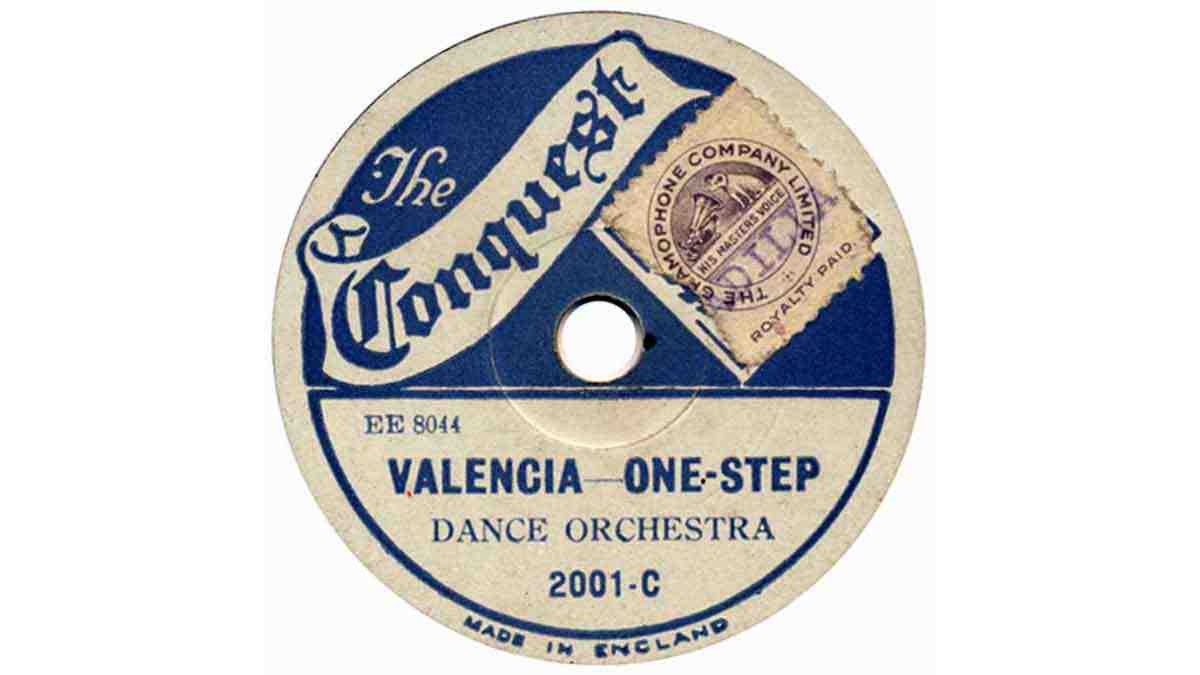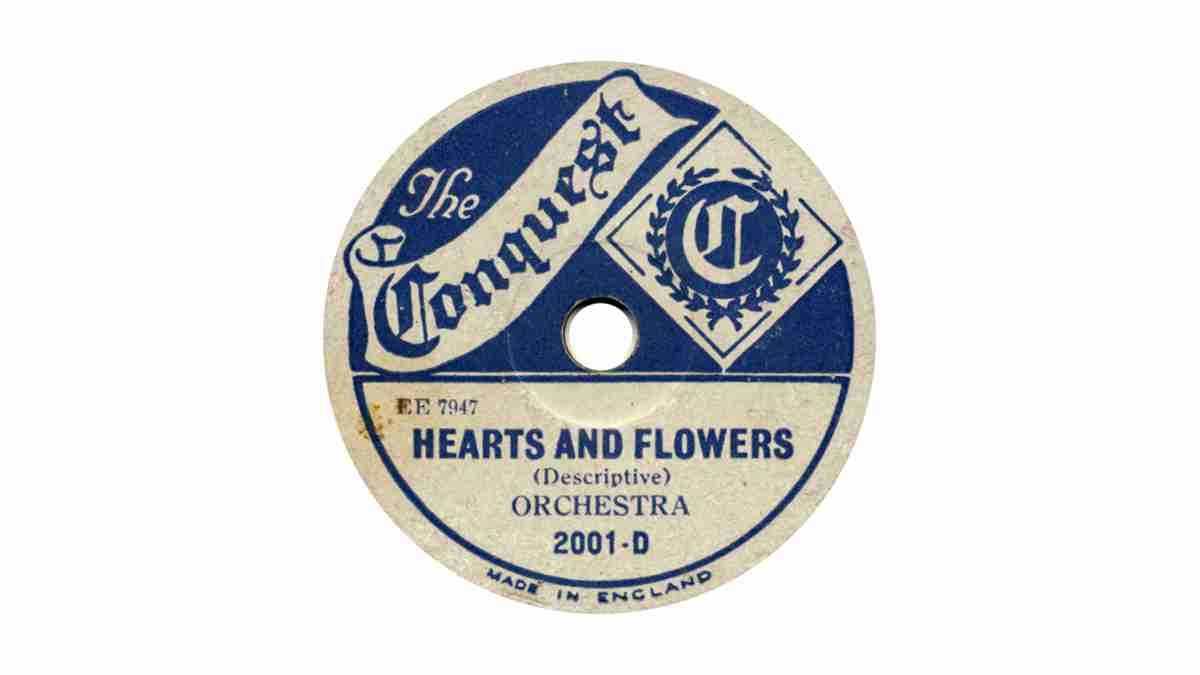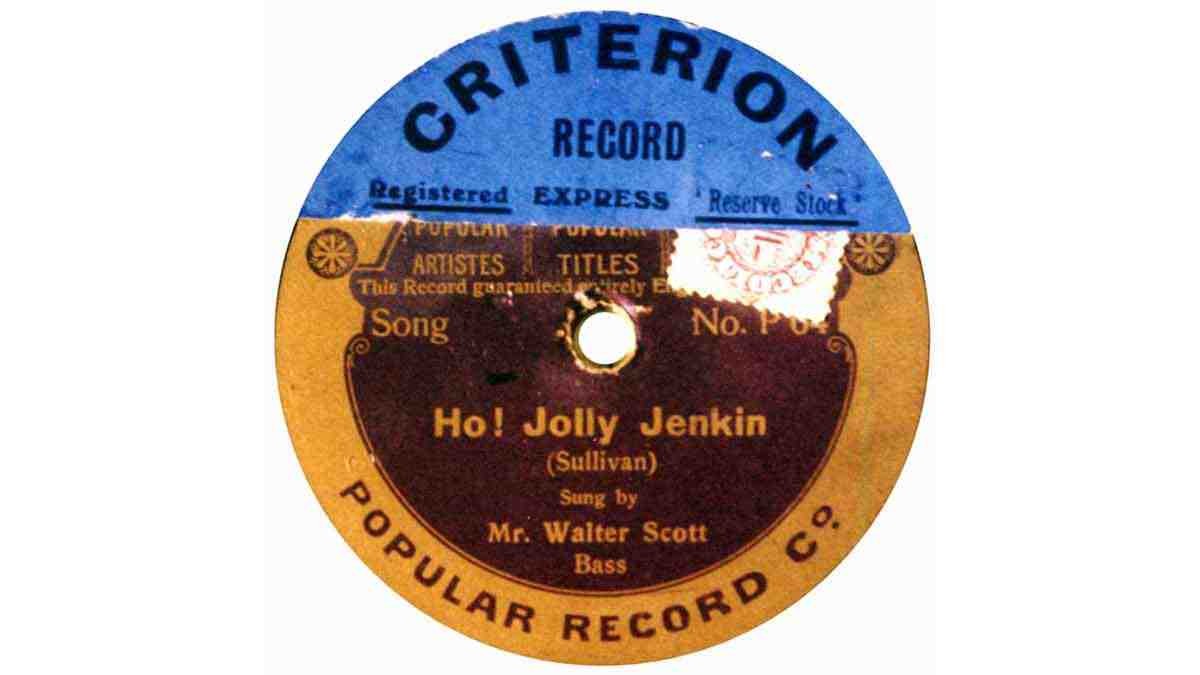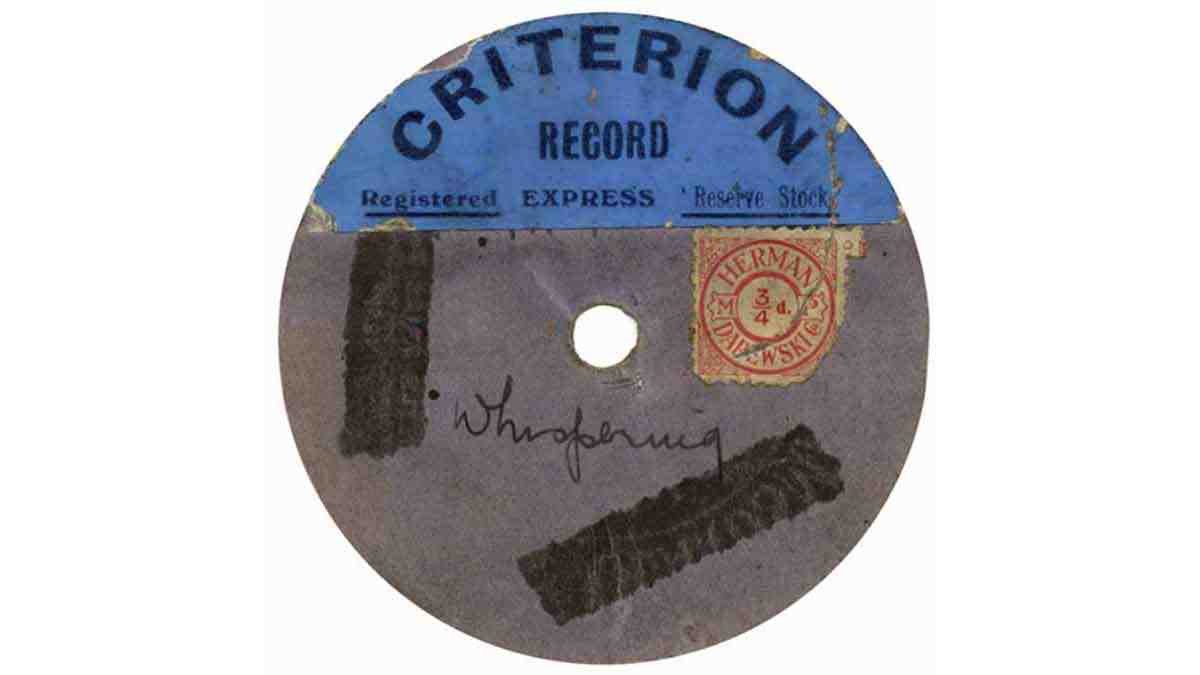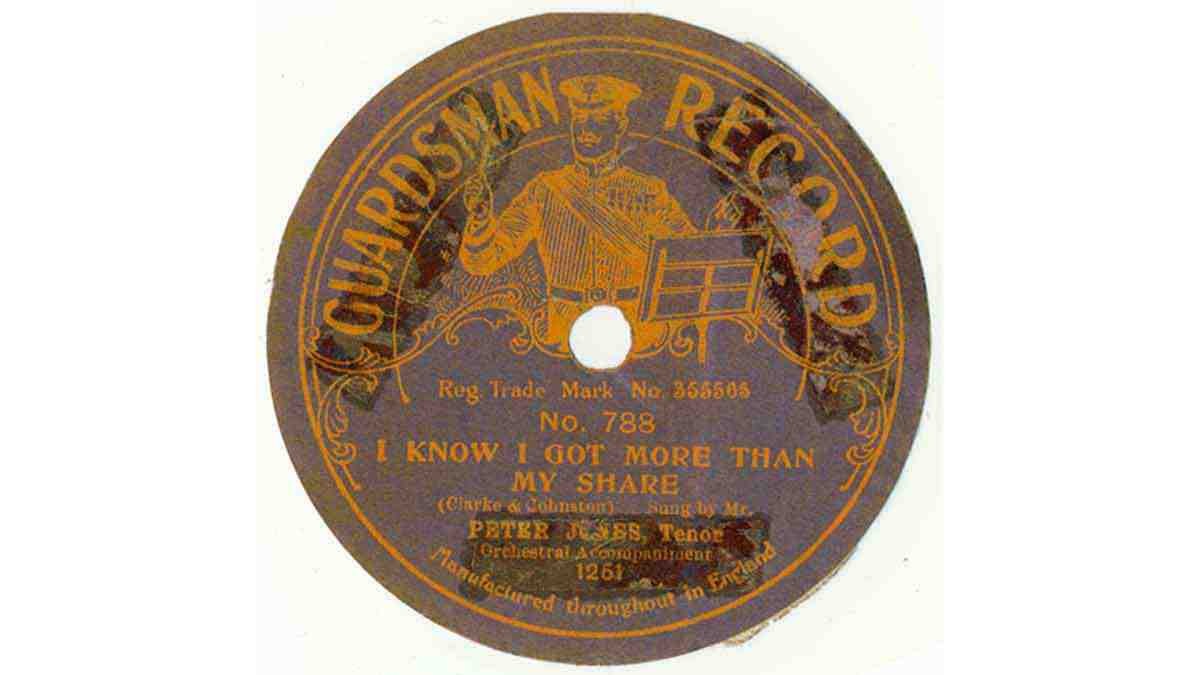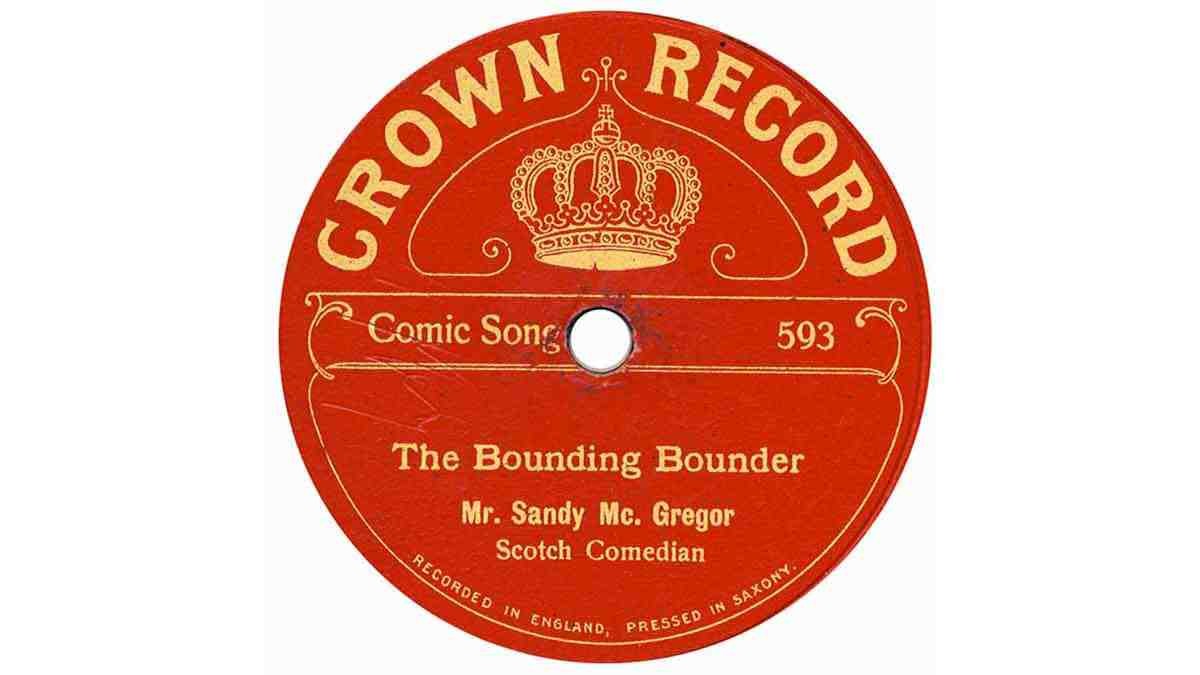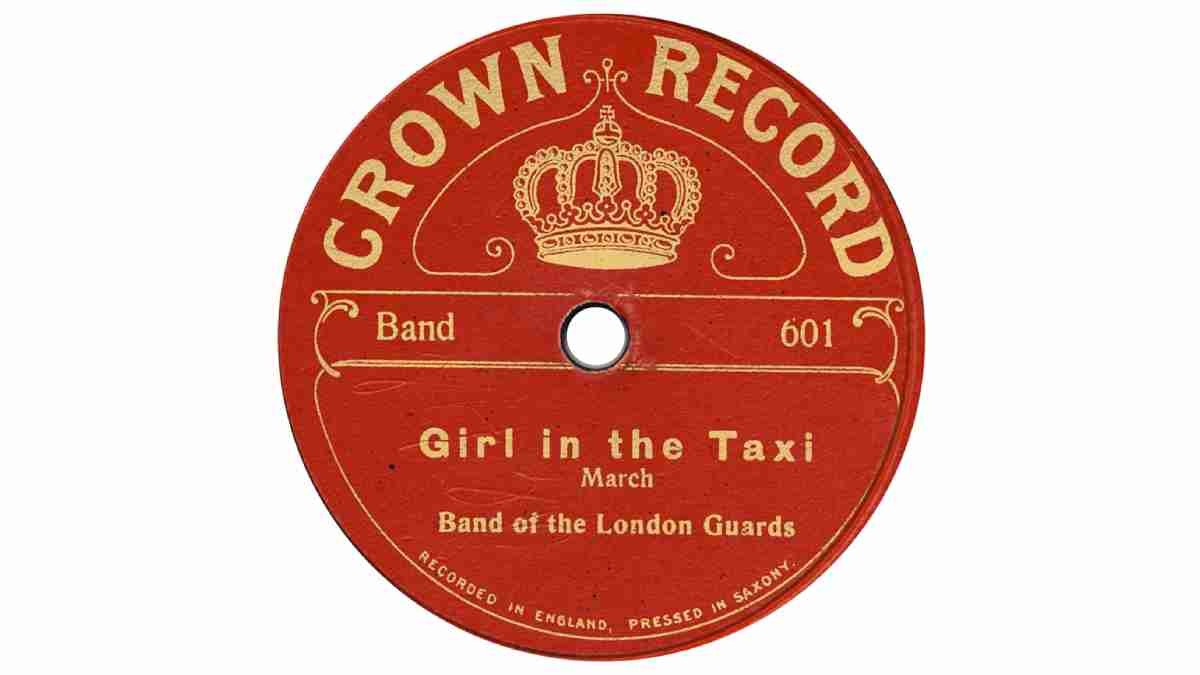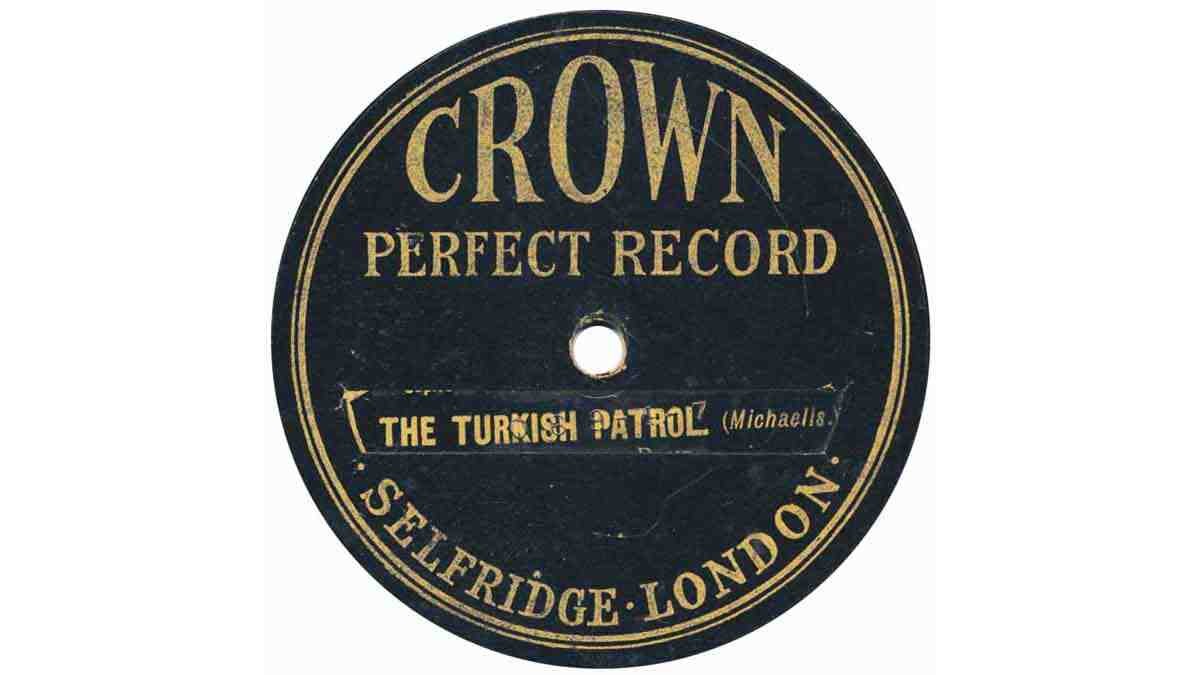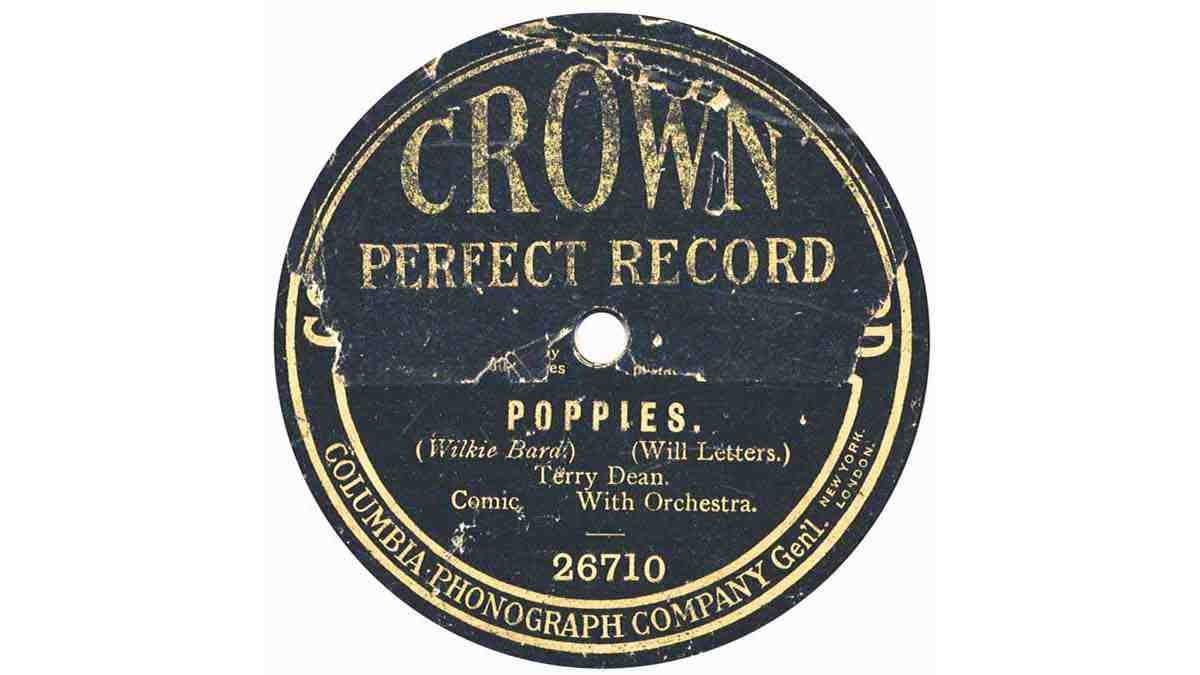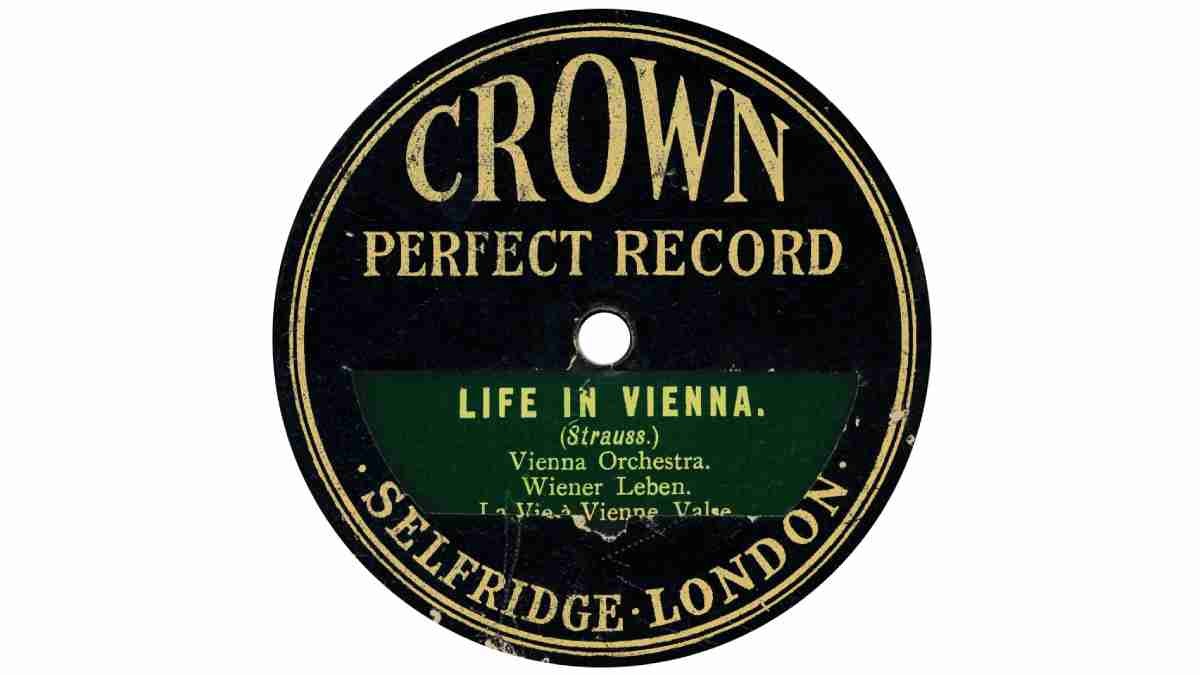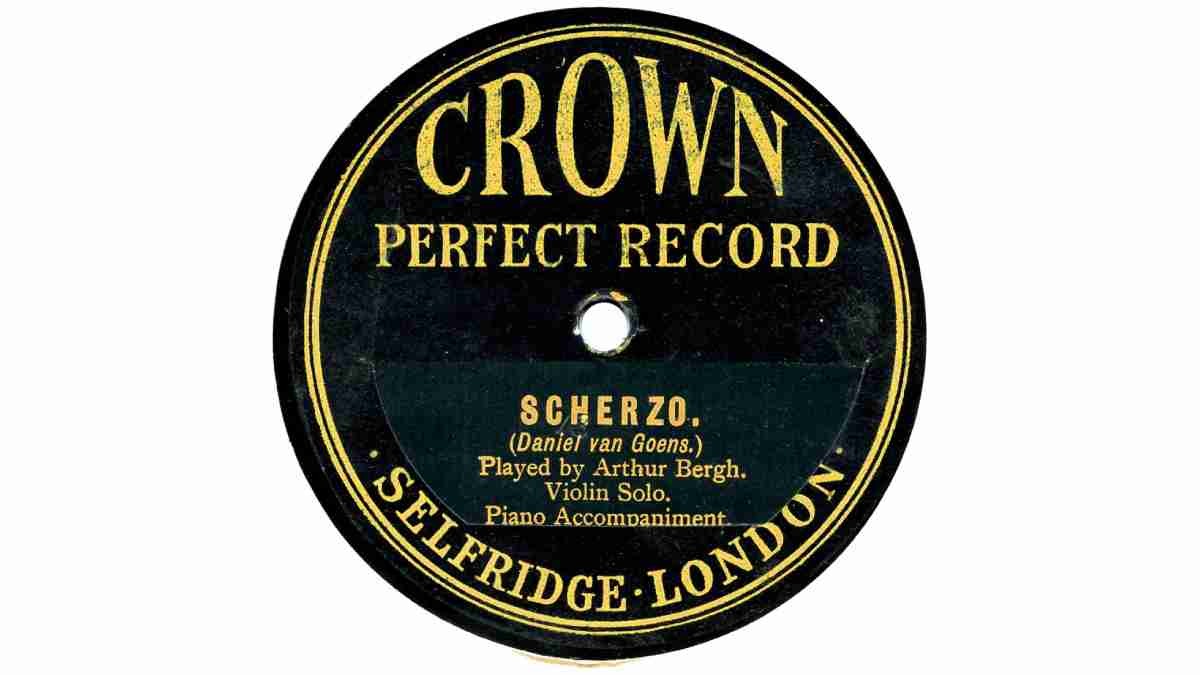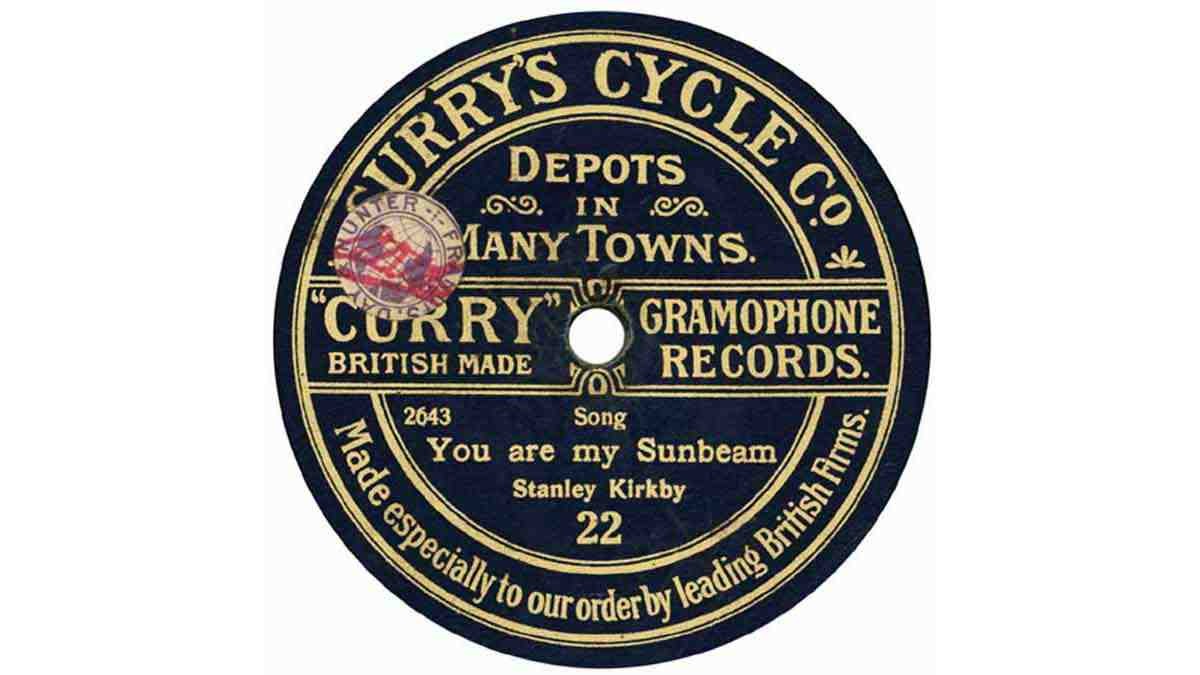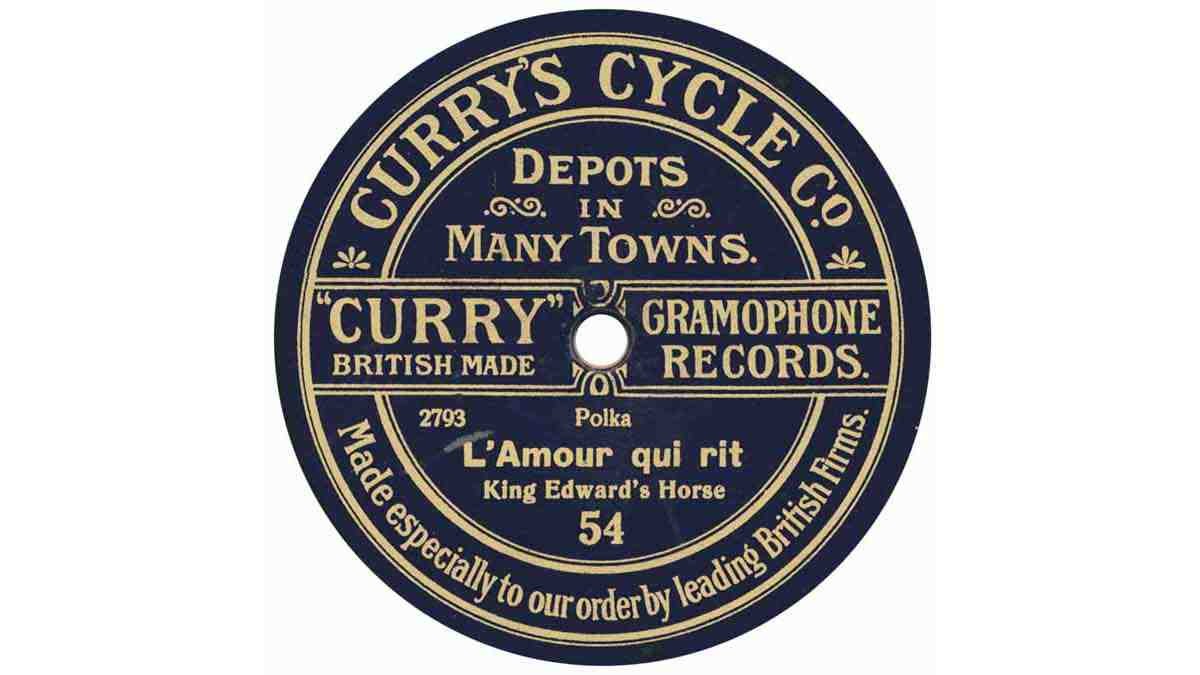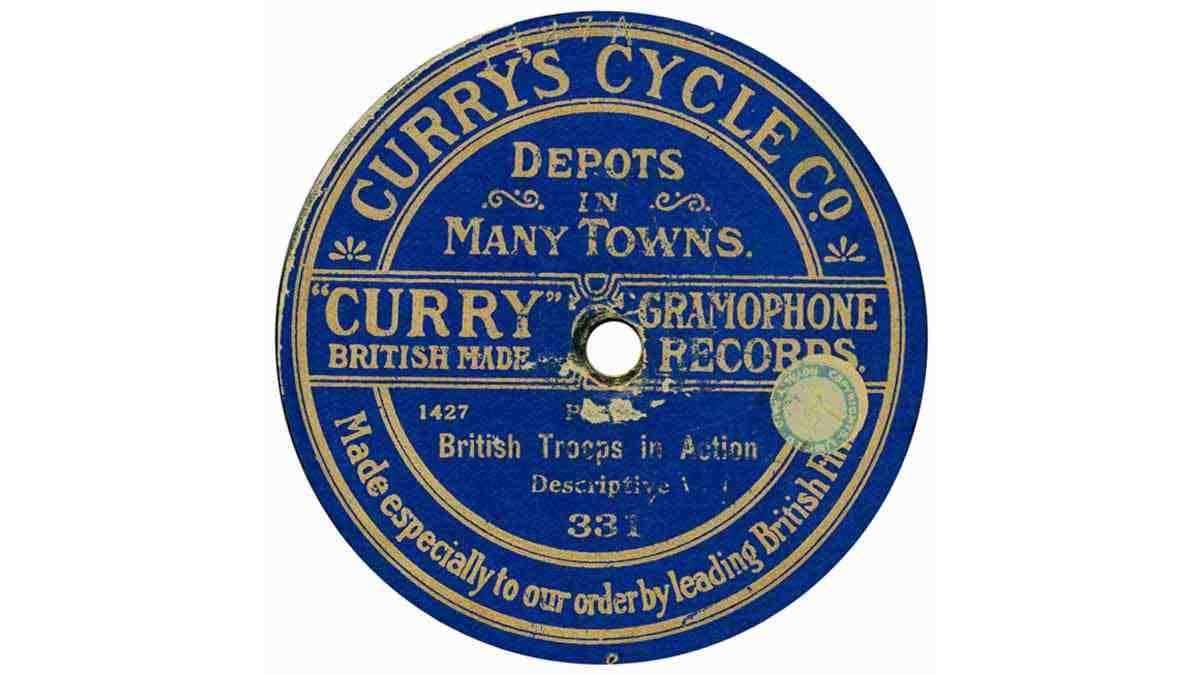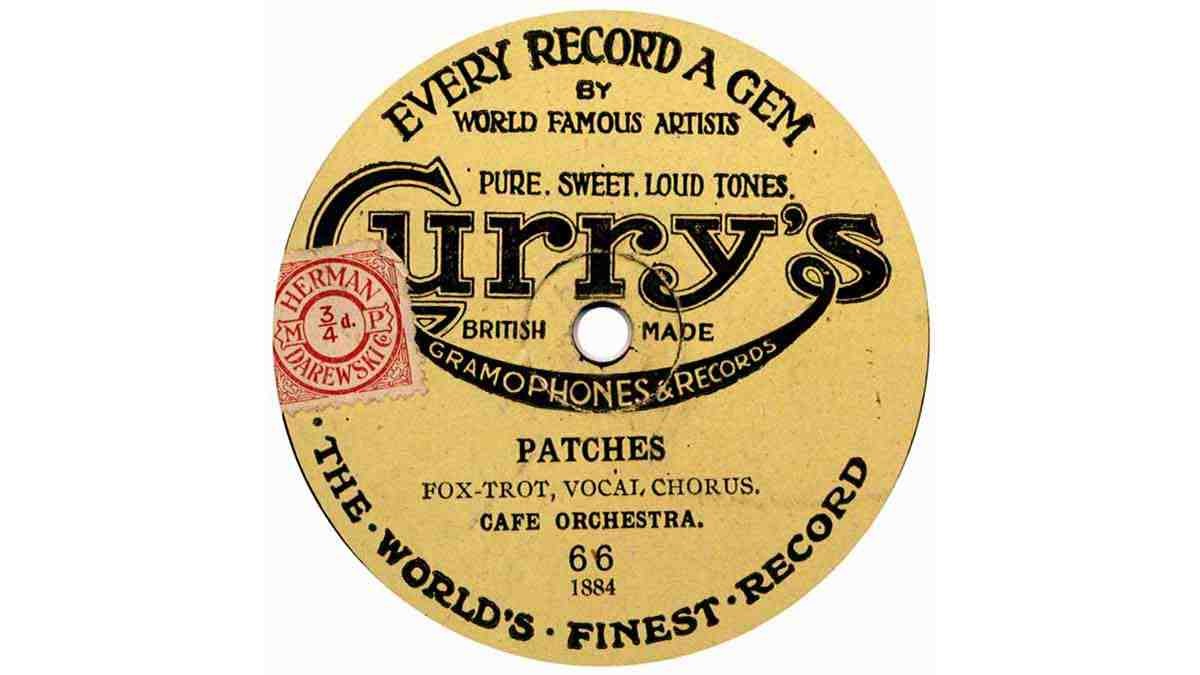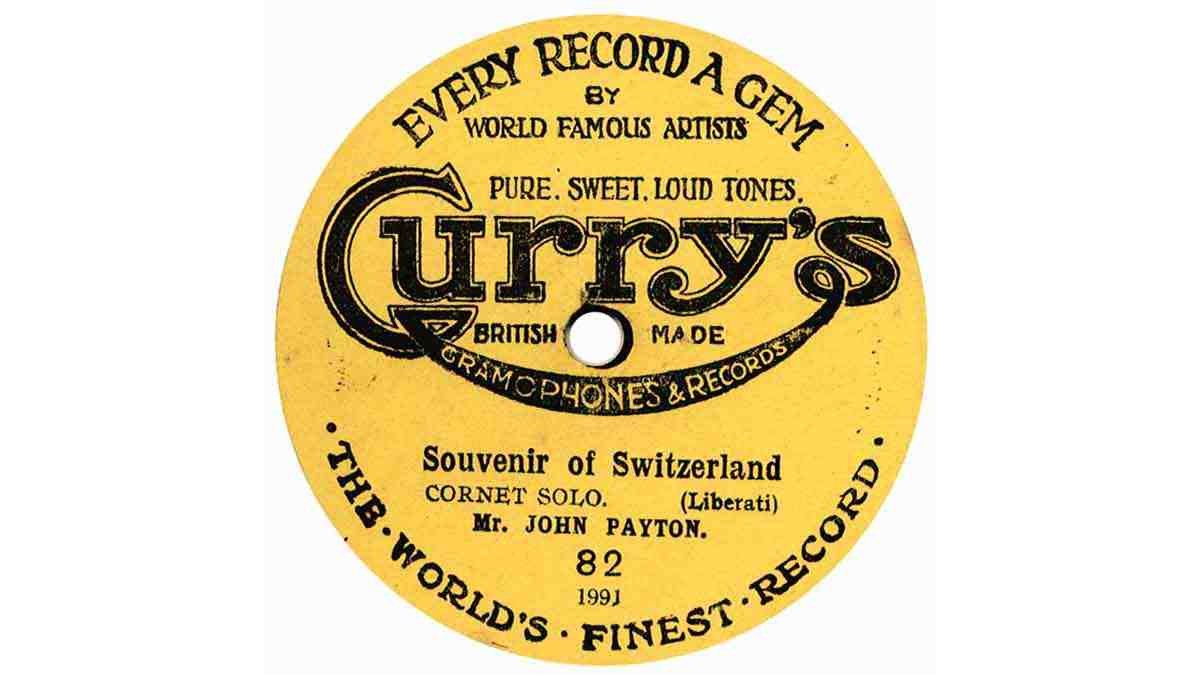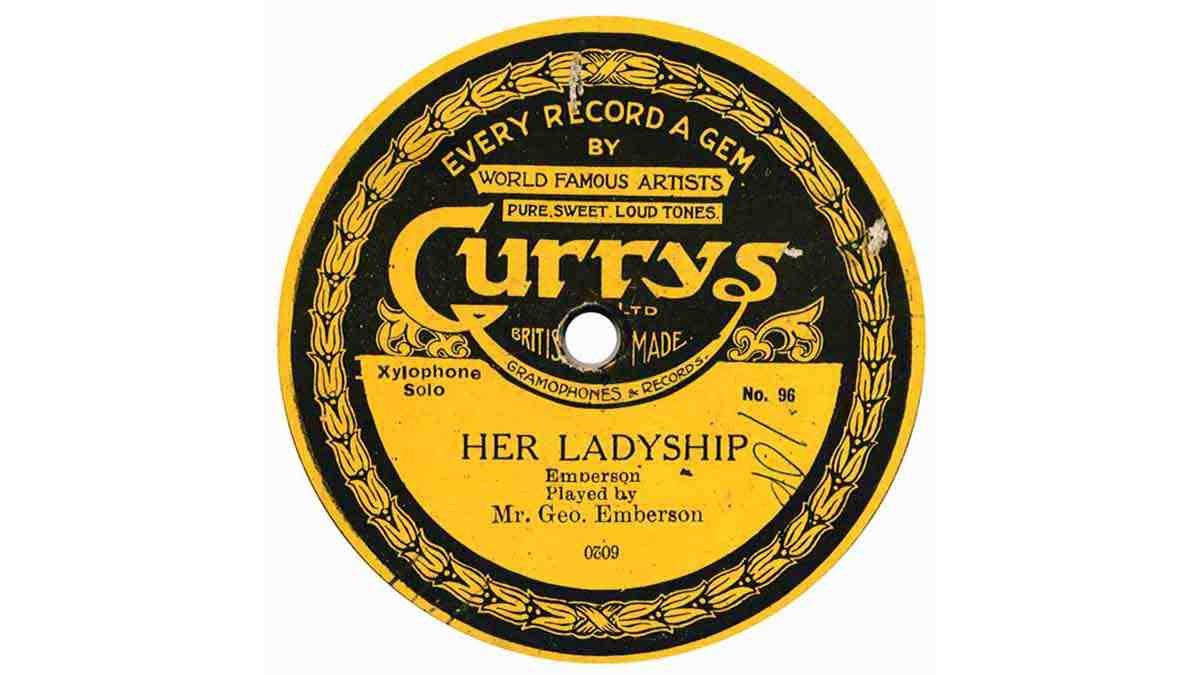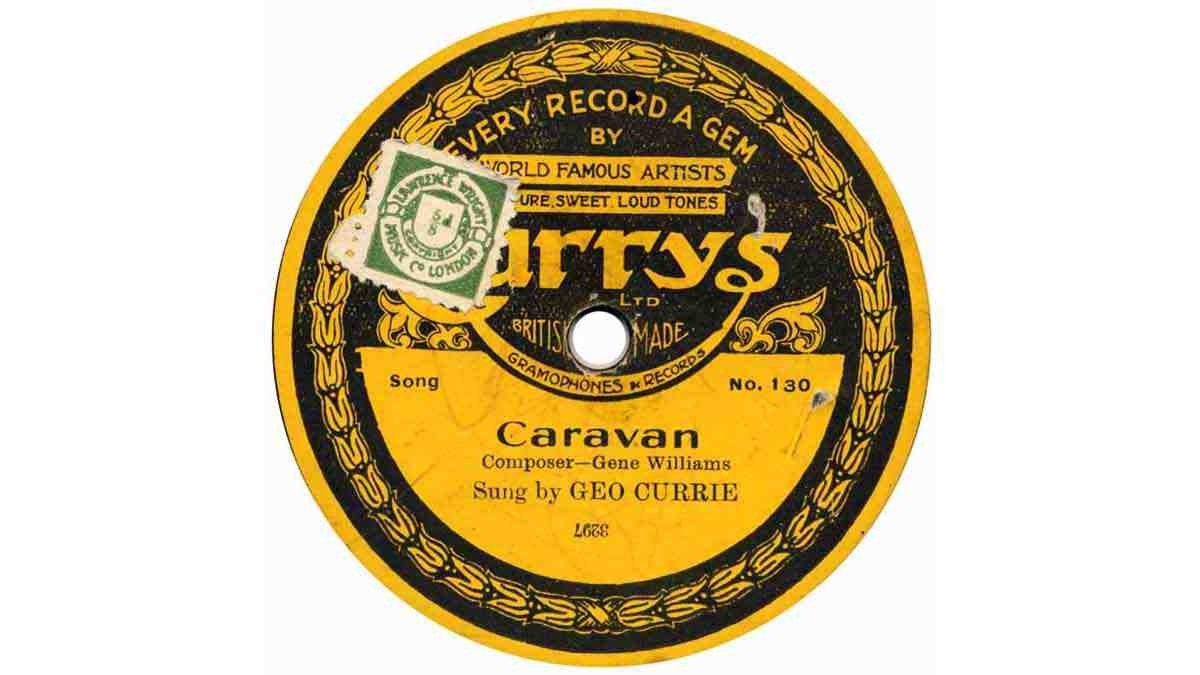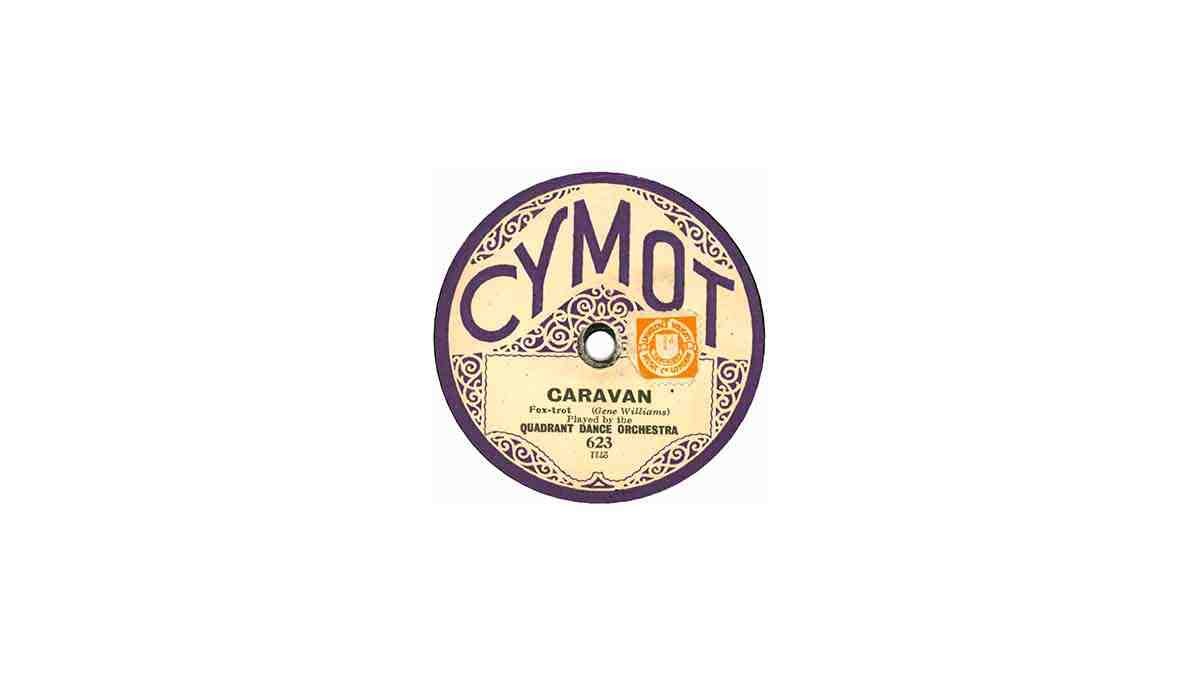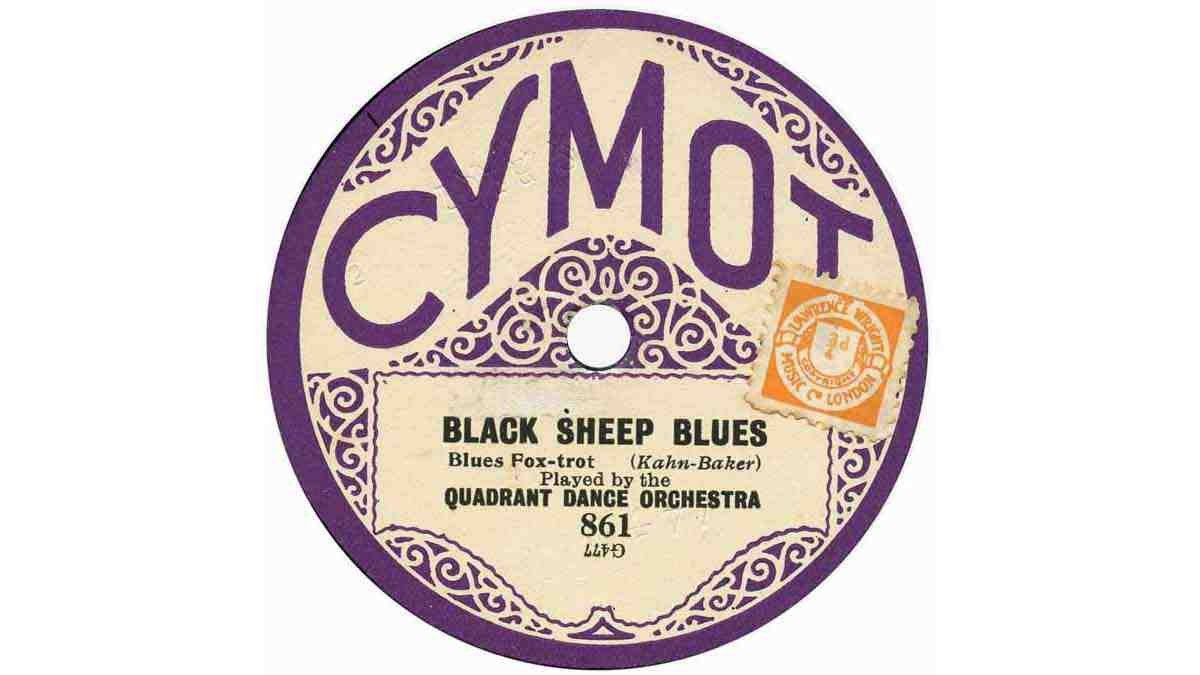
Early British record labels 1898-1926: C
Camden | Cameo | Canterbury | Capitol | Champion-Gamage | Chappell | Cinch | Cinephone | Citizen | Clarion | Cleopatra | Climax | Coliseum | Colonial, Colonial Perophone | Columbia | Comet | Concert | Conqueror, Conqueror Regent | Conquest | Coronet | Criterion | Crown | Crown Perfect | Curry's | Cymot
Camden
See E78PB. Don Taylor tells us that underneath these Australian Camden labels, we will find a British Vocalion. In 1927, Vocalion introduced their 8″Broadcast label, having given up making 10″ discs. Remaining stocks of the latter were jobbed off and exported to Australia, where Camden labels were affixed. So some Camdens will be electrically recorded, and some by the old mechanical system. It is the latter that qualifies them to appear on this page. There was also a light blue label of the same design with dark blue printing. This is less common, so thanks for Chris Singer from contributing this image, from Australia!
Cameo
See Frank Andrews, HD 223, 1998. Cameo records date from December 1916 to as late as 1921 – but were probably not continuously available during that period. All Cameo labels are stuck over Columbia-Rena, Regal and Phoenix records. The Columbia concern evidently had large stocks of these to clear, and as Frank tells us that the trade mark Cameo was registered to Columbia in 1915, they must have gone about it in a logical way. The first ‘wave’ of Cameos were sold by G Gilbert & Co. of Sheffield, at just 1/- (5p) each, a very attractive price, as during the war, the price of records – and everything else – gradually rose. These first Cameos had a C- prefix. By October 1917, about 100 were available. None bore artiste credit, simply describing the performance: ‘song’, ’band’ &c. Frank discovered that the Z- series seen above consisted only of Regals deleted in August 1918 and March 1921. Therefore there might be as many as three ‘waves’ of Cameo: the first (C- series), probably the largest one, sold by Gilberts, probably to exhaustion; then a second batch (Z-) which may or may not have gone via Gilberts, and dating perhaps to late 1918; then a final wave (Z-) in say mid-1921. The copyright stamp on the Regal can be seen under the label of Z-79. The blue-lettered ‘half label’ stuck over Regal G-7616 is from another separate venture or disposal; these were sold in Australia by an unknown vendor.
Canterbury
At an unknown time, not before February 1914, but possibly as late as 1922, the Up-To-Date Record Co., of 14-15 The Borough, Canterbury, Kent, created ‘Canterbury’ records by the simple expedient of applying a crescent-shaped sticker to other records, bought in from the disposal of old stock by established companies, or job lots from wholesalers or from failed retailers. The above is – or was – a Valkyrie record (originally made for Catesby’s Department store in London) which has been converted into a Canterbury. A violet label Popular record with a similar green sticker is also known. Whether there are other makes of record with other coloured or shaped stickers is not yet known. Very scarce indeed.
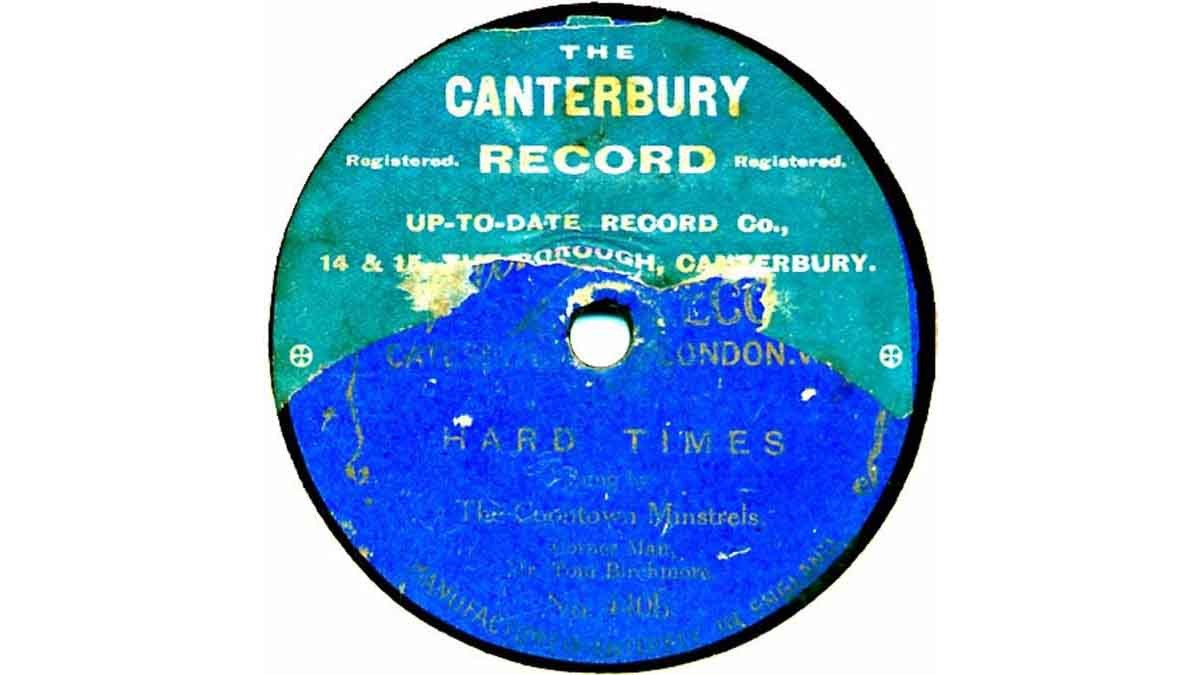
Capitol
We can do no better than to quote directly from Don Taylor’s excellent ‘English 78 Picture Book’, as follows. “In 1927, the Australian Houses of Parliament were opened in Canberra. To ‘capitolise’ on this event, the Capitol record appeared in Australia. On its bluish-black label (stuck over English Parlophone) we can see a view of the buildings in question. We can also see the word ‘electric’, which should be interpreted in a figurative rather than a literal sense. After more than 60 years of service, the buildings are now being converted into a kind of political museum.” Don is absolutely correct re. ‘electric’; the example illustrated above, kindly furnished by Adam Miller (New Zealand), cloaks an example of Parlophone E-5001, which was issued in the U.K. in 1923, well before electric recording appeared effectively. To drive the point home, the sides on this disc were originally issued on Beka in 1912. Beka recordings of that time were very good, but certainly not electric! Rather, surplus Parlophones were being jobbed off from the U.K. for the Australian market.
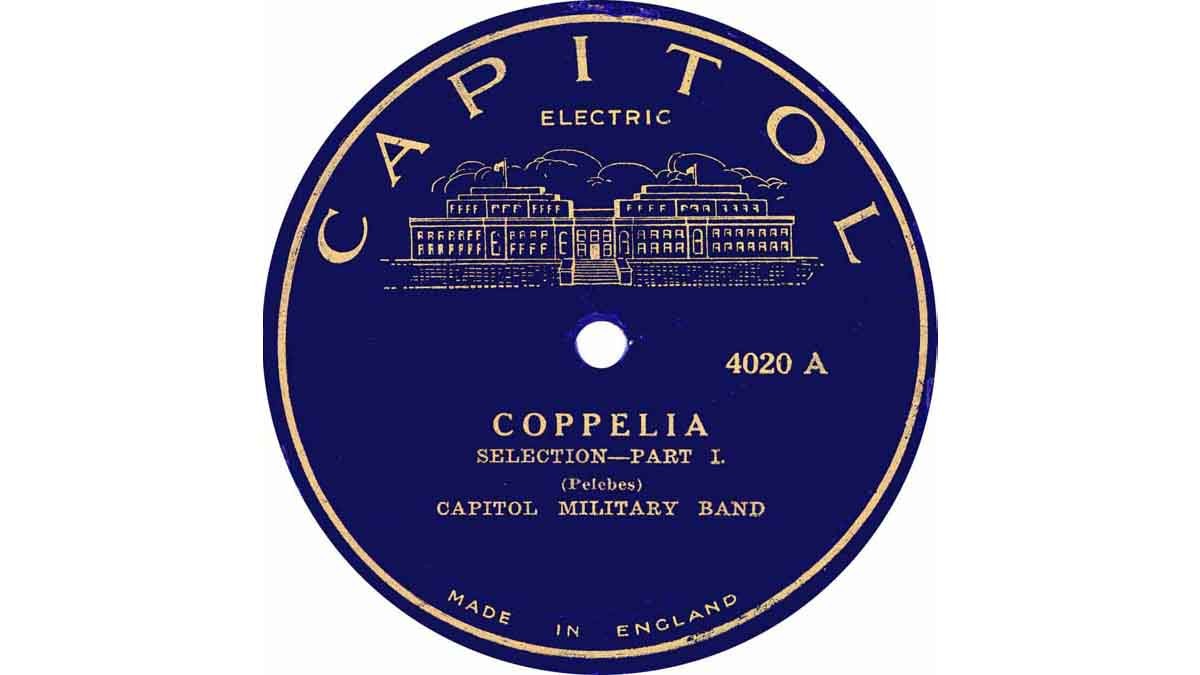
Champion-Gamage
See Frank Andrews, HD 181, 1991. Gamages was of course the great London department store. They had a number of ‘house labels’ over the years, of which this is almost certainly the first. Produced for them by The Sound Recording Company, the masters came from its own label Grammavox, and were pressed, Frank reports, either by ‘Edison Bell’ (to begin with), or Crystalate. These records are easy to recognise, as they are 10¼” (10.25 inches) in diameter. Not less than 180 were issued, obviously. It is not known when they ended. G-39 can pretty confidently be attributed to 1912, as it bears a very early and short-lived form of copyright stamp used only by the SRC, saying ‘Listed for copyright’. These stamps were fixed to records as proof that the proper royalty (5% or one twentieth of the retail price) had been paid to the publisher of the work, or an agency acting on their behalf. They are not terribly common. See also A W Gamage, Gamage.
Chappell
See Frank Andrews, HD 223. The long-established music publishers Chappell had already briefly entered the disc market in late 1911, with Aérophones imported from France. Their own discs appeared in March 1914. There appear to be relatively few issues – perhaps only 20 or so, which would doubtless have been the ‘initial launch’. They were recorded for Chappell by the Sound Recording Co., and pressed by Crystalate. Two 12″ discs with an A- prefix were also issued. Presumably their venture was not attended with much success, so no more were issued. See Frank’s article for more interesting information on this short-lived label.
Cinch
There is a complete listing of Cinch records by Arthur Badrock and Frank Andrews – CLPGS Reference Series No. RS-30.
With the onset of the 1913-14 ‘Record Season’ about September, a Price War began. The proliferation of labels and marques was such that prices had already been perceptibly falling. Now, the major companies took a hand. The Gramophone Company (i.e. HMV) and Columbia both introduced, anonymously, cheap labels. These they sold virtually ‘at cost’ – perhaps even below cost? They were determined to drive out, once and for all, the many smaller companies that had arisen, and were largely manufactured in Germany. Cinch was the Gramophone Company’s cheap label, and sold at 1/1 – one shilling and a penny; about 5.5p. They appeared in 1913 and were made to the same high standard as HMVs and Zonophones. Many existing masters of useful standard repertoire, dating back to 1905, were put out on Cinch. But new material was also extensively recorded in the spring and summer of 1913, ready for the first release. The rest, as they say, is history. The Cinch sold in immense numbers, such that they may still be found today from time to time. War was declared on Germany on 4th August 1914, so the German imports were stifled. Columbia’s equivalent cheap label was Phoenix. According to the London reporter of the U.S. trade magazine Talking Machine World, the Phoenix and the Cinch were announced on the same day, from which we infer that this fight-back by the U.K’s two main companies had been secretly agreed long before.
Cinephone
Thanks to Mike Atkin, we have a scarce example of early synchronised film sound. The side was issued as Jumbo 296, and dates from around January 1909. However, this copy has been specially pressed as a single sided disc, and has been provided with a cueing groove. Firstly, a silent film was shot while an artiste was singing along to his own record; then, in the cinema, the ciné projector was synchronised with the gramophone turntable, and the film would have a ‘sound track’. See the entry for Vivaphone, which is a much better-known version of the same system. However, in the case of Vivaphone (hundreds of them were made), it was never the original artiste who was filmed – just an actor who had learned the record, singing along to it. It would be most interesting – in fact it would be sensational – if Cinephone actually filmed the true artiste! This was actually done in Germany by the Messters Film company. Of course, most of the old nitrate films were lost or discarded; but one spectacular restored Messters film of Alexander Girardi is on YouTube. It dates from around 1908.
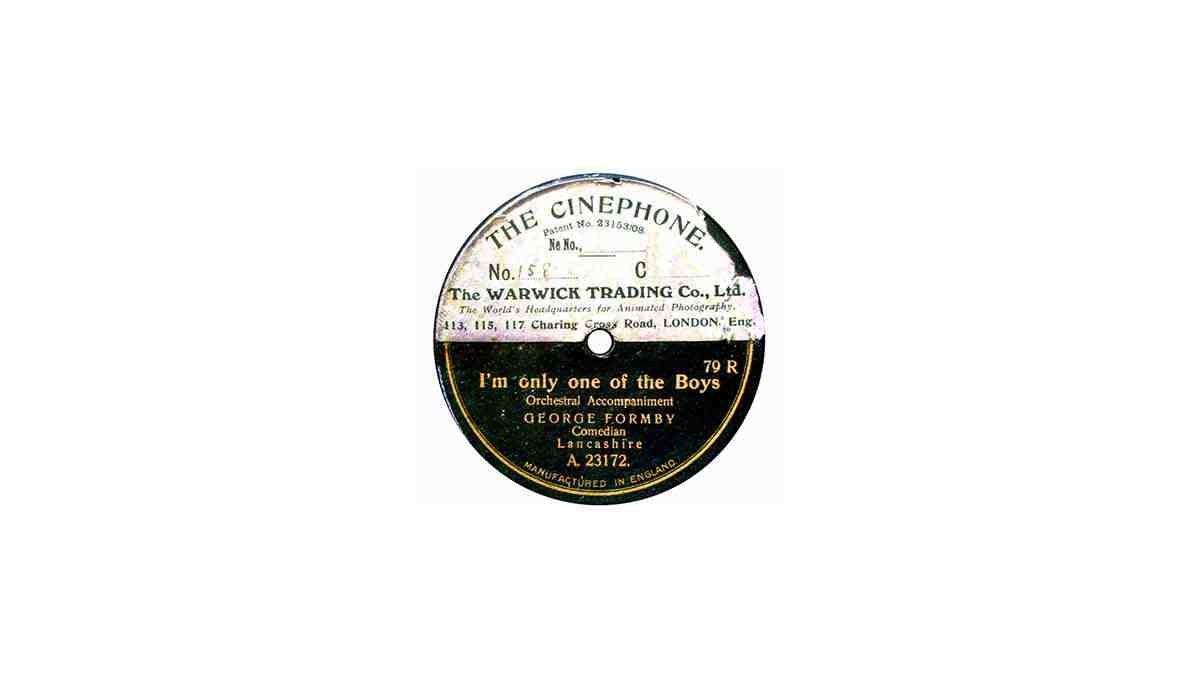
Citizen
See Frank Andrews, HD 224. There are two incarnations of ‘Citizen’. The 3000 series was first. There are only about fifty-odd issues, derived from Guardsman. They date from 1916, and, like Guardsman, were pressed by Crystalate. How long they were in production is not known, even to Frank. A year or so, perhaps? The other series, with an almost identical label, began at 501 about 1920, and ran to nearly 900 by perhaps 1927. These were first drawn from Guardsman as before; but in 1922 The Invicta Record Co. (Guardsman) was bought up by The Aeolian Co. (‘Vocalion’). So production switched (in the mid-600 catalogue numbers) to the Hayes factory of The Universal Music Co., the manufacturing wing of Aeolian, often loosely called Vocalion. They drew from its Aco repertoire. The ‘Maritana Fantasie’ above is by the Central Band of the Royal Air Force. ‘Charlie My Boy’ is by Ben Selvin from U.S. Vocalion. From this point, i.e. after about 650, Citizen Records were distributed by a firm in Liverpool, and it is widely thought they were sold on the door-to-door ‘tallyman’ system. That is, the customer was given a gramophone, and provided they bought a number of Citizen records on a regular basis, say for a year or more, the gramophone finally became theirs, ‘free’. Evidence for this lies in the fact that when these Citizen discs turn up – which is not very often! – it is usually in the north of England, and there is a quantity of them together. The John Bull label of 1910-1913 was the most successful tallyman label. Those were sold by the English Record Company, and I find it quite odd that ERCO – as on Citizen 856 above – is an acronym of ‘English Record COmpany. Coincidence – or something more sinister? 8^)
Clarion
See Len Watts and Frank Andrews, HD 108, 1979. Clarion records were the product of The Premier Manufacturing Co., Ltd., an important producer of cylinder records. Indeed, they have the distinction of being the last producer of cylinders in this country in the old days. Begun in 1907, the company did not imperceptibly fade away until late 1922 or even early 1923. Their discs are quite scarce; there can be few makers whose cylinders remain to this day, less rare than their discs! The 1000 series came first, vertical cut, in late 1908. The 100 series were lateral cut and appeared from 1915 just into 1918. (They also had another fine-pitch vertically cut disc called Ebonoid in late 1909.) It is remarkable that this company was able to maintain the high-quality printing of their beautiful Art Nouveau style. Elsewhere on this page may be seen extremely slipshod Wartime Austerity printing, and grotty rubber-stamped & even hand-written examples of makeshift ‘emergency labels’. Most likely Clarion had had a large number of untitled labels printed in 1908, so were able to use them for the later 100 series laterals? And at 1/6d (7.5p) Clarion discs were not expensive either.
Another interesting feature of Clarion phono-cut discs are the take symbols appearing on them. The above five below are pretty widely known as the ‘Edison Bell’ take symbols, and were used on EB cylinders and discs from the earliest times until the late 1920s. However, they were quite possibly devised by the Recording Expert C.R. Johnstone (1862-1933) during the period he worked for EB. But in 1907, he and others defected from EB and were involved in the founding of Premier/Clarion. Therefore Johnstone presumably continued to use his own take symbols? These are even die-stamped, whereas they were only hand-inscribed on Edison Bell cylinders and discs. They also appear under the labels of Marathon records (1913) hand-written, q.v.
Cleopatra
See Frank Andrews, HD224, 1998/99. This trade mark was granted to Joseph Leonard Blum in 1913. He already had Stella, Victory, Diploma and Pioneer records. In 1916 the name was taken over by the Columbia Graphophone Co. and was renewed by them in 1926. Yet Frank knows of no discs ever produced which bear the name. Perhaps Cleopatra records were marketed by Columbia elsewhere in the world?
Climax
See Frank Andrews’ introduction to his book: ‘Columbia 10″ Records 1904-1930’. Unfortunately, it is currently out of print, but a reprint is contemplated by the CLPGS. Columbia had a presence in the U.K. from May 1900, selling their Graphophones (cylinder phonographs) and cylinders. Early in 1902, in the U.S., they took over the Globe Record Co. and its Climax records. (This Globe label is not to be confused with the German label of the same name.) Climax records in 7″ and 10″ single sided format were sold here during 1902, the name being changed to Columbia late that year. Very scarce. Note the brass inserts to strengthen the centre hole. In the wax of 126 there is a cartouche with the letters ‘VTM’. This stands for Victor Talking Machine (Co.), and reflects the often very complicated rivalries and litigation between early record manufacturers. That Climax disc must have been made under some arrangement with VTM, almost certainly a patent issue – we must read it up! Later, there was an accommodation between Victor and Columbia, in which they cross-licenced certain patents. This ‘duopoly’ meant that no other company was supposed to manufacture lateral cut discs. Some did so, however, and many legal battles ensued until around 1918/19.
In July 2020, Roger Mackey wrote, saying: “According to my American contacts, Victor bought a pressing plant from Columbia in 1901 and had all the Climax matrices smuggled out. The records were then pressed by Victor, who stamped them with the “VTM” cartouche. Victor then used these records as leverage to arrange a cross licensing agreement with Columbia before selling the pressing plant back to them. Sneaky or what?”
Coliseum
See Frank Andrews, HD 225, 1999. That modest reference is to Frank’s mammoth 9-page article on Coliseum, which must be read for full appreciation. All we can say here is that Coliseum records were first advertised in March 1912, and from June that year were distributed by the firm of Cooper Brothers, Clerkenwell Road, London EC. They were produced in Germany by Beka, using mostly Beka masters, but some others also from Lindström, to whom Beka already belonged. The catalogue numbers began at 101, and the records cost 1/6d (7.5p) which made them, along with their companion label Scala, the cheapest on the market at that time. Accordingly, they sold in droves and are often found today. 12″ discs appeared too. Pressing was eventually carried out at the new Lindström/Fonitipia factory in Hertford. The letters ‘SF’ on the label signify ‘Silk Faced’ – presumably a dig at Edison Bell’s ‘Velvet Face’ label; however, both were variable in that respect! The F-544 above was a kind of ‘celebrity issue’ for Billy Williams; it came from Odeon/Jumbo masters – the F- prefix presumably stands for Fonitipia, and also signified a higher price of 2/6 (12.5p) rather than 1/6 (7.5p). The meaning of the R- prefix is not known to me. The red, white and blue label is part of a Patriotic issue of c. 1915. In August 1916 the Lindström & Fonitipia companies were put into compulsory liquidation (because of the German connection) and their factory taken over. Coliseum records were still made there, but under a new British-owned regime. They continued to sell well, and had attained cat. no. 1156 in early February 1920. A reorganization then took place; Coliseum and Scala became almost identical twins, with shared catalogue numbers starting at 1200, but with differing artiste credits. Frank is fairly certain these new discs were pressed by Crystalate, and masters were drawn from the Invicta Record Co.’s Guardsman repertoire, which by now also included plates from U.S. Gennett. However, the Invicta Record Co. was taken over by Aeolian in 1922, and subsequent Coliseums were pressed by Aeolian’s manufacturing wing at Hayes, Middx. These had the new two-tone blue label, first without, then with, a bottom border. The label continued quite successfully, with a later colour change, until 1927. Catalogue numbers about 1000 – 1100 date from ~1917 – 1919. The improbable ‘Vugarishe Rhapsody’ by the equally improbable ‘Mononovitch’ on 1477 (ca.1922) is from German Anker. It actually is Liszt’s Hungarian Rhapsody No.2, thought to be by the Dutch pianist Gerritt Van Weezel (1882-1942). The 12″ issues are very elusive.
Colonial, Colonial Perophone
See Frank Andrews, HD 226, 1999. The distinctive ‘L’ trade mark signifies Messrs. Lockwood, the London distributor. They were first advertised in October 1910. ‘Perophone’ was soon added to the name; this was a line of gramophones also handled by Lockwoods. The label tells us that these discs were not for sale in the U.K. They were pressed in Germany by Homophon. Presumably they were exported to selected parts of the British Empire. The dates encoded on 470 are 6th January 1912 and 12th March 1912, which indicates a life of at least 18 months for the label. (For an explanation & discussion of these dates helpfully included on Homophone products, see homophone.htm ) To say they are hard to find would be fatuous, as theoretically, none of them are really supposed to be in the U.K. anyway!
Columbia
A major listing and history of the 10″ ‘popular’ issues on this label appeared in the book ‘Columbia 10″ Records 1904 – 1930’ by Frank Andrews. Alas, it is currently out of print, but the CLPGS are intending to reprint it.
The first appearance of Columbia discs in the U.K. was fleeting. In 1898/99, toy gramophones made by the Columbia Phonograph Co, were imported from the U.S.A. They came with five discs, which were vertically cut, and pressed in wax. There was no motor; a little handle wound the turntable directly. One importer was the firm of Burrows & Co., in Manchester. Unfortunately, the Edison Bell Consolidated Phonograph Company Ltd. had sole rights to sell both Columbia and Edison products in the UK. It is not known whether the E.B.C. took action against Burrows, but the machines are ‘Hellish Rare’, as Michael Wyler used to say.
A very important major label, which continued for many decades after these early issues. As in the case of The Gramophone Company (HMV), it is impossible to give even an outline of the history of this company; but information can freely be found on-line, and in the book above – if you can locate or borrow a copy, pending the reprint. In spite of its best efforts, Columbia was always the second-best label to ‘Mighty HMV’ in terms of prestige; but during the 1920s, Columbia discs consistently outsold HMV in quantity! Early Columbia recording quality and pressings were generally very good, and certainly the equal – sometimes better than – their deadly rival. Initially, at first, the discs were pressed in the U.S. and imported here. I do not know the extent of the imports; some U.S. discs may be shown, that were never sold here. Columbia 49 above is interesting in having a trilingual label, presumably enabling it to be sold in the U.S. & the U.K., and also in France and Germany? Most of the later examples above are from the popular series, which began at 1, or rather D-1, in 1907, and continued far after our time-period, ending at 5740 in 1930. With long-lived labels such as this, it is important to remember that items could stay in catalogue for many years, and so be found on successive label designs, e.g. 1477, see here with a ~1920 label, would originally have carried a ‘Rena Double Face’ label: see under Rena. (1477 was a great survivor: it was electrically re-made (in a slightly different form) in June 1926…) The label of 26588 is probably unique among single-sided records, in that it actually proclaims that it only has one side! The reason for this was doubtless the fact that Columbia had actually made double-sided records as early as 1904; but had ceased doing so because double-sided records had been patented by Petit & Prescott that year.
Comet
See Frank Andrews, HD 226, 1999. Comet records were made by an unknown proprietor or dealer by sticking a full ‘Comet’ label over discs bought in for the purpose – usually deletions, or perhaps bankrupt stock. Winners and Imperials are known with Comet stickers. Dating is difficult, but Imperial did not appear until late 1922; but the overstuck Winners might be much earlier. The two extra holes in the label have undoubtedly been made in order to amuse children on a rainy Sunday afternoon: using an offset hole would produce a frightful ‘wow’ in the music; the one at lower right, being further away from the proper centre-hole, would make an even greater cacophony. Whilst freely admitting that ‘those were simpler times’, we can only deplore the fact that so rare a disc was chosen for such mutilation!
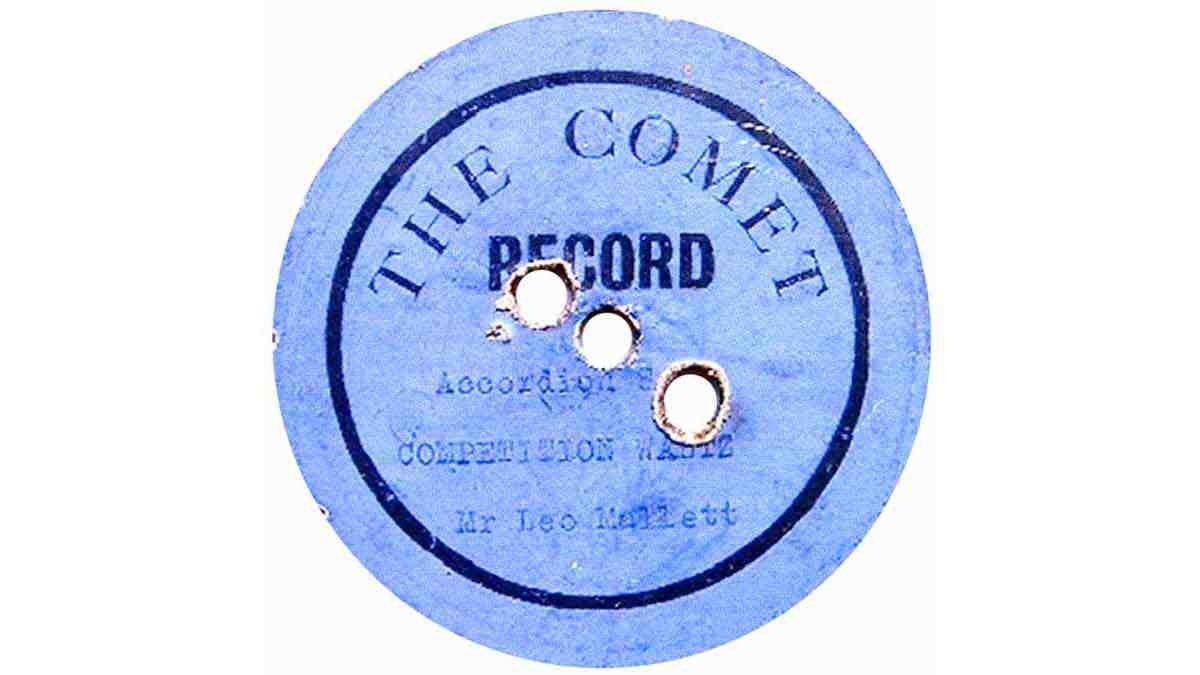
Concert
See Frank Andrews, HD 226, 1999. Concert records were made in the U.S., and were kin to U.S. Imperial. They were 10″, single sided and date from 1906. Imports of both of them were made and advertised in the trade press. However, after only 2 months the advert. for Concert Records ceased leaving only the Imperials still being offered. Frank is pretty certain that the Gramophone Company, whose 10″ discs were then called ‘Gramophone Concert Record’, took steps to prevent the sale of Concert discs. What happened to the residual stock is unknown. It goes without saying that the label must be excessively rare.
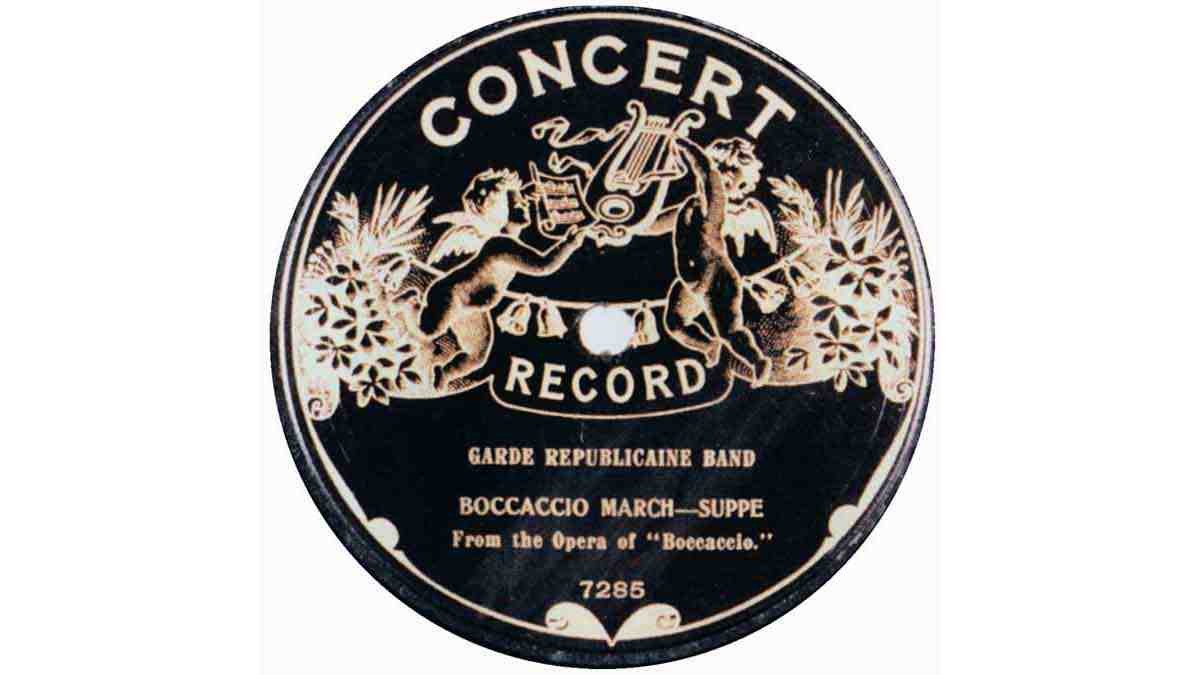
Conqueror, Conqueror Regent
See Frank Andrews, BRI; HD 226, 1999; Michael Kinnear, NR. Very scarce indeed, and even Frank Andrews describes them as ‘..of indeterminate date’. A ball-park figure would be 1907 – 1910, probably inclining towards the earlier years. They were pressed by the Disc Record Company of Stockport, which had been set up by a former director of Nicole, John Watson Hawd. He had bought up the masters, pressing plant &c. when Nicole folded in 1906. The DRC pressings often carry ‘MADE IN ENGLAND’ in an arc, between the label and the groove. This is not to be confused with a similar stamp used in the early and mid-1920s by the Aeolian Company (Vocalion); that lettering is smaller, and the DRC had been defunct for 5 years by 1920. These early DRC products are pretty shoddy. No catalogue numbers, ham-fisted typography and usually no artiste credit. The ‘Bridal March’ originally appeared – credited to The British Imperial Military Band – on single-sided Nicole 4589. The client for whom they were pressed was probably Leon Liebowich, whose trading name was ‘Regent Fittings’ – he had a number of labels made for him such as Pickofall (strictly speaking ‘Pickofall Record – Regent’), Playwell-Regent and Fortune (Regent); so the incorporation of ‘Regent’ is highly likely to indicate Leibowich. The violet labeled disc carries two titles associated with Billy Williams; ‘I Must Go Home Tonight’ should be from Nicole. If so it must be a cover version, as Williams never recorded for Nicole. It’s a good ‘cover’ for all that. But the side above, labeled ‘Old Grey Coat’, is by a different artiste, and worse still, is not ‘Old Grey Coat’ but another song altogether without any Billy Williams slant! Such were the vagaries of the early British record industry…
Conquest
See Frank Andrews & Arthur Badrock, TMR 68, 1984; also Frank Andrews, HD185, April 1992, p 14. A series of 6″ diameter masters were recorded during 1926 by The Gramophone Co. (= HMV). These had been commissioned by British Homophone, for use on a number of micro-discs: Homo-Baby, Sterno-Baby, Dixy, Jolly Boys and Conquest. The first two were obviously intended for Homophone itself; Sterno was trade name based on Sternberg, the name of the boss of Homophone. The last three were for other clients. Who took the Dixy and Jolly Boys is not known, but Conquest was intended for Woolworths stores. They were one of the biggest retailers of the time, and to supply them with records would surely have been a triumph for Homophone. However, only one Conquest disc seems to have been produced. What went wrong? Since mid-1925, HMV had been using the new Western Electric recording system. Under WE’s licence, a royalty of one penny per record was payable to WE. This would be naturally be passed on to any client, such as Homophone. However, since these small discs were to be sold very cheaply (the maximum price of anything in Woolworths was sixpence), one penny per disc was an intolerable overhead. Therefore, Sternberg had got HMV to make them by the now-obsolete mechanical (acoustic) process. We conjecture that Woolworths had been expecting electrically recorded Conquests, not ‘old-fashioned’ ones, so they did not go ahead with the deal.
Coronet
See Frank Andrews, HD 226, 1999. Music publishers Curwen & Sons Ltd., of Berners Street, London W, had these made and announced 100 of them in January 1917, to retail at 1/6d (7.5p) each. They were drawn from the repertoire of the Guardsman label, and, as usual at the time, pressed by Crystalate. Alas, the name ‘Coronet’ was already a registered trade mark for gramophones, records &c., and belonged to the Pathé concern. Coronet records therefore had to be withdrawn. Frank tells us this had occurred by March 1917, leaving open the question of how many Coronets had ‘got out’ since January. Perhaps none; perhaps a few. Who knows? Undaunted however, Curwen repeated the exercise, calling their label this time ‘Neptune’.
Criterion
See Frank Andrews, HD 226. The first example is straightforward enough. The Sound Recording Company disposed of surplus stock, in this case their Popular label. They also disposed of surplus of their main label, Grammavox, in the same way. The buyer (whoever they were) affixed the small label with their new name. Usually, this was ‘Butterfly’ and was red; but very occasionally, a blue ‘Criterion’ sticker is to be found, as here. The second example is extremely strange. It is certainly a legitimate issue, as it carries a copyright royalty stamp. This, by the way, enables us to calculate the original selling price of this un-numbered issue: it was half-a-crown, or 2/6d (12.5p). This might seem a lot for such an unprepossessing hybrid – one might even call it a monstrosity! – but ‘Whispering’ was a smash hit of 1920, and there was much disarray in the record industry following the end of the war in 1918. Record prices had risen steeply during the conflict, and were slow to decline afterwards. Originally, it was almost certainly a Crystalate product; the plain ‘sugar bag blue’ label is in fact the reverse of a Guardsman label, as you can see. 788 dates from early 1918, and Guardsman records were pressed by Crystalate at that time. Evidently Crystalate – or somebody – have utilised surplus labels because the reverse of one is a circular piece of blank paper with a hole in the middle. The only thing we cannot tell you, alas, is (a) whether they were actually pressed into a 78 or just pasted over something else; and (b) if the latter, what it was. We only have the loose label. Perhaps more space has been given to this single disc (or half a disc, to be strictly accurate) than it actually merits? In defence, I can only state that in over half a century spent dabbling with ‘old records’, this is one of the weirder items I have seen. Frank Andrews knows of them on reversed ‘Popular’ and ‘Ye Popular’ record labels as well – all Crystalate pressings, by the way.
Crown
See Frank Andrews, HD 226. Frank tells us that these scarce discs were the product of the Polyphon Musikwerke A.G. of Leipzig, Saxony. They were never advertised in the trade press, and this often indicates a label sold by the ‘tallyman’ system (see John Bull and Meloto for explanation). As to date, Frank suggests 1911, possibly up until the Great War started in August 1914, when the ‘Pressed in Saxony’ on their label would have rendered them unsaleable. Notwithstanding that, Lockwoods, the musical factors, offered a job lot of Crown records in June 1916. One wonders who might have bought them, and what was the subsequent fate of the records.
Crown Perfect
See Arthur Badrock, TMR 102, 2000. Arthur tells us, in his ‘Junkshoppers’ Column’, of early single-sided Columbia discs over-stuck with a label bearing the name Crown in large type, under which appears ‘Perfect Record’, and Selfridges – the London department store. The label has a slot cut out of it, to reveal the title and artiste (sometimes just the title) on the original Columbia label underneath. The discs were recorded not later than 1905. Frank Andrews informed Arthur that single-sided Columbia were all deleted in 1908, so we may surmise that Selfridges bought some – or all – of the remaining stocks and stuck their own labels on them. Seven examples turned up together, but Arthur had never seen one before, thus making this label exceptionally scarce. Mike Thomas kindly furnished one example, which actually came from the collection of the late Arthur Badrock. Also, thanks to Ray Stephenson, we can also show another type, which differs by having only a ‘half-label’. Thus, Selfridge’s are not mentioned, and the disc actually displays not only the original Columbia catalogue number, but also the rightful maker. Obviously, we wonder which sort came first? Well, many early single-sided Columbias carried a ‘back sticker’ – a printed label listing patent numbers, resale price maintenance &c. (one type of these – there were several versions – may be seen under Columbia, above). Mike reports that the ‘back sticker’ on one of his discs has been covered up with black paper. This must have been tedious, not to mention the cutting out of variously-shaped slots in the full Crown Perfect label. Accordingly, it is suggested that this ‘fiddly’ procedure was employed first; and that later, Selfridges abandoned it, settling for the half-label, either with or without the approval of Columbia. (26710 has no ‘back sticker’ anyway; its use was eventually abandoned by Columbia – another indicator that the half label is later?)
Curry's
See Frank Andrews, HD 182. 1991. These ‘Curry’ and ‘Curry’s’ records illustrate a largely forgotten aspect of the early British Gramophone Trade: viz., the ‘Gramophone and Bicycle Shop’. They made excellent partners, for both trades were very seasonable. Those who could afford to do so, purchased bicycles in the summer, and phonographs, gramophones and records in the winter months; especially when the price of the machines and discs crashed after about 1910, progressively to 1914. Curry’s was probably the first ‘chain’ of these shops; they already had ‘Depots in Many Towns’ as early as 1910, when the first series of discs above, drawn from Edison Bell ‘Bell Disc’ appeared. The first yellow label issues are derived from Guardsman. The last two discs date from about 1924, and the first bears a Grammavox master dating from about October 1913. And the rest is history. A century later, the nationwide chain of Curry’s Discount Warehouses stand in the forefront, everywhere! “The U.K.’s Foremost Electrical Retailer” is their byline. There was evidently money – lots of it – to be made from bicycles and records, as long as you managed the business well. Later they had other labels, called Portland and Westport. They seem to have abandoned records by about 1930; but that is beyond the scope of these pages.
Cymot
This is manifestly a ‘sister label’ of Adelphi, having the same label design. They were pressed at Hayes by ‘Vocalion’, probably in 1924. Dr. Rainer Lotz kindly contributed the first image, 861. The control number G-477 helps us to identify it as a British ACO recording of late 1923, apparently unissued on ACO, though it did appear on Guardsman 1425, and quite possibly other related labels. The master number is C-6101. In short, we know quite a lot about the manufacturer of the disc, and the material it bears. What we don’t know for certain, is who retailed them. The prime suspect must be Cymot Ltd., of Cape Town, South Africa. Cymot Ltd. was incorporated on August 10, 1922, to acquire the business carried on by the CYcle and MOTor Trade Supply Co., which had commenced business twenty years earlier. Recently (2017) Steve Paget found a Cymot, 623 above, in South Africa, so it’s virtually certain that this was a British product, manufactured for Cymot Ltd. The only disquieting thing, is the catalogue numbers. Where did they start? 623 to 861 implies, at the least, two hundred and thirty-eight issues. Again we ask: where have they all gone?
